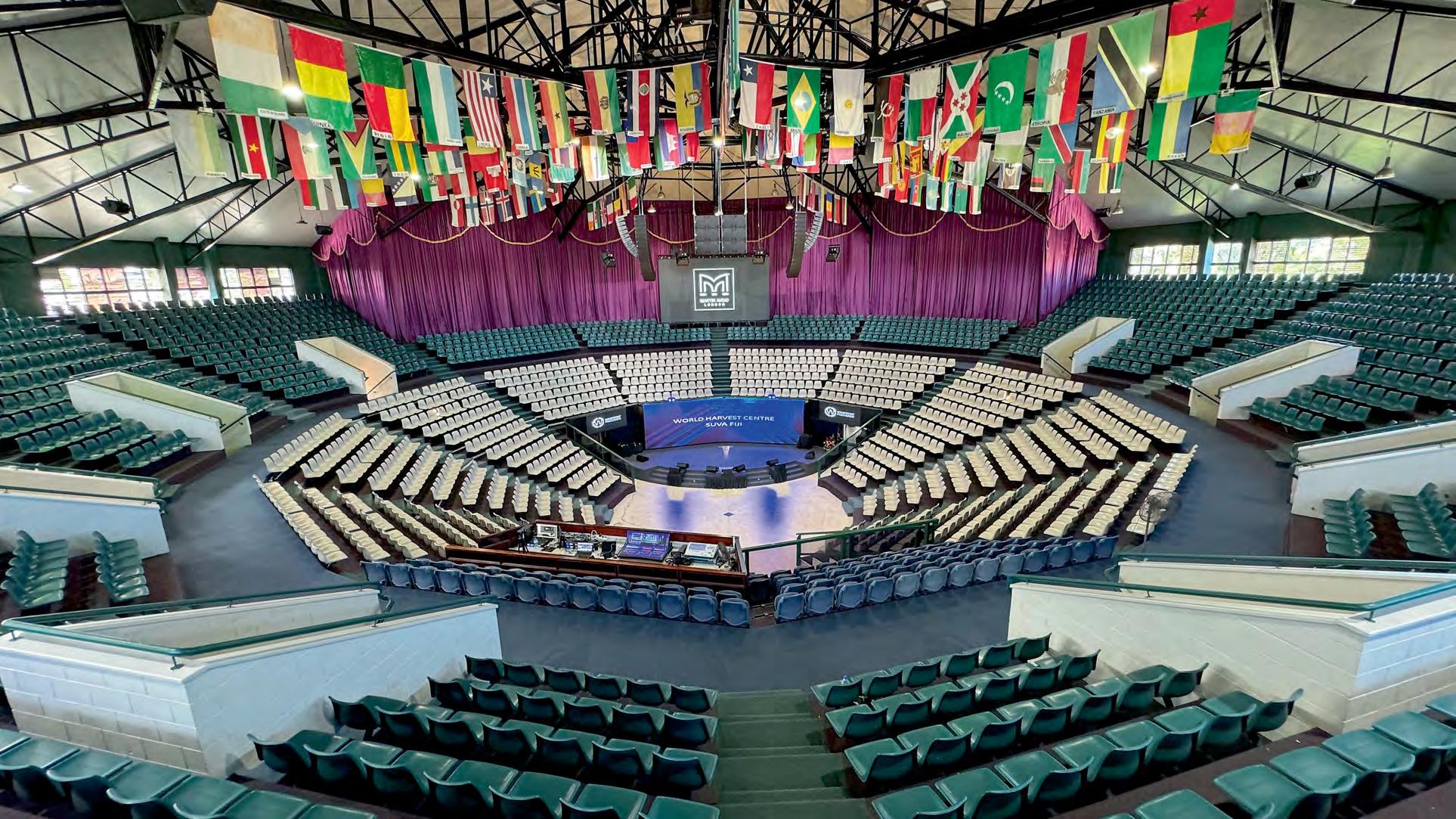


EVEN QUIETER THAN OUR COMPETITORS’ REACTION. EVEN QUIETER THAN OUR COMPETITORS’ REACTION.
POWERSOFT.COM DANTE EMBEDDED MORE INFO AV LIGHTING SOUND REINFORCEMENT RECORDING STAGE SOUND BROADCAST July–August 2024 BEST MIC FOR THE PREACHER AUTOMATED LIGHTING World Harvest Centre, Fiji Singapore: MICA (P) 060/04/2024 PPS 1644/05/2013(022954) CROSSING SEAS
Modular system for customized infrastructure solutions
Wide range of modules for fully networked media technology concepts
Classified cable-bulkware according to EU Construction Products regulation (EU CPR)
Ready made Network and Fiber Optic Systems for mobile and installation applications

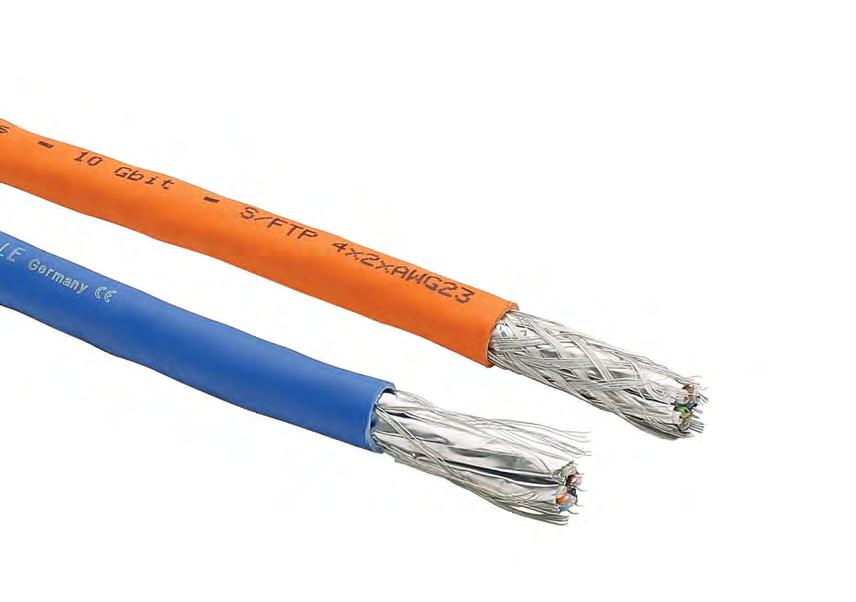

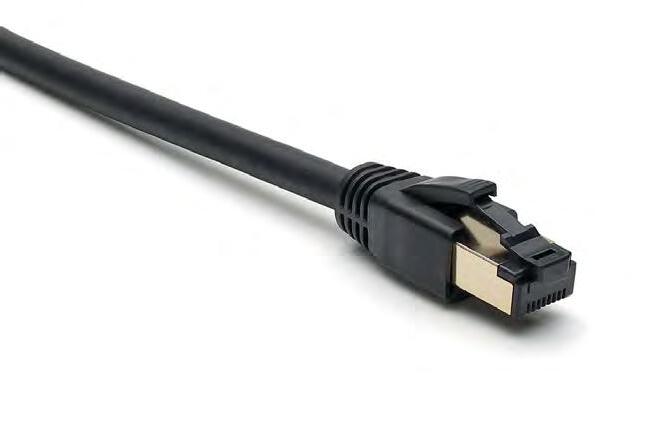














SOMMER CABLE based in Straubenhardt/Germany was founded in 1999 and is now one of the leading suppliers of professional high-quality cable and connection technology with a focus on the audio, video, broadcast, studio and media technology sectors. The product range including the in-house brands HICON, CARDINAL DVM and SYSBOXX covers cable bulkware, connectors, connection cables, individually adaptable distribution systems and electronics. A B2B shop with over 25,000 products is available 24/7.
Installation & Conference Broadcast Solutions Professional Studio Event Technology x01735
Booth C9041 Las Vegas, Nevada, USA
12th
14th 2024 BULK CABLE · CONNECTORS CATALOG FOR FREE · ORDER NOW! www.sommercable.com • info@sommercable.com
June
to
- GO! CPR-rated CAT.7 & CAT.8 installation and connection cables High-quality, certified connection components
ON YOUR MARKDATA
I had a great day out at the Media Production & Technology Show in London a couple of weeks ago. The show is geared towards the media and entertainment industry but, as larger houses of worship increase the production elements of their weekly services, the technology on display is becoming as relevant to this market as it is to a music festival, broadcast studio or postproduction suite. Remote production is one topic that’s developing rapidly at the moment, with companies now offering fully cloud-based production solutions. On page 40, John Porterfield reports from NAB where he witnessed the growth of PTZs being used to

You can also find reports on two upcoming events in the industry: AV Expo in Harare, Zimbabwe on 26 and 27 June (p.8); and the Church Sound & Media Summit in Nottingham on 27 and 28 September (p.38).
As the result of some meticulous planning, the World Harvest Centre in Fiji has taken delivery of a Martin Audio WPM line array system for its 3,500-seat auditorium. With everything carefully wrapped, packed and shipped from Australia, nothing could go unchecked, not even the smallest rigging nuts and bolts (p.28).
I hope you enjoy the issue.
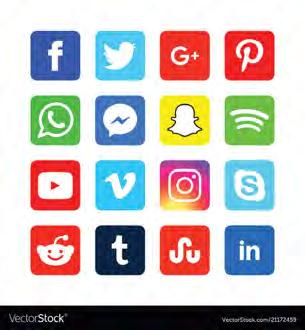
Email: kwallace@worshipavl.com




Richard Lawn General manager rlawn@worshipavl.com
Bea Meikle News editor bmeikle@worshipavl.com
PUBLISHED BY:
Sue Gould Advertising director sgould@worshipavl.com
Nick Smith Digital media manager nsmith@worshipavl.com
July–August 2024






All rights reserved. No part of this magazine may be reproduced or transmitted in any form or by any means, electronic or mechanical, including photocopying, recording or by any information storage and retrieval system, without prior permission in writing from the copyright owners. Follow us on social media @WorshipAVLMagazine
Carolyn Valliere Sales associate cvalliere@worshipavl.com
Chris Yardley Video editor cyardley@worshipavl.com
Spa House, 18 Upper Grosvenor Road, Tunbridge Wells, Kent TN1 2EP, United Kingdom
Tel: +44 (0) 1892 676280 Web: www.worshipavl.com
Caroline Moss Contributing editor cmoss@worshipavl.com
Adrian
Michelle Mooney Deputy editor mmooney@worshipavl.com
Marne Mittelmann Circulation manager circulation@worshipavl.com
LICENCES: Singapore: MICA (P) 060/04/2024 PPS 1644/05/2013(022954)
CIRCULATION: circulation@worshipavl.com
July–August 2024 WORSHIP AVL 3
Contents
Contact us
Issue 87
Baker Production manager abaker@worshipavl.com
Simon Luckhurst Contributing editor sluckhurst@worshipavl.com Jack Stennulat Digital content creator jstennulat@worshipavl.com COVER: World Harvest Centre PRINTER: Times Printers Singapore COMMENT TECH VIEW 14 Church Unlimited 16 Fellowship Church 18 Basílica del Voto Nacional 20 Grace Community Church 22 Elevation Church 24 Saifee Masjid 28 World Harvest Centre 32 Choosing the best mic for the preacher 34 How long should my online service be? 36 Using colour to set mood 4 Robert Soo 6 Don Boomer 10 Aimed 8 Zimbabwe’s AV Expo 58 The Table podcast SHOW REVIEW 38 Church Sound & Media Summit 40 NAB
45 The industry’s latest product news NEW PRODUCTS 4 18 24 36 38 58 KNOWHOW COMPANY PROFILE SPECIAL REPORT PROJECTS TECHNOLOGY 42 Automated lighting
Editor’s Letter
Because everyone matters

the worship team and the ways we can best support them to perform at their optimum. Now we move onto the next group, the unsung heroes behind every church service – the AV crew – a remarkable community of people in whom I have a special interest. Through my years serving as the technical director of a large Baptist church, it has helped me appreciate the commitment and hard work these people put in, as well as the struggles they face. As such, this article is dedicated to them.
During the early years, the AV crew was mainly known as the PA team, as sound systems have been an integral part of church worship services for decades, but not so for video and especially stage lighting, as requirements were few and deemed unnecessary back then. Overhead projectors – and later followed by video projectors – met most of the visual needs, and house lighting sufficed in providing the needed illumination onstage. All that changed dramatically with the pandemic and AV ministries had to quickly rise to the occasion as production houses to stream live or recorded worship services every week, from which
Finding new help has always been a perpetual uphill task, especially people with the right aptitude for AV work, writes Robert Soo

always a challenge
budget, equipment and room facilities, it also puts a further strain on existing AV volunteers who have to put in extra hours each week. This calls for an urgent recruitment drive for more manpower, but finding new help has always been a perpetual uphill task, expecially for people with the right aptitude for AV work
mix demands different techniques and composition to suit each listening environment and condition.
With such technical challenges, training and upgrading for the AV crew in sound production, video production and videography, as well as in production lighting should always be an ongoing programme. For any
element of art. From sound mixing to operating cameras, visual mixing to lighting, it takes a team who is not only tech-savvy and knowledgeable in their equipment but are also artistic craftsmen who can bring about an immersive and engaging audiovisual experience for both onsite and online worshippers.

4 WORSHIP AVL July–August 2024
COMMENT
Recruiting AV team volunteers is
The unsung heroes behind a church worship service
As the drivers managing the overall worship experience in every service, it is important that the AV crew operates from a strategic location within the sanctuary, one where they’re able to assess and react quickly and accurately to every AV situation. Particularly for the sound mixer, it is imperative that it gets located in a spot that receives a similar aural experience as the congregation. It is unfortunate that many churches choose to relegate the sound mix position to a room at the back or to an upper floor that receives no proper coverage from the front-of-house loudspeakers. The convenient “solution” of providing nearfield monitors just isn’t the same as there is such a vast difference in sound and acoustic representation that results in the sound operator making errors in assessment and executing the wrong mix balance and tone. Just like any tech job, the AV crew needs the right tools to do the job right. For most people, it would mean having good mixing consoles, video mixers, video cameras and lighting controllers to work with, and rightly so as these are critical first-level equipment needed to support AVL functions. But there are other seemingly lesser tools

that are actually essential that I often encourage churches to equip their tech crew with, such as an SPL meter, monitoring headphones, light and colour temperature meters, multi-tools, and AV cable, circuit and battery testers. Even stationary and basic repair items like a marker pen, gaffer tape, cable ties and a soldering iron are all important, as these are extremely handy during system setups and especially in troubleshooting. It is no surprise that the efficiency and effectiveness of the tech crew can sometimes be



limited by the lack of such lifesaving provisions.
One could almost draw a comparison between serving behind the scenes as an AV volunteer to how a Priest or a Levite prepares the temple for worship, and oftentimes it can be a tiring, stressful and thankless job. I recall the days when I was running the tech department back in my former church – our crew will arrive more than an hour before the first service starts to ensure all systems are good to go, stays on to support the next few services and
leaves only after everyone has left the sanctuary. It was also a running joke among us (and internationally) that a successful Sunday is one where there are no complaints about the AV delivery. Strange as it may seems, the crew even receives complaints about the airconditioning system and elevators. Over time, we do see AV volunteers getting burned out from serving, so it is always good for the church leadership to periodically touch base with the AV team members, to provide a listening ear, to give encouragement and support, and to pray with them. They can also help drive recruitment during service announcements by reaching out and challenging members to serve in the AV ministry. This would mean a lot to the existing volunteers and provide the much-needed recharging to keep them going each week.
I’ve got many more “war stories” to share but I’ll leave those for another day. I hope this short article has at least helped us catch a glimpse of the AV teams “behind the scenes”, their needs and struggles, and how we can all better support them to excel and succeed in their roles. Do look out for my next article but, till then, take care and God Bless.


July–August 2024 WORSHIP AVL 5 COMMENT Dante™ digital and analog line-level inputs 2 stereo transmissions in 1/2 rack unit Phenomenal Stereo Imaging 470 - 614 MHz tuning range NEW, improved M2Ra US Made Lectrosonics quality IEM STEREO TRUE TRUE STEREO IEM For Your Next Stage For Your Next Stage USA 1-800-821-1121 In Asia +855(16) 201 280 In Canada, call 877-753-2876 In Europe, call +33 (0) 78558 3735 In South America, call +57 310799 4564
The complex task of handling both live and online worship services
Active and passive antennas
Don Boomer considers that when it comes to antennas, less is better than more
MOST USERS INCORRECTLY
believe that active sounds better than passive and more sounds better than less. But with radios, most often, the exact opposite is true. Active antennas are merely passive antennas that have built-in amplifiers intended to make up for loss from long coax runs. Contrary to what some may think, they do not extend range.
There is no difference between the antenna element of an active or passive antenna of the same type; the only difference is whether an amplifier is included. While some active antennas provide for switchable gain, for the most part, their amplifiers are always active. This means additional noise and distortion, although small, will always be added. When using an amplified antenna, avoid being close to the antenna as the higher signal level from being near produces more IMD inside the amplifier itself. They are best used when the transmitter is far away from the antenna.
Even when the gain is set to zero, most active antennas are
the signal will be lower, reducing the IMD generation.
The only practical reason to use an active antenna is to compensate for cable loss in receive applications. All RF signal
If there is any question, your best bet is to start with a passive antenna and simply add an in-line amp if necessary “ ”
still running the signal through the amp which means noise and distortion are still being added. Active antennas and/or in-line amps should only be used as a last resort to mitigate extreme coax line losses.
Usually, a better choice is to use higher-quality, lower-loss coax. If there is any question, your best bet is to start with a passive antenna and simply add an in-line amp if necessary. If using an amplifier is absolutely necessary, use it at the receiver end where
loses strength (attenuates) as it passes through coaxial cable. The longer the cable run, the larger the loss. Around 30m of RG8X will lose about 8dB, depending on frequency. The amps on active antennas are designed to compensate for this loss by boosting the signal right behind the antenna before sending it down the line, so the gain at the receiver is closer to unity gain. It is important to note that active receive antennas do not increase directional gain, which is another
way of saying that the amplifier has no effect on the electrical characteristics of the antenna, and therefore no effect on an antenna’s fundamental ability to pick up RF energy floating through the air.
If you use active antennas on a coax run that is too short, you risk overloading the RF front end of the receiver system, which can manifest itself as catastrophic audio over your PA. Likewise, you can easily overload by using an active antenna’s gain control at a setting that is disproportionally strong for the cable run’s length. UHF cable runs of less than 15m do not require active antennas or in-line amplification to compensate for loss. The loss is too small to make any audible difference –without carefully calibrating gain structure, you put the overall health of your audio ecosystem at risk. Also, keep in mind that if you’re using a directional antenna, you’re adding gain at the antenna (without an amplifier) which can make up for short run cable loss. All too often, a church system will be using an active antenna at
the side of a stage with a +12dB amplifier on a 8–15m run. This gain is in addition to the +6dB of gain the paddle antenna itself imparts. With their transmitters at 30–50mW, the front end of the wireless receiver gets overloaded, causing all kinds of problems. It’s always better to use passive antennas, and then only add in-line amplifiers to make up for transmission line loss if there are very long cable runs of more than 30m.
With the introduction of low-cost RFoF technology, active antennas and in-line amplification are becoming increasingly obsolete. In the past, if an installed system required a cable run over 30m, there were only two options: use a large diameter coax (such as Belden 9913f) or use some combination of active antennas or in-line amps and carefully manage the gain structure to avoid overload or coax line loss. With fibre-optic transmission, a signal can be sent miles with little to no loss at all.
6 WORSHIP AVL July–August 2024
www.rfvenue.com COMMENT
No amplifier PASSIVE ANTENNA ACTIVE ANTENNA Integrated amplifier Same antenna element How to tell the difference between passive and active antennas It’s that simple

Hear what happens when our lightest, most powerful line array is paired with the subwoofer that sets the standard for the best lows in the business. You’ll have to hear it to believe it.
meyersound.com/perfectpair
An unparalleled pair.
AV Expo brings the HOW industry to Zimbabwe
Music, education, technology and faith will come to life at Zimbabwe’s AV Expo on 26 and 27 June at the Harare Showground – founder Mbaki Nleya shares the inspiration behind the event
What is AV Expo and why should people attend?
AV Expo is an annual trade event for advanced media and entertainment technologies held in Harare, Zimbabwe. It highlights innovative technologies and services from industry leaders in AV systems integration and communications, church settings, live entertainment technology, television and broadcast, animation and film, studio and production, DJ and pro audio equipment. This is the third time the event has been hosted in Zimbabwe, although it is the first on this scale, with major industry stakeholders set to exhibit. The goal is to unite the local industry, exposing regional players to both a global and regional audience, and giving local and foreign trade guests access to an incomparable selection of the latest products and services.
What motivated you to start the expo?
Growing up as a pastor’s son in Family of God Church, Zimbabwe, I saw sound technology start to improve, slowly but surely. That’s when I fell in love with sound. I’ve been a music producer in Botswana and a live systems and mixing engineer, and I’ve worked with local, regional and international artists. I wanted to convert my passion for sound into something that could impact my country and business. So, in 2013, I headed back home to Zimbabwe and started the first pro audio college in the country, called the Audio Academy. As time went on, I realised that many of the people


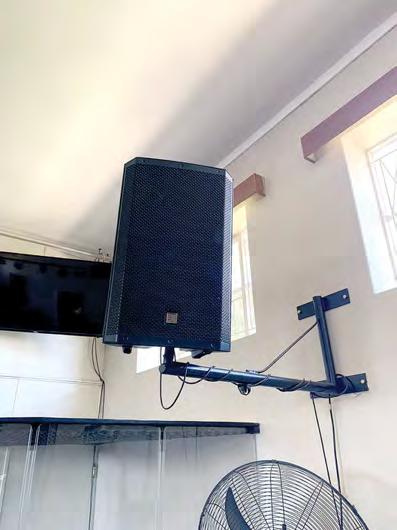
who enquired about the academy had very little knowledge about equipment, other aspects of audio engineering and even country policies regarding regulating noise and sound. This is still a major problem, including in houses of worship, where it is so important to have clear audio. During my career, I have also carried out several installations for churches here in Harare, including
Christ Embassy Church in Hartfield. This included the installation of an Electro-Voice ELX200 speaker system which was used to share the gospel to around 500 people. Another installation was for House of Praise Church where we also selected an Electro-Voice ELX200 setup. For Christ Embassy in Belvedere, we installed a Soundcrest MLS line array system with an Electro-Voice ZLX monitoring solution, supplemented by Electro-Voice ELX200s as delay stacks for the 2,500-capacity auditorium. Over the years, an appreciation for better sound has grown in houses of worship, and church leaders are more open to investing in better audio technology. Line array systems are becoming the norm in many churches since they are trustworthy, affordable and produce great sound quality. In essence, AV technology gives every pastor the chance to experience high-quality sound systems for their sermons. Coupled with immersive visual displays to engage congregations and interactive tools such as
I had an idea of starting a magazine called the AV Directorate, with the aim of educating and bringing information about the AV sector closer to home. I believe God laid it in my heart that I had to fill in that gap by educating and showcasing what houses of worship (which are the largest consumers of audio globally, as far as I am aware) and service providers can do to improve the quality of their audio.
What have been the major challenges you faced during the early stages of organising AV Expo?
Organising any event is not as easy as it appears. A lot of prayer and preparation goes in to making it happen. The biggest challenge is getting in touch with international companies and making them aware of the event.
What trends have you observed in the local AV industry recently?
We have seen a growing demand for high-quality content across various platforms like television, radio, online, live and more. This has led to companies adopting new technologies such as augmented reality, virtual reality, 360° video production and livestreaming, and this trend is set to continue as more churches host their services online.
www.facebook.com/avexpozw
8 WORSHIP AVL July–August 2024
SPECIAL REPORT
Electro-Voice’s ELX200 loudspeaker at House of Praise Church
House of Praise Church in Harare, Zimbabwe
Mbaki Nleya Founder of AV Expo
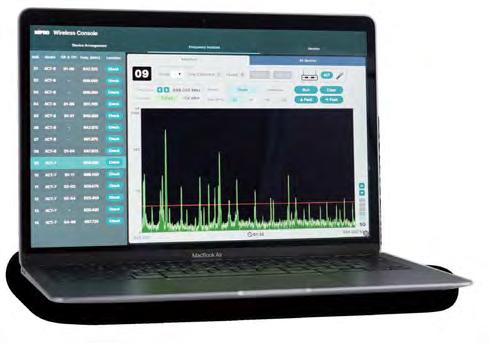


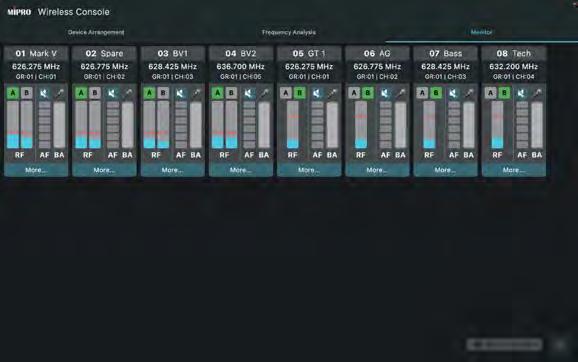



Taking Aim

Aimed has rapidly extended its credentials among the South Korean house of worship market
WITH A RAPID ASCENT IN numbers, South Korean church buildings have seemingly supersized in scale with many services mirroring live concert performances. In their drive to welcome new believers, most churches are expanding and, as such, are effectively competing with one another. The delivery of everything from sermons to songs demands best-in-class, if not unique, audiovisual technologies to deliver the message.
Recognising a gap in the market, Yeon Woo Kim is an expert in delivering audiovisual designs among South Korea’s house of worship community. Following lengthy spells working for then Harman Pro distributors Sovico and Tech Data, Kim’s decision to focus on this growth sector led to the inception of his own bespoke business. Kim decided to differentiate himself from the pack by investing in the recruitment of several full-time specialist engineers and designers. Clearly enlightened with a vision for his growing client base, Kim opted on christening his company, Aimed. Previously trading as S3 Global, Aimed rapidly extended its
credentials among the South Korean church fraternity. Delivering a focused AV standard within the HOW community, the fledgling specialist added another glowing reference to its portfolio in 2023, by executing a broadcasting studio in the basement of Oryun Church in Seoul. In doing so, the church’s audience and membership is growing exponentially beyond the sanctuary. Other churches noted the works with interest and have similarly engaged Aimed for quotations.
“I realised 10 years ago that the market was changing,” Kim explains. “Churches were starting to seek all-inclusive go-to-specialists, including acoustic design services. Even the larger and more established players in the market were having to adopt their roles and hire sub-contractors to fulfil the demanding specifications and designs. This era proved to be an expensive transition and the results were below standard.”
Houses of worship may demand similar audiovisual and lighting technologies to be used for their services, but the applications that Aimed are commissioned for differ
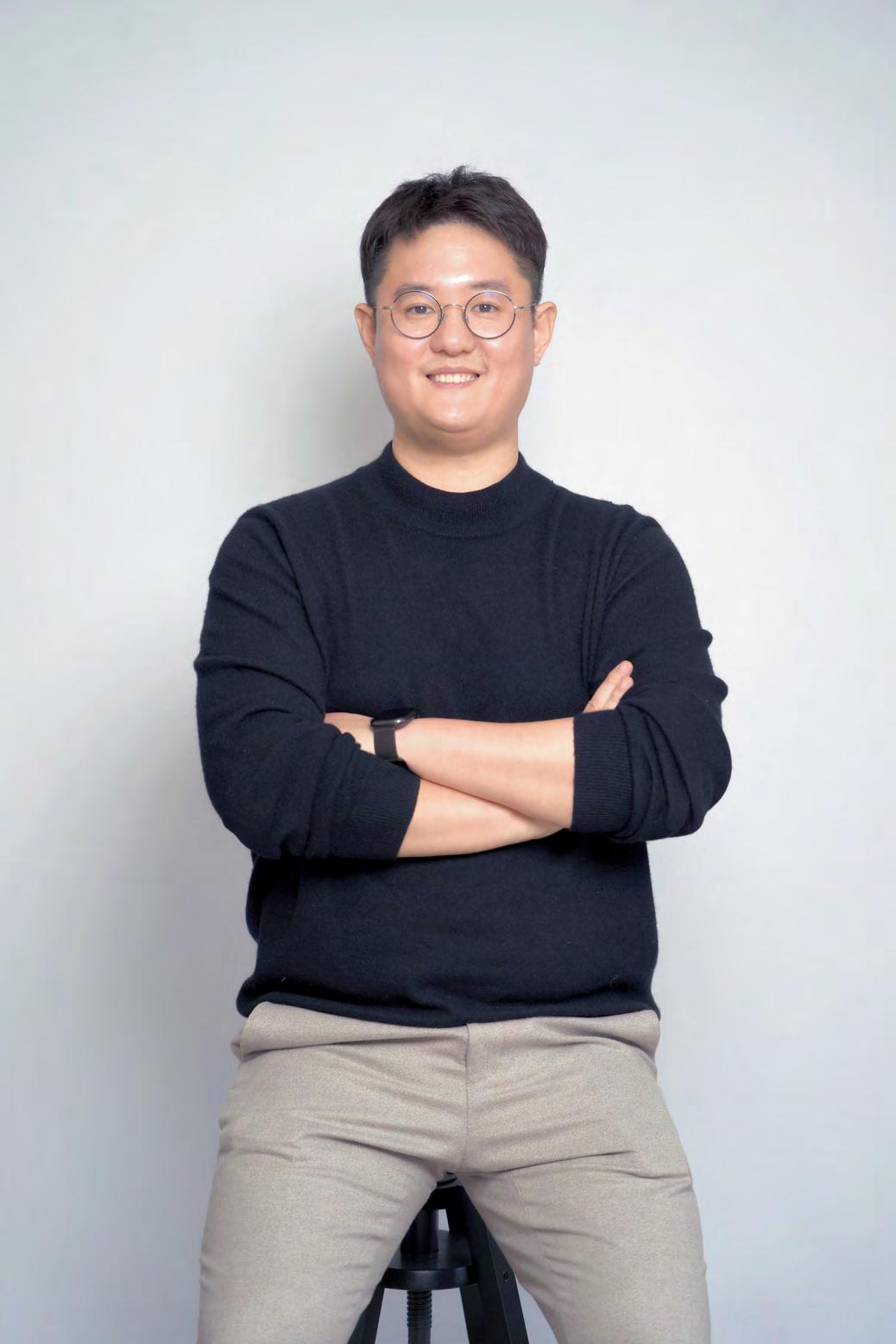
PROFILE
10 WORSHIP AVL July–August 2024
Yeon Woo Kim
markedly. “The clientele demand good listening skills to be applied and an open mind,” continues Kim. “As such, no two contracts are the same.” So far, a lack of specialist competition servicing this sector has contributed to the company’s growth, but Kim is not taking anything for granted.
“Aimed has developed a niche in the market and we are gaining new clients, pleasantly surprised by our existence. But we are continually learning new skills as each contract demands new solutions to be applied.”
Following an initial meeting with a client, Aimed targets its specialist services according to the HOW’s individual needs. When contracted to supply and design audio equipment during his previous employment, Kim realised that completion time onsite was severely compromised. “AV systems integrators are usually asked to install their technologies towards the end of the project, just before opening. It can be stressful as the designs are often compromised owing to other works that have not been satisfactorily completed.”
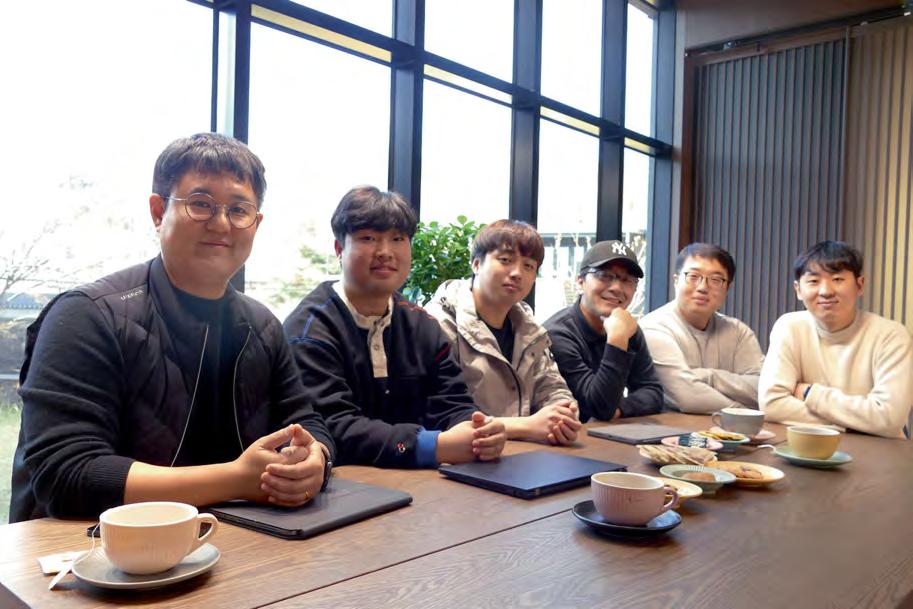

Aimed insists on working with its clients from the beginning of a project, at a point when
the architect’s blueprints are being created. “Aimed is under pressure to deliver consistently high-quality results but, when you are commissioned from the construction or the start of the renovation phase, it is a lot easier.
Once a design proposal has been approved, our Task Force Team
The
Reference For Close Miking Instruments
then creates a development programme.”
The growing clientele has led to increasing revenues, with the company’s success measured in repeat business and growing pains.
The company recently relocated to large and bright offices in Seoul’s leafy suburb of Gwacheon-



si. The relaxed atmosphere complete with barista coffees is perfect for consultant and design meetings with the Aimed team.
“As we continue to grow, we will invest,” explains Kim. “Both our customers and the entire Aimed team enjoy coming to the current headquarters.”
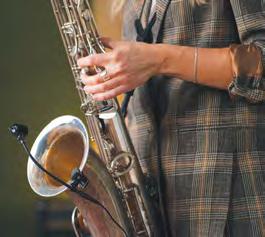
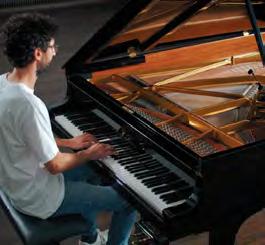

July–August 2024 WORSHIP AVL 11 THE REFERENCE SINCE 1928
Explore the MCM sound samples recorded with the artists at neumann.com/mcm The Miniature Clip Microphone system (MCM) delivers true Neumann sound on stage for wired and wireless operation. Flexible mounting options, fully modular, ultra durable. TAKE YOUR LIVE EXPERIENCE TO A NEW LEVEL.
New
L–R: Aimed CEO Yeon Woo Kim with Woo Yeol Ryu, Hyoung Jun Noh, Joon Ho Jo, Dong Hun Lee and Eun Oh Cho

Aimed was recently commissioned to design and install a large LED solution within the 4,000-capacity sanctuary of the Eungwang Church in Icheon. “We received an initial enquiry from this church, as they had witnessed the broadcasting and conferencing design setup we engineered at Oryun,” explains Kim. “Many Korean churches are influenced by a US-style setup but lack the expertise to implement these designs. To create a full solution, the norm required several specialist audio, video, lighting, acoustics, LED and acoustic design companies to collaborate and offer their engineering capabilities. Most clients, however, prefer to interface with just one company as it saves time, and nothing is lost in communication.”
In recent years, Aimed has increasingly directed its attention on the dynamic LED market and, as a result, Kim feels the company offers a level of expertise that further differentiates them.
Measuring 36.73m x 37m, both the first- and second-level sanctuaries within Eungwang Church are adorned with multiple walls, courtesy of the tetrahedron shape. “The church requested us to create an LED design that would maximise the space within the recess behind both stages,” Kim explains. A common challenge perhaps, but the highly unique setting insured, as normal, that a cut-and-paste design could not be applied.
“Audiences generally prefer to watch a full-size LED, so we had to remove the existing split screens, the cameras and the overhead lighting,” explains Kim.
visits. By attending Sunday church services, Aimed continues to monitor, manage and configure the settings, in addition to providing their numerous contacts with advice and assistance.
Not all the company’s works are related to the design and integration of AV and lighting technology as exemplified with Eungwang Church. To fully maximise the space, the church rents the sanctuary for external events. Owing to this multipurpose nature, the church requested assistance with content creation, including motion graphics when required. Kim’s colleagues,
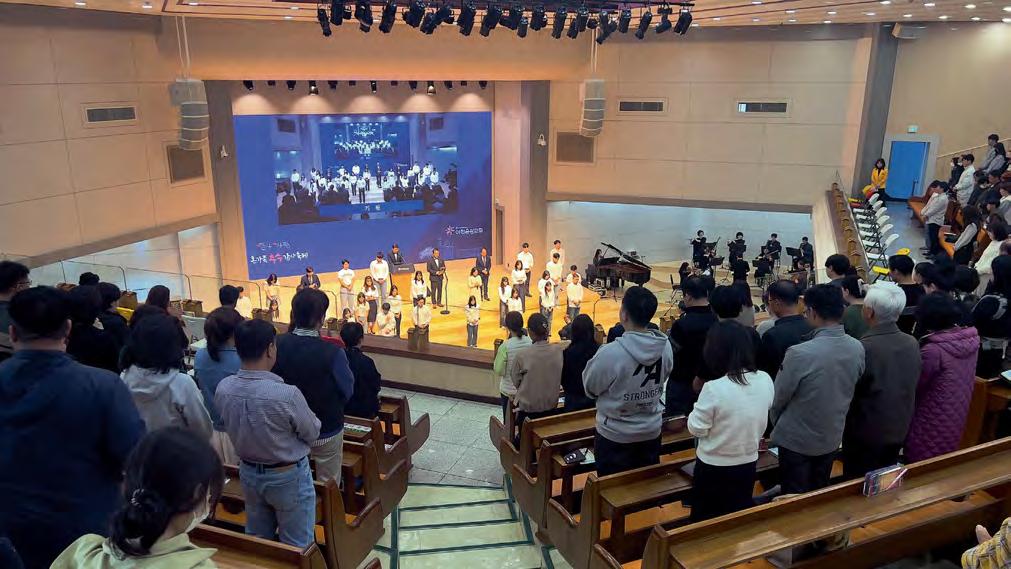
“The biggest challenge we faced, however, was fixing the full-size LED screens to the walls. The rear walls were very uneven and warranted us hiring a subcontractor to remove the existing wall and make good. Finally, ease-of-use operations is vital, so we were agreed to add one-touch button presets for their everyday requirements.”
With its higher ceiling and seating capacity, the LED fixed onto the rear wall of the secondlevel sanctuary comprises of 208 Aimed 640mm x 480mm 2.5mm pixel pitch displays. Filling the entire wall and displaying 10,223,616 pixels, the visual attraction measures 8,320mm x 7,680mm (WxH). Formatted to a 16:9 resolution, the display had to be further customised and re-engineered as the church requested the removal of the LED
bezel edge. The same rear wall in the first-level sanctuary is adorned with the same 2.5mm pixel pitch LED components. Measuring 8,320mm x 4,320mm (WxH), the 6,176,769-pixel display incorporates 117 individual displays.
The second-level sanctuary integrates multiple visual inputs. In addition to a video player hosting Pro Presenter software, a wallmounted Panasonic AW-UE160W 4K integrated PTZ camera is backed by a further three Aver PTZ330 1080p 60fps models. Equipped with 30x optical zooms, two of these are also wall-mounted, and the other is fixed onto the ceiling. Equipped with 1080p HD outputs, the entire video network infrastructure was upgraded throughout, including SDI cabling and SDI-HDMI converters. In addition to the main LED displays
and Novastar LED processors, HD content is also streamed internally to the network of displays throughout the extensive church courtesy of an Elgato Stream Deck featuring customisable LCD keys to control apps and platforms. Having agreed to a three-year, full-service contract, Aimed is maintaining the equipment on a regular basis. Should a fault develop with any of the LED modules, however, stored hotswappable spares can be easily slotted into the existing grids in either venue. Operations have been simplified with stored scene changes, including Nature, Simple and Calm. In addition to their busy working weeks, Kim and his team are rarely free on Sundays. The numerous houses of worship they network with warrant regular social
therefore, regularly provide suitable material for a multitude of mixed events, including weddings, meetings, musicals and plays. “The content continues to evolve, so we attend regular meetings to remain updated,” insists Kim. “Following a preview and follow-up discussions, we are usually asked to apply edits until signed off by management.”
Having successfully targeted the growing South Korean house of worship market, venues and event organisers are also requesting Aimed to assist their dynamic productions. Engineering AV and lighting solutions beyond the sanctuary space and onto the stages and catwalks of Seoul and beyond, the Aimed approach is heading in new directions.
www.aimed.or.kr
PROFILE
12 WORSHIP AVL July–August 2024
A relaxed office atmosphere complete with barista coffees
Aimed created an LED design that would maximise the space within the recess behind the stage at Eungwang Church



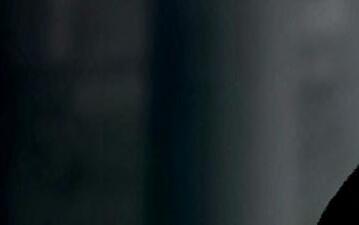
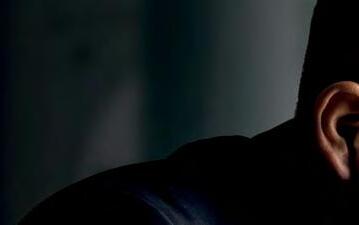




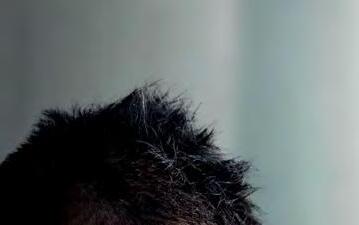











































It has always been our main goal to deliver clear, natural sound to ensure every word is heard throughout the whole audience. Especially in places of spiritual contemplation it is particularly important to not just transmit speech. Using K&F PIA M makes room for the most important thing: the message. Loud, crystal clear and natural. MORE THAN JUST SPEECH K&F PIA M CONVEYS YOUR MESSAGE
YOUR MESSAGE. SPIRITUAL.
www.kling-freitag.com
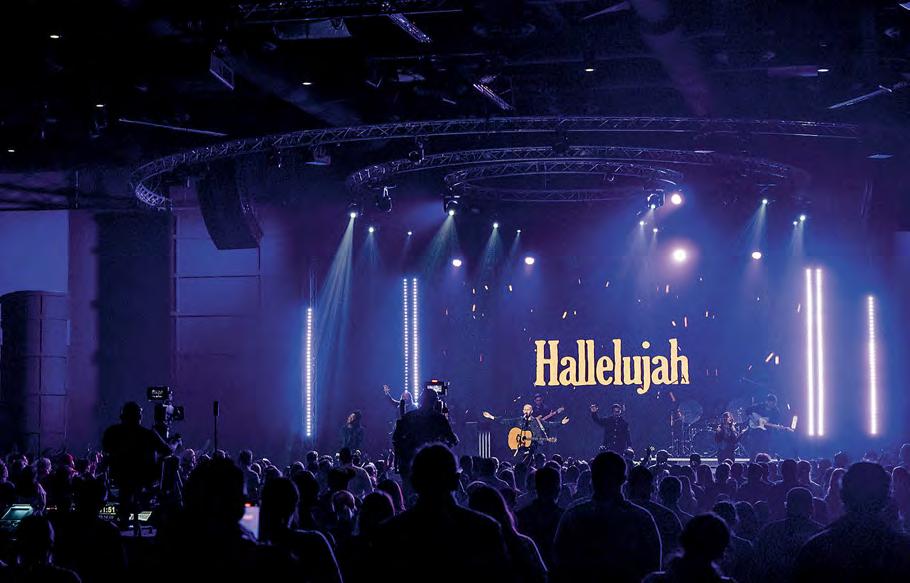
Limitless audio

Walter Wilson accessing KLANG:konductor IEM monitor mixes via a touchscreen running KLANG:app
A KLANG IEM mixing system and DiGiCo console have provided Church Unlimited with an entire ecosystem that is easy for volunteers to use
SEATING OVER 1,500 WORSHIPPERS, Church Unlimited’s flagship Corpus Christi, Texas campus has installed a KLANG:konductor IEM mixing system paired with a DiGiCo Quantum338 front of house console. The Corpus Christi location is also home to the sanctuary’s broadcast centre, which is now complete with a Quantum225 desk.
The audio system upgrade was designed and installed by Georgia-based integration firm MessengerAVL. The company’s system engineer, Parker Gann, noted that he hadn’t planned on using the DiGiCo integration with the KLANG system when he first started designing the project and that the KLANG:konductor was originally meant to be standalone. “When I started playing with the integration between it and the Quantum338, I realised that it was a great way to keep things like the channel and aux names synced up and we could use aux mix presets on the console to recall musician settings,” he explains. “If the drummer moved to be the guitar player the next week, we could recall his mix on that pack immediately, and I really appreciated that kind of workflow. I’ve always loved doing monitors on DiGiCo because of things like mix presets, so combining that with
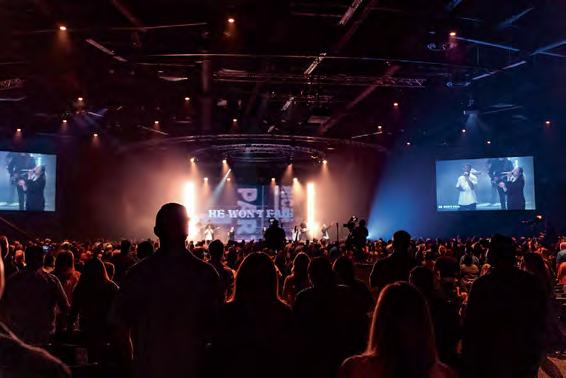
what the KLANG:konductor could do with the immersive IEM mixes was fantastic.”
Gann did a demonstration of the KLANG systems’ immersive monitoring for the church team, which led to them adding eight additional transmitters to the package. “They put headphones on and I made them a binaural mix, then A/B-ed them,” he notes. “I said, ‘here’s the mix without KLANG’ and then I hit the button to go to surround and everybody’s jaws hit the floor. They could not believe how good it sounded. The Corpus Christi campus is their largest campus and their flagship
campus, and now it’s their most advanced campus when it comes to audio.”
The audio package also includes the DiGiCo MQ-Rack. Connecting the KLANG:konductor and the DiGiCo consoles via MADI and Dante, it is used as the primary stagebox and a link to the church’s Quantum225 broadcast console. Furthermore, five DMI-DANTE64@96 cards are used across the system; t h e KLANG has a Dante and a MADI card, the Quantum338 has two Dante DMIs in it and MADI built into the console natively, while the Quantum225 also has two Dante cards.
“We basically use one Dante card for their video I/O and some RedNet equipment and we use the other as a Virtual Soundcheck card,” adds Gann. “Now, they’ve got extra channels and processing to spare and the flexibility of the DiGiCo consoles allows them to do basically anything they need to do. They love the sound quality and flexibility and they’re very happy with it.”
Church Unlimited’s lead production director, Walter Wilson, comments: “Coming from a dedicated monitor mixing console, the addition of the KLANG:konductor has been amazing. The first thing we all noticed was the clarity of the KLANG and then the seamless integration with the DiGiCo console. It creates an entire ecosystem that’s totally flexible and intuitive to use, which is very important when you have volunteers running the systems. The consoles’ ability to match its flexibility with our worship experience, with features like plugin integration and the tactile feedback the worksurfaces give you, is amazing. The whole ecosystem of KLANG and DiGiCo is perfect for us.”
www.churchunlimited.com www.digico.biz www.klang.com
14 WORSHIP AVL July–August 2024
PROJECTS
Church Unlimited’s Corpus Christi broadcast site seats over 1,500 worshippers
Get broadcast quality H.264, ProRes and DNx files recorded to SD cards or SSD media!
HyperDeck Studio lets you record broadcast quality video files directly onto SD cards and SSD media! The new redesigned HyperDeck Studios feature modern design with more codecs and quieter cooling. All models now support recording to H.264, Apple ProRes or DNxHD files with either PCM or AAC audio. For ISO recording, there’s even built in timecode and reference generators for syncing multiple units!
Elegantly Designed Professional Broadcast Deck
The new HyperDeck Studio models have been totally redesigned with dozens of new features! The Pro models feature a machined metal search dial with increased mass and a soft rubber surface that feels nice to the touch. Plus the search dial features an active clutch, just like a traditional broadcast deck! With dual media slots, you can change cards without interrupting recording!
Record to External USB-C Media Disks
If recording to other types of media is required, the USB-C expansion port lets you plug in an external flash disk for recording. USB-C flash disks have unlimited capacity because they can be physically larger than an SD card or SSD. Just move the disk over to a computer and instantly start editing! There are also menus for managing external disks on the built in LCD.
Popular ProRes, DNx, H.264 and H.265 Files!
HyperDeck supports the most popular codecs in use today! All models include DNx and ProRes file formats. However all models also include H.264 in quality up to 10 bit 4:2:2 when recording in NTSC, PAL, 720p, 1080p and true 1080i interlaced formats. While the 4K model adds H.265 when recording in Ultra HD. The Plus and Pro models have ProRes 4444 for fill and key playback!
Advanced Broadcast Connections!
Depending on the model HyperDeck Studio features a wide range of video and audio connections such as 3G-SDI, 6G-SDI or 12G-SDI. All models include HDMI for connecting to televisions and projectors. There’s even a dedicated SDI monitoring output on the Pro and Plus models with on screen status. The 4K model has 10G Ethernet for extremely fast network file copying!
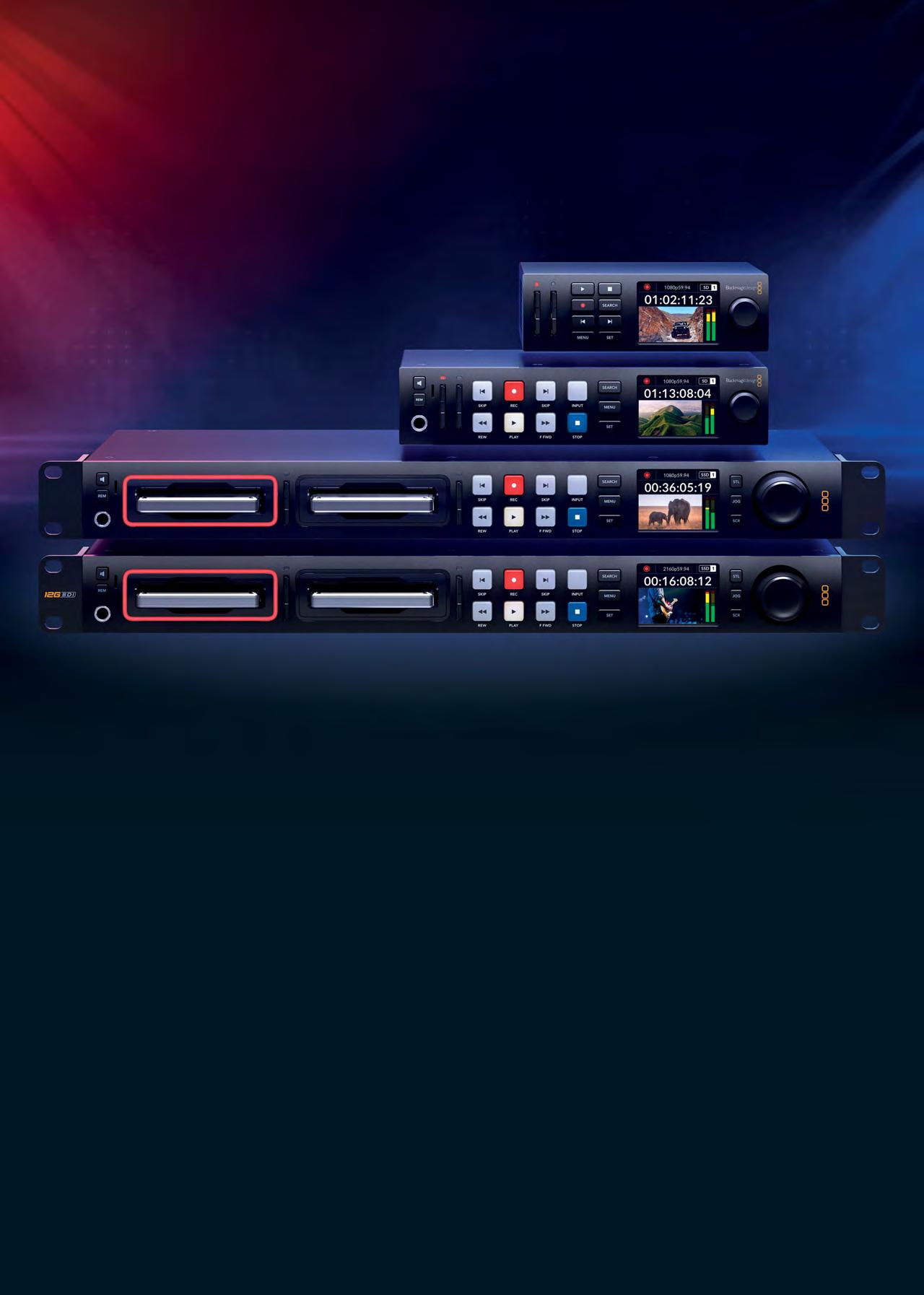
S$1,375
S$2,195
The New HyperDeck Studio
Learn more at www.blackmagicdesign.com/sg HyperDeck Studio HD Mini S$685 HyperDeck Studio HD Plus
HyperDeck Studio HD Pro
HyperDeck Studio 4K Pro
SRP is Exclusive of Taxes.
S$955
Sacred symphony
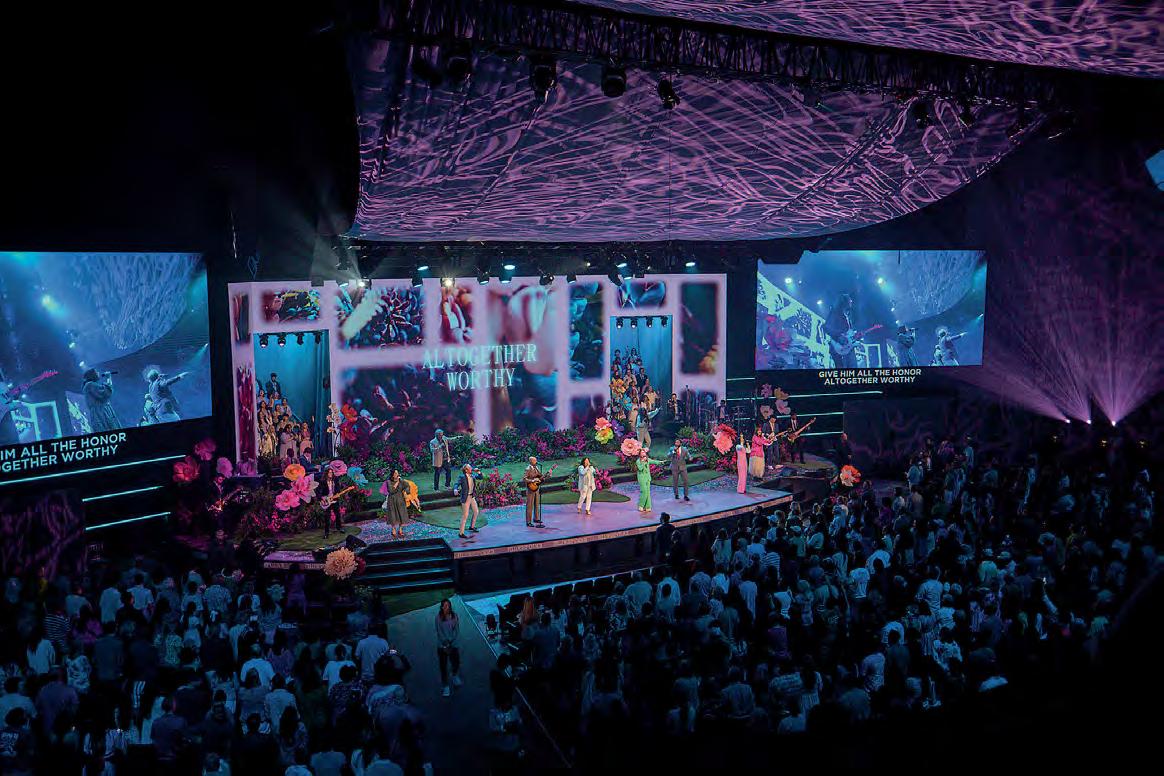
Fellowship Church has called on Riedel Communications to help elevate services across its multiple sites and bring the gospel closer to its congregants
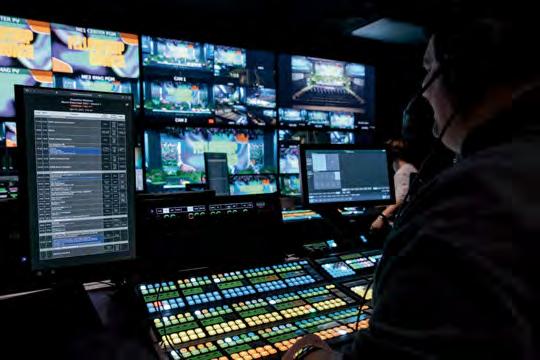
FOUNDED IN 1989 AS A MISSION
church of the First Baptist Church of Irving, Texas, Fellowship Church has grown into a multisite house of worship with satellite campuses in Fort Worth, Dallas and Frisco. The main facility in Grapevine has recently taken delivery of a Riedel Communications Artist-1024 intercom system, integrated with SmartPanels and Bolero wireless beltbacks, to improve communication between campuses.
Supplied by systems integrator Clark, the Riedel solution has empowered the HOW to fulfil its mission to “reach up, reach out and reach in” during services across its four campuses. The system has enhanced audio clarity and allows Fellowship Church to deliver religious and educational programmes more reliably than before.
With the Grapevine facility spanning 11,400m2, the campus features
worship and atrium sections connected by a hallway. The Bolero coverage, which is provided by five antennas, ensures uninterrupted communication throughout the entire space, including the control room. The IP network-based system provides flexibility to throw down systems anywhere in the facility to immediately route new audio.
“With the upgrade to the Riedel intercom system, the audio quality has drastically increased, delivering crystalclear audio – so clear that you cannot tell where I am – with zero dropouts,” explains Corbin Rubinson, production engineer at Fellowship Church. “What’s even more impressive is the overall product quality. We can make changes live on the fly while the system is operational without anyone noticing. With our previous setup, we had to shut down the entire system and pray that it would come back up.”

David Medford, video engineer at Fellowship Church, adds: “The confidence the Riedel intercom system gives us is invaluable. We know it will work seamlessly and reliably, allowing us to be mobile and flexible. Volunteers equipped with Bolero beltpacks can move around different areas of the campus, and I can provide assistance anywhere it’s needed while remaining in communication with the control room the entire time. The system’s easy setup and mobility have saved us a significant amount of time – from an entire day down to only 20 minutes.”
The church hopes that its volunteers of varying ages, from high school students to seniors, will be able to easily learn how to operate the system within minutes. The Artist-1024 intercom replaces an outdated setup dependent on paper labels that
were frequently faded and difficult to read, making the colour-coded Riedel SmartPanels especially valuable. Integrated GPIO triggers also allow for a flashing light that signals to operators that the system is functioning.
“We’re thrilled that our intercom system has brought such tremendous improvement to Fellowship Church’s operations. They get the reliability necessary for their remarkable productions along with clear communication and greater efficiency for both the technical team and the entire congregation. It’s fulfilling to see, and I eagerly anticipate the church’s future endeavours with the technology,” adds Ben Gabrielson, southwest regional sales manager at Riedel Communications.
www.riedel.net
16 WORSHIP AVL July–August 2024
PROJECTS
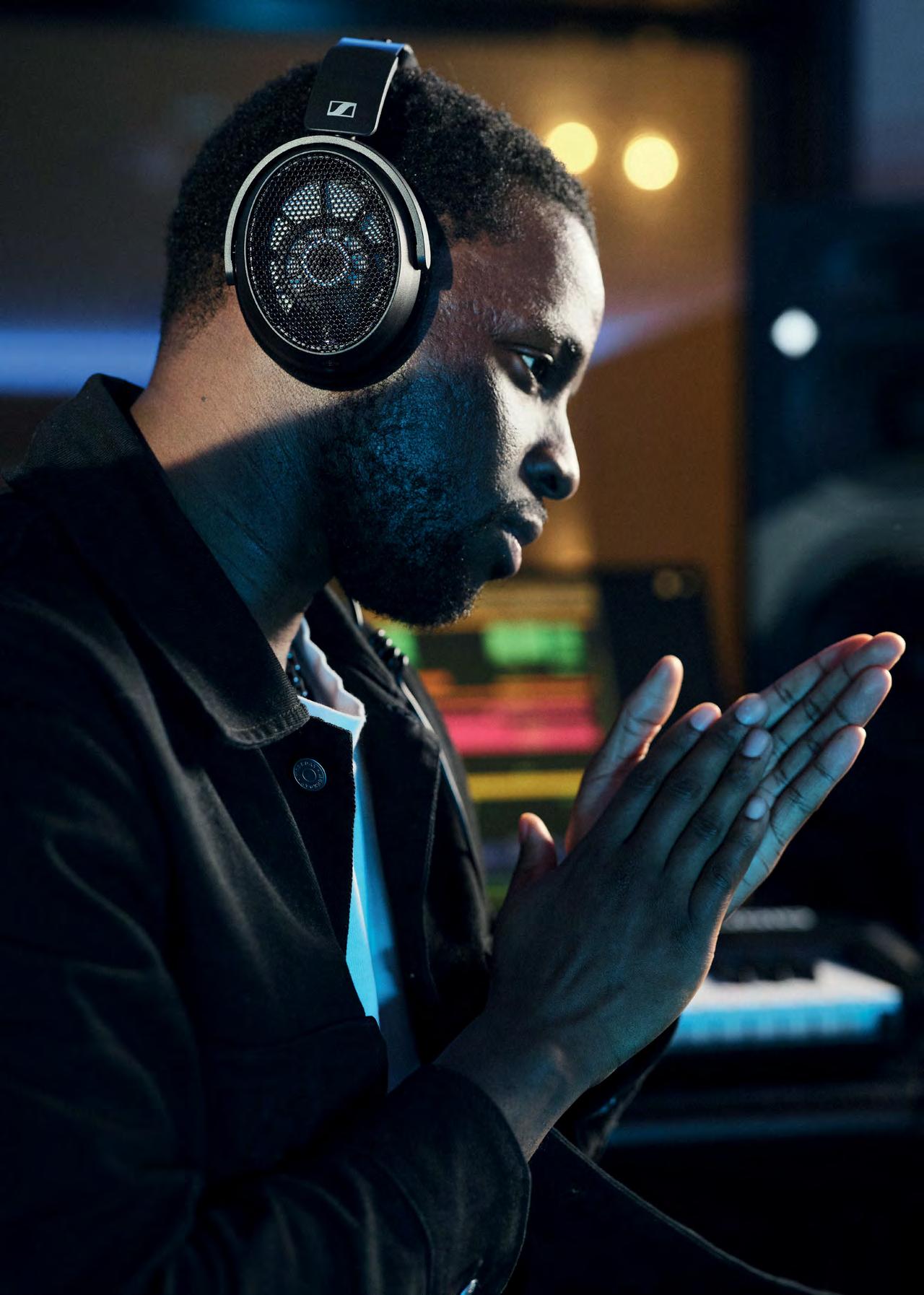
HD 490 PRO The perfect mix of clarity, comfort, and reliability. HD 490 PRO studio headphones are built to handle all the complexities of today’s music production. The open-back design delivers an extremely wide, dimensional sound stage and ultra-precise sound reproduction, eliminating audio blind spots and ensuring you’re in full control of every detail. sennheiser.com

Glorious resonance
A full sound system upgrade has transformed services at the Basílica del Voto Nacional in Ecuador – the largest Neo-Gothic church in Latin America
WITH ITS TOWERING STEEPLES and magnificent marble and stonework, the Basilica del Voto Nacional dominates the skyline in Quito, Ecuador’s capital city. Located in the historic centre and one of the city’s main tourist attractions, the basilica was built between 1887 and 1924 to celebrate Ecuador’s consecration to the Sacred Heart of Jesus, one of the Catholic church’s most practised devotions. With celebrations for the 150th anniversary of the consecration taking place in January, the basilica felt it was time for a full revamp of its audio system.
Professional audio, video and lighting specialist EASA is also based in Quito and was enlisted by the basilica to take charge of the upgrade and ensure all the audio in the church was perfectly installed so that this sacred event could go forward without any issues. Having already completed several smaller projects at the basilica over the previous few years, EASA sales and marketing manager Daniel Cueva first met with the basilica’s principal priest a year-and-ahalf before the 150-year milestone.

it very difficult for members of the congregation sitting furthest from the pulpit and the front altar to hear anything,” explains Cueva. “For a church of this size, you need good intelligibility so that all members of the congregation can hear the Word of God.”
“The basilica is the most important church in Ecuador but the sound system was outdated and it made
After taking measurements, Cueva and the EASA team began by creating a 3D model of the interior. As part of the design process, EASA held a demonstration of the proposed HK Audio system at a small church
nearby so that the leaders at the Basílica del Voto Nacional could hear how services might sound.
“Even though the church where the demonstration took place was a lot smaller, the principle was the same,” adds Cueva. “We wanted them to hear the clarity of the system.”
One of the most challenging aspects of the project was dealing with the reverberations in the church, a result of the extensive stone and marble throughout, as well as a high ceiling reaching up to 115m in places. “With

the old system that consisted of a variety of small speakers dotted around the space with no time alignment or EQ, if you clapped your hands, you’d hear the sound at the back of the basilica two days later!” jokes Cueva. “This is the main reason we opted for a column speaker setup because we can control the directivity on the vertical display angle.”
Eventually, the team decided on an HK Audio SI Series setup consisting of 26 P10i TR and four P10j TR speakers. The main PA at the front of the church consists of three speakers – one P10j and two P10i units per side – and measures 2m high. This setup is repeated behind the altar and serves as the main rear PA. Moving down the nave, the PA is supported by six P10i delay speakers fitted on alternate columns. A further four P10i are also fitted on the nave columns and fire outwards to cover the side areas. “We installed delays of two columns per side to cover the central audience area in addition to some single columns to cover the sides and the choir areas,” explains Cueva. “The delay system is aligned with the main PA system at the pulpit, so that clear sound can be heard throughout the church. With a space of this size,
18 WORSHIP AVL July–August 2024
PROJECTS
The front PA system consists of two P10i and one P10j per side

the main consideration is that the worshippers can see and hear the priest wherever they sit. And with the height of the building, we had to deal with all the late reflections bouncing off of the ceiling.”
Alongside the speaker system, EASA supplied four Sennheiser EW-D digital microphones, with splitters and external antennas. Additionally, the
church nearby for a period of two weeks, so that we could complete the installation before the anniversary deadline,” says Cueva.
The Consecration to the Sacred Heart of Jesus anniversary was also televised live across the country, so everything had to be perfect with the new audio system. Luckily, Cueva knew some of the members of the

One of the main challenges was the basilica’s extensive stonework. “We had to take extra care to make sure the stonework isn’t being damaged,” explains Cueva. Because of the number of loudspeakers being installed and the entire power supply in the basilica needing an upgrade, there was a substantial amount of wiring that needed to be fed through some difficult spaces, including under the floor. “In some places, we needed to take out pieces of marble to pass the wiring through the pipes underneath, and place the marble back perfectly without any damage,” adds Cueva.
On top of considerations for the church’s historic infrastructure, Cueva and his team were faced with the challenge of working around the basilica’s services and opening times for the public and tourists. Working in the evenings and at weekends allowed the team to install the majority of the equipment. “For the final part of the setup process, services were moved to a smaller

setups in Ecuador with professional AV equipment and will certainly help the basilica reach a far wider audience.
“It doesn’t matter where anyone sits now, the sound is really clear throughout the audience area,” concludes Cueva. Adding another level of importance to the upgrade is possibility that the Pope may visit
PROFESSIONAL
COSMO
THE INTEGRATIVE LINE ARRAY
HK Audio’s COSMO line array system combines stateof-the-art audio quality with ingeniously simple handling, utmost utility and remarkable economy to provide an extremely flexible, easily configurable PA for professionals.
COSMO raises the performance bar for line arrays, setting a whole new standard for productivity and efficiency. Integrative and versatile by design, it delivers measurably higher effective SPL in the HF range than comparable systems.
With horizontal directivities of 100°, 80° and 60°, this formidable family of ultra flexible systems provides the bandwidth needed to cover the most diverse live scenarios.

later this year. And while it’s unlikely that the Pope will sit in the very last row of seats, the Basílica del Voto Nacional can be assured that every member of the congregation will be able to hear him speak, wherever they are seated.
www.easa-ec.com
www.hkaudio.com


PROJECTS July–August 2024 WORSHIP AVL 19
P10i speakers fire outwards to cover the side areas
hkaudio.com
C 6 100˚ C 8 80˚ C 10 60˚ HK_Audio_Cosmo_2023_en_160x139.indd 1 19.07.23 10:59
Delay speakers are fitted on alternate columns down the nave
All routes lead to Dante


Grace Community Church in California has chosen a large Dante-based networked AV system throughout its campus
FROM ITS HUMBLE BEGINNINGS
in the 1950s, Grace Community Church has grown into a multi-building campus in southern California. Today, the non-denominational evangelical church comprises a 3,000-seat worship centre, the original 300-seat chapel, a family centre, a children’s centre, the Master’s Seminary, a tower featuring five large classrooms and several small outbuildings. To streamline its AV management and keep the focus on worship experiences, the HOW is using a large Dante-based network AV system, including video capabilities using Dante AV.
The initial Dante implementation began in 2014 with buildouts in the family centre and worship centre, with the church regularly adding Dante endpoints over the years, now totalling over 150 devices. During full orchestral performances, over 100 microphones are deployed between the musicians, choir and worship leaders running through Dante-enabled Yamaha consoles. The church employs separate networks for IT, security and AV traffic to avoid conflicts. Given the size of the existing Dante network, the church began using Dante Domain Manager in 2022 to help maintain and manage sitewide deployment. The ability to route Dante audio between VLANs/subnets has allowed the HOW to consolidate 10 isolated audio systems into one integrated network.
Recently, Grace Community Church created a feature documentary slated for theatre release but wanted the first broadcast to premiere campuswide. Not knowing how large the audience would be for such a venture,

the church felt it prudent to have the worship centre and several overflow rooms prepared to receive guests and broadcast the documentary.
The HOW felt that the documentary needed to be broadcast in 4K for maximum effect, and while Grace Community Church had a pre-existing video distribution system, it could not deliver video reliably for the needs of this project.
The church leadership turned to John Mark Conaway, Sunday technology supervisor for the church, to coordinate the challenge of distributing reliable 4K video and audio to each screening space. “We were fully committed to Dante on the audio side, so when we heard about Dante AV, we were interested in trying it out,” he said. “Our initial test in the main overflow room was a ‘set it and forget it’ trial, which worked perfectly. That’s the type of reliability we were looking for, and we didn’t need to tinker with it continuously.”
The church’s AV team deployed nine Bolin D20 Dante AV Ultra transceivers throughout the campus to facilitate the live video stream from the sanctuary to overflow rooms in the satellite buildings. The transceivers can be programmed as an encoder or decoder. Bolin’s D20 Series devices are single video channel networked AV-over-IP transceivers fully compatible with Dante audio devices within a Dante ecosystem like Grace Community Church. Each transceiver supports up to 4K60 streaming over a standard gigabit network with ultra-low latency and offers embedded audio output via HDMI or SDI and PTZ camera movement control via IP or IR pass-through. Based on the preexisting SDI infrastructure, the church installed three D20H models (HDMI) and six D20S units (SDI) across the campus.
“The flexibility the D20 transceivers provided regarding audio and video distribution is a big plus,” added
Conaway. “Expanding our existing Dante infrastructure to include Dante AV was not only plausible but also usable and cost-effective.”
The church wanted to provide a live introduction in 4K across the campus and then cleanly switch to the documentary being fed from a Blackmagic Design Hyperdeck. The premiere was described a huge success, and audience reactions to the AV experience were highly favourable. The power of being able to independently route the audio and video streams while guaranteeing clock synchronisation provided the AV team with the tools needed to route de-embedded audio from the main feed and resynchronise with the video stream before inputting the signal into six video matrices serving the overflow rooms and the three large screens in the family centre.
“Adding Dante AV to our Dante implementation brought together audio, video, control and management in a single platform for maximum scalability and flexibility,” concluded Conaway. “For us, the selling points were, first, we were already in the Dante ecosystem, so there’s a familiarity with the technology. You’re not starting over. Plus, our staff doesn’t have the time to train on new systems. Second, ease of implementation. Because Dante AV is in the same ecosystem, the integration happens much faster and easier. I don’t know another way we would have accomplished as much in the last 18 months without spending a lot more time and money.”
www.audinate.com www.gracechurch.org
20 WORSHIP AVL July–August 2024
PROJECTS
Nine Bolin D20s were deployed across the campus
The documentary was first aired in various buildings in the church

Enjoy a fully streamlined workflow when integrating your DiGiCo SD or Quantum Range console with any KLANG processor, offering immersive in-ear mixing.
• Deeply integrated workflow, enabling seamless KLANG integration on the fly.
• Standalone functionality - no additional control computer required.
• Lower Levels. Better Mixes. Less Fatigue.

SOFTWARE UPDATED
SPEEDY SET-UP
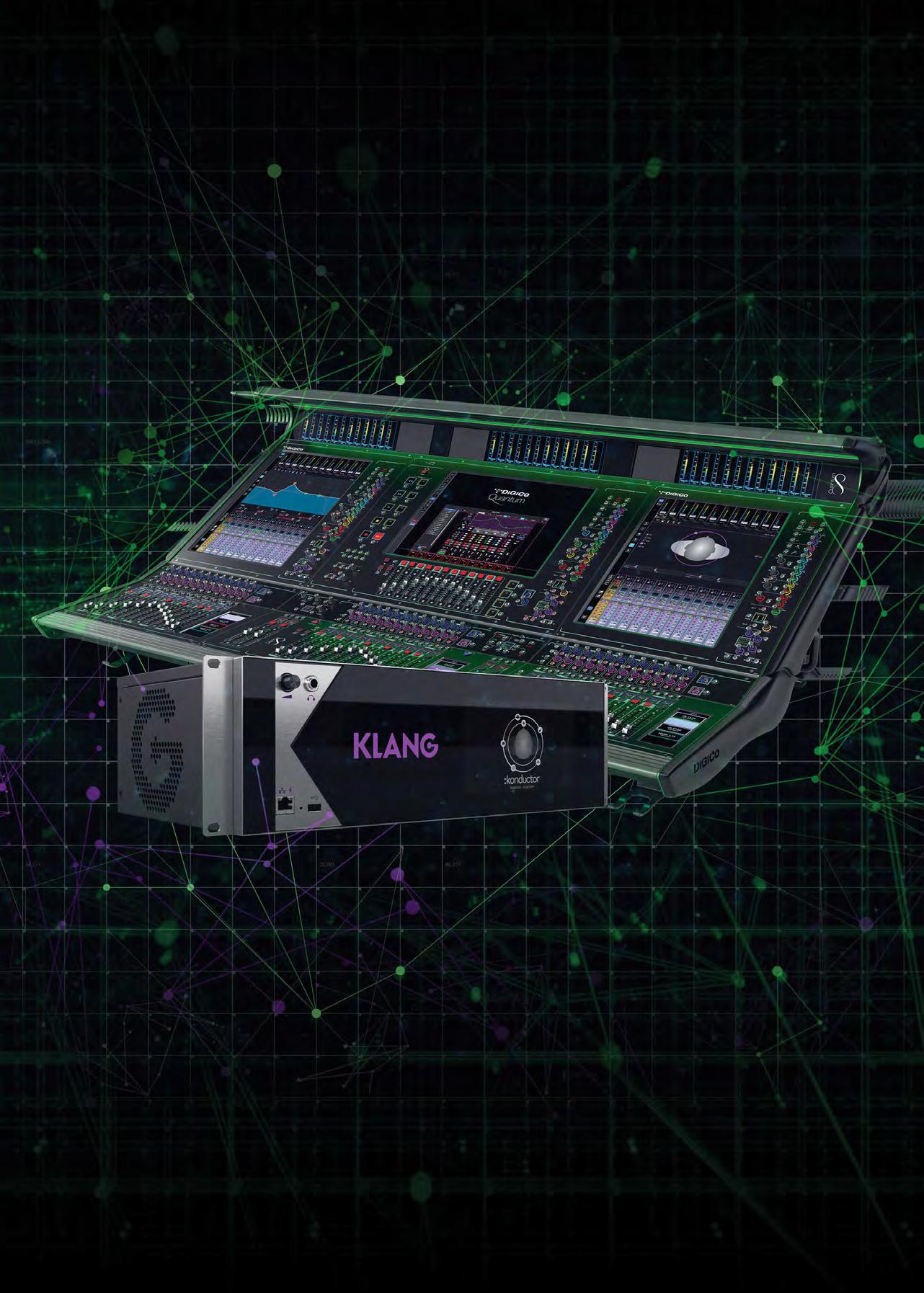


www.digico.biz www.klang.com
SEAMLESS
A spectacle of colour
A Chauvet Professional lighting rig has been used to generate visual energy at Elevation Church’s Night of Worship event
ATTRACTING OVER 2,000 worshippers at its Ballantyne, North Carolina campus, Elevation Church’s recent Night of Worship event was lit by a Chauvet Professional lighting setup created by the HOW’s broadcast designer, Matt Hemmele. Instead of using a combination of videowalls and lights, Hemmele opted to rely entirely on lighting fixtures to generate visual energy for the audience and the broadcast recording. Aside from a small number of linear LED units behind the scrim, Hemmele lit the entire two-hour recording exclusively with Chauvet’s Color STRIKE M, which, like the rest of his rig, was supplied by Main Light.
“We wanted a clean upstage look, which to us meant no videowall,” explains Hemmele. “But we still need to display song lyrics, so we rented a 35k projector for that purpose. This preserved our clean looks.”



PROJECTS Everything you love about Dante Audio, now for video. audinate.com/dante-av
Eighty-three Color STRIKE M units were deployed, with 56 positioned in the overhead rig, nine placed down-stage for crowd lighting, six on the mid-house truss to deliver fill light for the stage and crowd, and a further 12 on the deck to illuminate the scrim. To allow Hemmele to run more fixtures per circuit, all the Color STRIKE Ms were run at 208V.
“We used 46 of them as the main top key and relied on them to provide dynamics while on the front and back tips of each truss,” adds Hemmele. “We also had them work as a crowd blinder and upstage fill for the white scrim. But I was careful not to overpower the choir and band onstage, so the energy they generated could shine through. These fixtures have so many attributes, they allowed me to create a variety of interesting looks and movements, so we didn’t worry about repeating things.”
Hemmele says that whenever
the colour attribute to add both warm and cool tints as well as more granular dimmer effects as I ran the main grid in 74-channel mode,” he adds. “I then used the main as overall brightness, accent hits and larger-scale dimmer effects. With each truss having between eight and 10 strikes on them, I essentially had a large-scale PXL curve that built some ‘curve’ position presets to create some interesting texture to the grid.”
As the Night of Worship recording was for an album, Hemmele placed an emphasis on crowd lighting to ensure the
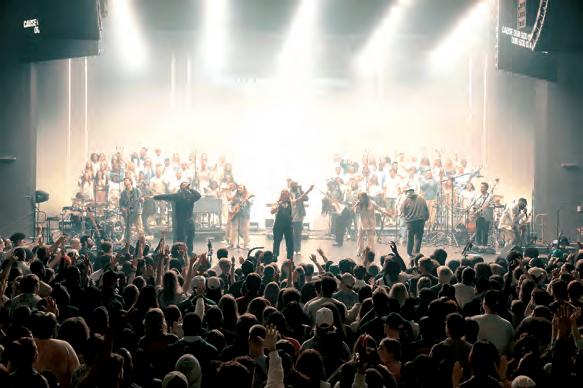
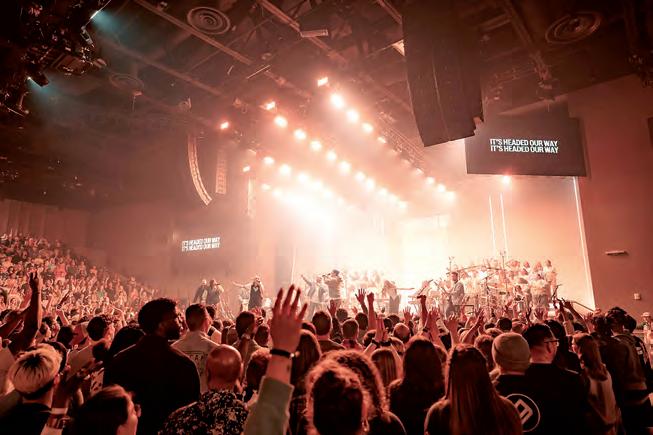
audience was clearly visible for the camera. “Having the strobe and colour plate in one fixture is an incredible asset,” concludes Hemmele. “The insane brightness that they both have creates really high dynamics and it allows me to layer on accent hits and sweeps that really punch through. The tilt is an added dynamic that really put these over the edge in helping


MIXER POWER AMPLIFIER

MX-5348 is a Mixer Power Amplifier with 5 microphone inputs and 2 auxiliary inputs. It's specifically designed for 3-zone public address systems, making it ideal for small to middle-sized mosques. Additionally, it's versatile enough for various other settings such as schools, offices, shops, churches, and large rooms, where it can be used for paging announcements or background music applications.
www.toa.com.sg
We supply sound, not equipment.
PROJECTS July–August 2024 WORSHIP AVL 23
Renewing space and spirit
After it was demolished as part of a large redevelopment project in Bhendi Bazaar, Mumbai, Saifee Masjid has reopened with an extensive AV setup to cater for thousands of worshippers
THE BHENDI BAZAAR
Redevelopment Project in Mumbai is one the largest currently taking place in India, covering a densely populated 16.5 acres of land which houses 3,200 families, 20,000 people and 1,250 businesses. Originally, Bhendi Bazaar was one of several innercity areas developed to cater to the housing needs of traders working in the harbour of Old Bombay, as Mumbai was previously known. Until the commencement of the project in 2009, Bhendi Bazaar was one of the most under-developed and neglected parts of the city, with residents only receiving water for a few hours each day. According to the Saifee Burhani Upliftment Trust (SBUT), the aim of the redevelopment project is to create a healthy and happier neighbourhood, “allowing both commercial and residential lives to thrive to their fullest potential with high standards of living and holistic growth”.
Sitting in the midst of Bhendi Bazaar is Saifee Masjid, home to the Dawoodi Bohras, a Muslim

Mufaddal Saifuddin. The masjid was originally built by the present Syedna’s grandfather His Holiness Syedna Taher Saifuddin in 1926 and has served as the community’s primary place of worship in Mumbai for over 100 years.
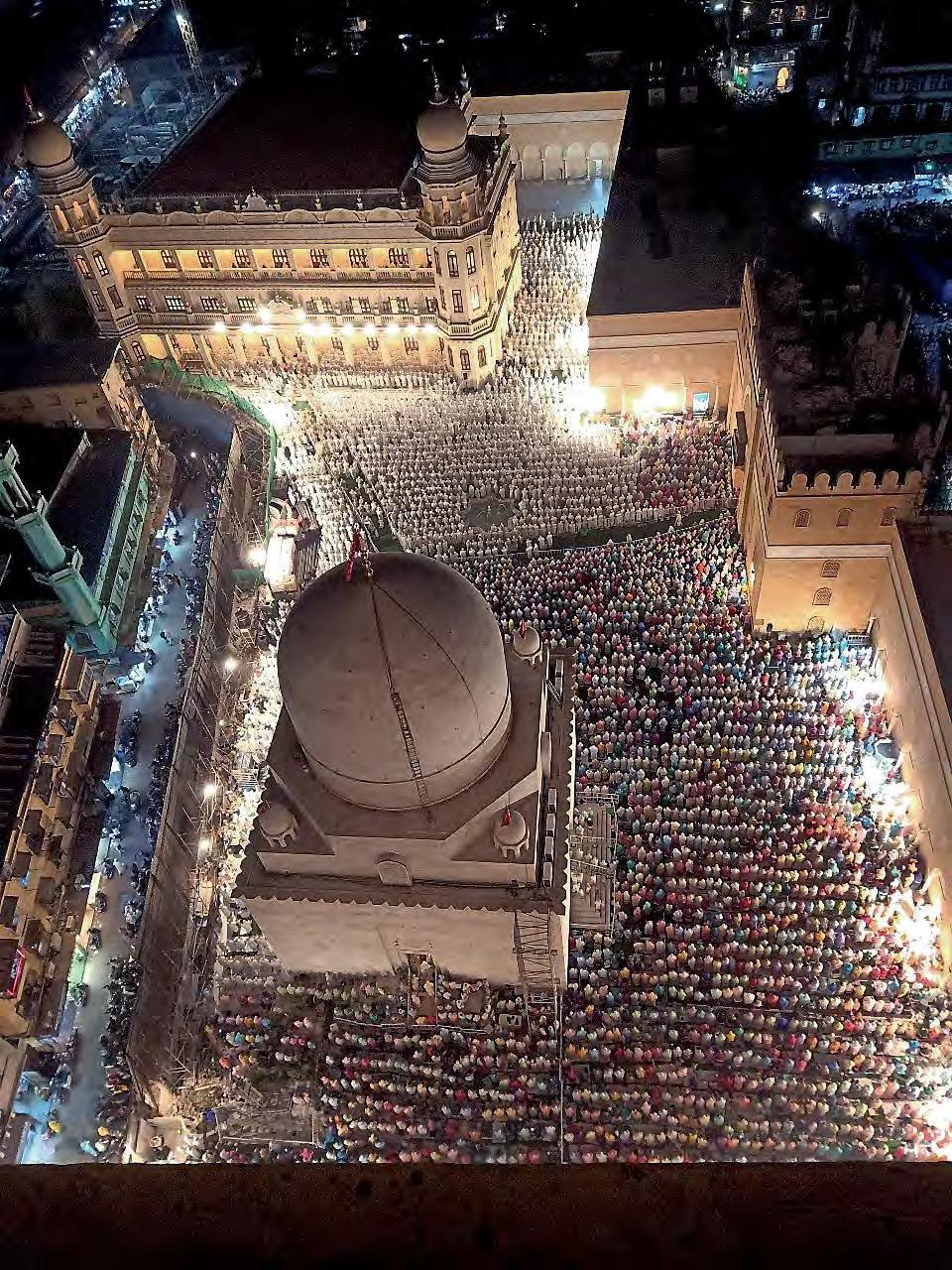

24 July–August 2024
PROJECTS
The masjid has been rebuilt exactly how it was before
Thousands of worshippers will fill the outside space of the masjid during special events
ISSPL’s Bhavin Sureliya
Burmese teakwood from the original masjid, known for its durability and beauty, has been reinstalled in the masjid’s doors, windows, columns and beams. The reconstructed masjid – which can accommodate 7,000 people – has been planned and designed to reduce its environmental impact as far as possible. The installation of a rainwater harvesting system along with a sewage treatment plant will reduce overall water consumption. The lights in the utility building opposite the masjid are powered entirely by solar panels and a decorative fountain and date palm trees provide natural shade in the courtyard between Saifee Masjid and Raudat Tahera, adding to the overall aesthetics and ambience of the complex. Over 150 shops surrounding the exterior of Saifee Masjid and Raudat Tahera have also been redeveloped as part of the project.
Mumbai-based Innovative Systems and Solutions Pvt Ltd (ISSPL) was appointed as the AV integrator for the Saifee Masjid project after a competitive tender process. “At the time, we were working on large project in Gujurat with a similar range of equipment, so we drove the client up there and looked at the site together. They received some

positive feedback on our work and how we were managing the project, and this helped us seal the deal. However, we were also awarded the contract based on our understanding of the technical requirements at Saifee Masjid and our commitment
The first phase of this project consists of the masjid itself, along with an administrative building and two residential buildings that share
multipurpose spaces, such as a dining area, a conference room and accommodation. ISSPL developed a comprehensive plan outlining timelines, milestones and resource allocation, beginning with the installation of the cabling

PROJECTS July–August 2024 WORSHIP AVL 25
to delivering high-quality results,” says ISSPL’s chief technology officer, Bhavin Sureliya.
The interior of the masjid is adorned with intricate embellishments
infrastructure, including power data and AV cables. The integrator was responsible for coordinating the different trades and disciplines involved in the project to ensure the seamless integration of the AV system. Following installation, ISSPL provided training sessions on how to operate and maintain the equipment effectively.
ISSPL worked alongside the ELV consultant for the project, Sachin Jain from Play Technologies. The masjid required a modular, flexible and scalable infrastructure that can accommodate increased capacity when required for larger events, incorporating features such as multiple input sources, configurable layouts and adjustable audio levels. Redundant systems and backup solutions were also required to minimise the risk of technical issues or interruptions during events. The equipment was carefully selected following technical specifications, budget constraints and client preferences, and by conducting comparative trials of different brands and models to evaluate performance, reliability and suitability.
“Everything was conducted through a competitive trial, so they had a shootout between the different speaker brands to see how everything would sound in the space because they had really high SPL requirements,” continues Sureliya. “When chanting, levels can go above 100dB, so the speakers needed to perform beyond that level. We liaised with the consultant on the system design so we were sure that what was being

“Previously, they had been using an analogue system so they were limited in the number of microphones they could use and also limited to the location of the microphones as well. Now, they can control everything over a single iPad with real-time feedback – they don’t have to go to a different location to switch a projector on, for example.”
Over 100 Lightware VINX series encoders and decoders have been installed across the site to capture audio and video content from various sources within the premises, such as cameras, laptops and other multimedia sources. The VINX decoders are also used to transmit real-time content from the masjid to the other buildings on the complex during live events. The decoders receive a multicast stream and display the incoming audio and video streams on local displays or projection systems, providing remote audiences with access to whatever’s happening inside the masjid. ISSPL has also integrated control protocols such as TCP/IP, UDP and HTTP for seamless communication between all control devices and endpoints over Ethernet.


proposed could be successfully implemented on the ground. The objective was to deliver an excellent project, so we worked closely with the client and the consultant to achieve the best end result.”
ISSPL has fitted 172 Tannoy CMS503ICT LP ceiling speakers, two Tannoy SAT-3 wall speakers, 12 Renkus-Heinz ICC12/3 column
speakers and four Tannoy VMS1 control room speakers in the masjid itself. Lab Gruppen E 20:4, E 10:4, E 12:2 and E 2:2 amplifiers, along with QSC CX-Q2K4, MP-A40V and MP-A20V models, power to the audio setup. The large microphone collection across the entire complex includes Shure gooseneck, wireless and wired handheld models, along
with Sennheiser handheld and Audix ambient units.
ISSPL has also integrated an Allen & Heath Avantis console into the AV system to be used as the central hub for mixing and processing audio signals. The Avantis comes with built-in effects, EQ, dynamics processing and routing options, to help the masjid optimise audio quality and enhance the overall listening experience.
A Q-SYS infrastructure is in place for broadcasting audio streams to other buildings connected to the network. ISSPL has configured Q-SYS components such as Core processors and network I/O peripherals to handle audio distribution and streaming. The masjid can also use the Q-SYS control software to manage audio routing and control any third-party equipment.
“Both Q-SYS and Dante give the masjid more flexibility and the ability to reconfigure audio channels, devices and routing paths depending on their requirements,” furthers Sureliya.
Blackmagic Design’s Constellation 8K switcher and ME4 control panel, along with Panasonic broadcast PTZ cameras with joysticks, enable the masjid to easily manage live events. The Constellation 8K switcher is the central hub for video switching and processing and can be used to handle multiple video sources, including cameras, computers and media players, with support for resolutions up to 8K.
Phase two of the project involves fitting a new AV system in the main outdoor area and in a new wing of the complex that is currently under construction. “In addition to the 7,000 people the masjid can accommodate inside, the outside area has the capacity to hold an additional 30,000 people. Currently, they have to hire equipment for special events if they want to use the outdoor area and we provide an audio and video stream from the inside to the outside equipment. The masjid holds large gatherings nearly every month so it’s not very cost-effective.”
Sureliya has received several messages from the masjid about how pleased they are with the new equipment and how excited they are that they can do things they’ve not been able to do before. “There were multiple changes along the way – the client made some suggestions that we discussed together which really helped optimise the system. They’re really pleased with the results and, in particular, the ease-of-use, flexibility and scalability of the setup.”
www.isspl.in
PROJECTS
26 WORSHIP AVL July–August 2024
The main area features Renkus-Heinz ICC12/3 speakers along with Panasonic AW-UE150K 4K PTZ cameras
The mausoleum forms part of the Bhendi Bazaar redevelopment project

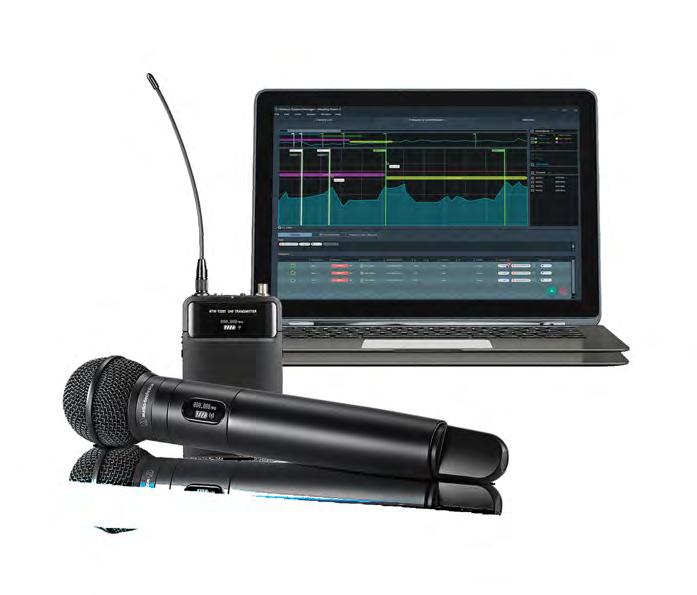
3000 Ser ies Net work Syste ms Scan,
Plan, Deploy and Monitor
• Class-leading, extremely wide 60 MHz UHF tuning bandwidth for maximum versatility
• Unique multifunction button on the handheld and body-pack transmitters can be used to switch to a backup frequency should interference be encountered
• Automatically adjusts squelch setting to maximize range while minimizing interference
• Optional network transmitter charging docks
•
• Frequency scan and IR sync for ease of setup Handheld transmitter offers industry-standard thread mount for use with six interchangeable A-T microphone capsules, as well as other compatible capsules
11 Ubi Rd 1, #06-01, Singapore 408723 Tel: +65 6749 5686 | Fax: +65 6749 5689 | sales@audio-technica.com sg | sea.audio-technica.com
300 0 Se ri es N etw or k systems are compatible with A-T Wireless Mana ger
Audio -Techn i ca (S. E .A) Pte Ltd

Moving mountains and travelling oceans
Transporting tonnes of delicate audio equipment by ocean freight is already a risk in itself, but when you have thousands of congregation members waiting for it, the price is that much greater
CHRISTIAN MISSION FELLOWSHIP
International (CMFI), headquartered in Suva on the island of Fiji, serves 120 countries across 5,000 churches globally and has a congregation reaching more than 30,000 worshippers. The World Harvest Centre (WHC) is the organisation’s main venue, which has the capacity to hold 3,500 worshippers, a full band, production crew and a 100-member choir. Since its construction in 1990, the centre has installed a variety of audio systems but none had been able to overcome the scale of reverberance that comes with a venue of this size. Head pastor Suliasi Kurulo decided it was time for change. The search began for a company that would not only provide a highquality system but one that would need to understand Fiji’s unique culture. It was clear that whoever undertook this project would require a deep level of understanding of what the church’s vision was for its members. After several CAD models and proposals were drawn up,
WHC awarded the project to Carey Leghorn from CVAV Australia based on a Martin Audio system. Leghorn, along with Anthony Russo from Technical Audio Group (TAG), made multiple visits to WHC to scope out the scale of the project and create a design suitable for the church’s requirements. Leghorn explains that this project was one of the most difficult he had ever worked on, due to the challenges posed by the size of the venue. “We faced several obstacles, from working at 15m heights for PA rigging to custom steel fabrication onsite. Additionally, we had to install several kilometres of cables through a complex roof structure. Most of the manufacturing had to be done in Australia with no room for error once the equipment had been put on the container and left port.”
Meticulous planning was required for the transport process – nothing could go unchecked, not even the smallest rigging nuts and bolts all the way up to the cabling and tools. Given the church’s significant

28 WORSHIP AVL July–August 2024
PROJECTS
The grand opening ceremony

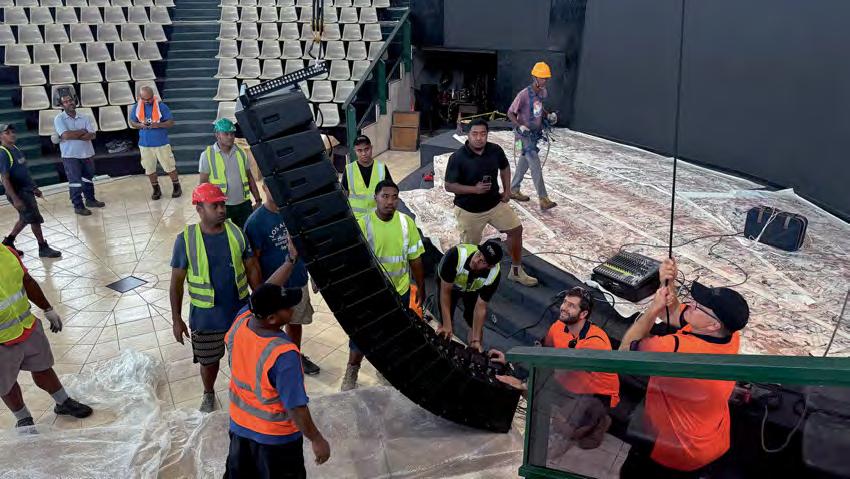
inevitable power alley and off-axis cancellations.”
financial investment in the project, WHC dispatched pastor Suliasi’s son and production manager Vatu Weleilakeba to Australia to inspect every item of equipment before it was dispatched to Fiji. Impressed with CVAV and TAG’s professionalism during his inspection, Weleilakeba comments: “I was able to review the frequency response of each speaker on paper before packing, and every electronic item underwent soak testing for over a month. Additionally, I could inspect the preassembled racks and was
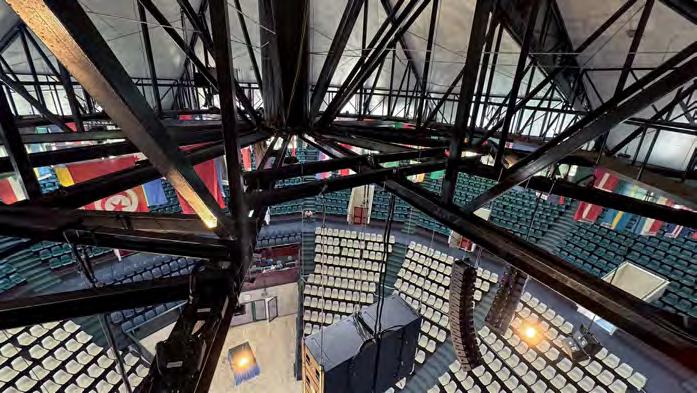

thoroughly impressed by the attention to detail that the team was putting into the project.”
After hundreds of hours of modelling, the final speaker design was based on a Martin Audio WPM line array system with processing and amplification from Q-SYS. The church team wanted to retain and improve some of the existing Q-SYS backbone and converge it with the Martin Audio system.
Russo takes up the story: “During my many visits to the church, I sat in on services and envisioned the aspects of the system design and how to conquer the space. I was emotionally moved by how much effort and love this space intertwines with every congregation member’s life. The services are like major concert events with 3,000+ people singing, supported by a full band and choir. Therefore, the system had to achieve higher than normal SPLs and provide a unique experience generally associated with an international touring act. I believe every seat needs to be
the best seat, all the while trying to keep an eye on the budget. There is a fine line where you can’t compromise.”
Martin Audio’s DISPLAY prediction software was used to design a 56-cabinet WPM system consisting of a main L-R hang of 16 WPM per side, along with 10 WPM per side operating in two-box and one-box resolution modes. The array system is supported by six Martin Audio SX218 18-inch sub-bass speakers, with each driver individually processed and amplified. Despite challenges posed by rigging and structural steelwork, the CVAV team was able to hang a centre cluster and allow the steering of the sub-cluster.
“Once I saw it hang together in place, it was a dream moment for me,” comments Russo. “It’s extremely rare to get subs in that position in churches, where projectors, site lines and roof weight loadings often constrain you. This results in compromised split left and right subs and the
For the choir stalls, CVAV selected eight individually amplified and processed CDD12 two-way cabinets from Martin Audio’s Coaxial CDD range, to ensure maximum coverage across the church. The main Allen & Heath S5000 dLive console also provides a tailored mix send depending on the needs of the choir. An eight-cabinet, 12-inch two-way delay system from Martin Audio’s BLX range was also installed to support the main system – while not essential, it enhances the overall experience for the rear of the congregation and optimises the coverage of the main arrays to the main seating area. There are also three CDD10 10-inch front stage apron speakers which provide coverage for the front of the congregation, and the stage is covered by a six-cabinet LE100 12-inch CDD foldback system. he main system processing is controlled by a Q-SYS Core 610 unit driving 17 Q-SYS 8K and 4K series QLAN amplifiers which were installed in two remote amplifier rack rooms. The 610 was chosen to provide reliability and sufficient processing power, especially with the large quality of FIR processing filters required, as well as to cater for the church’s future expansion plans. Netgear AV 4250 switches now handle all network traffic on Dante and QLAN protocols, and remote access is through a Lenovo NUC, which enables remote desktop access or reflect management from the Q-SYS servers.
The cable system uses both analogue and digital network feeds which run in parallel. With Q-SYS, two backup levels are in place – should a data cable be cut, spare A&B LAN lines are available. If there is a switch or core fault, Q-SYS allows all amplifiers to run in standalone mode. This means the analogue feed can take over, with enough onboard processing to ensure the service remains uninterrupted. Finally, a patch bay system was installed at every rack location for the main desk which allows any mixer or source to be substituted in an emergency.
“The complexity of the WHC system makes it challenging for users to identify faults, even with an engineering background,” adds Russo. “It’s nearly impossible to detect issues like one sub driver of 12 not working or the second box in a 16-way array is malfunctioning, particularly when the system is 12m
PROJECTS July–August 2024 WORSHIP AVL 29
Lifting the heavy equipment into place was no mean feat
The team had to battle heat and humidity working at 15m heights

in the air. However, detecting such faults can become significantly easier with the right software tools.”
Using Q-SYS, CVAV designed a touchscreen interface with specific test pages which allow WHC to conduct a stepped pink noise test on each speaker before the start of every service. Additionally,
to see a representation of the system and hear as each cabinet is checked, along with associated power meters and impedance readings. All Q-SYS amplifiers and peripherals are constantly monitored for health status and, if needed, email alerts are sent to TAG support in Australia.
WHC principal sound engineers
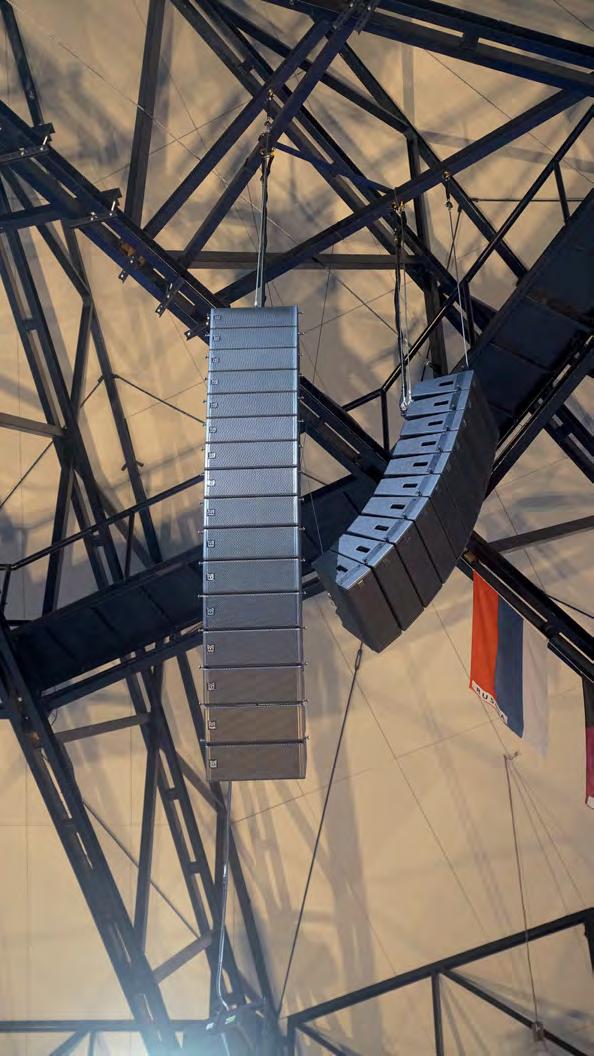

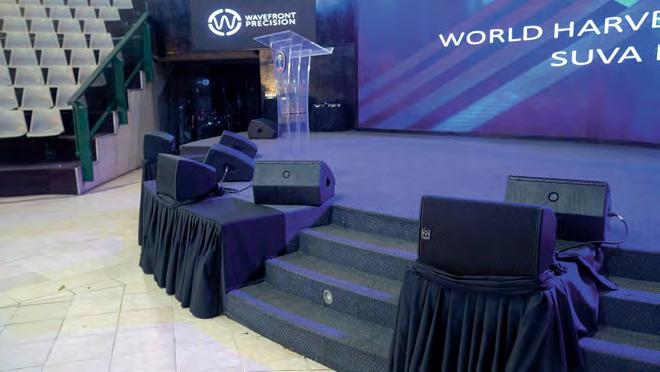











PROJECTS
L-R hangs of 16 and 10 WPM per side operate in two-box and one-box resolution modes
The WHC, CVAV and TAG team


to upgrade the existing consoles to an A&H S5000 dLive console with a 48-channel Dante rack. After reviewing dLive’s workflow and 96kHz capability, CVAV was able to convince the church to invest in the console. TAG’s Andrew Crawford was tasked with providing training in Fiji, with more than 50 attendees from various CMFI churches across the island invited for an intensive fourday training course in Suva. Despite a three-week timeline to coincide with Pastor Suliasi and the choir’s return from a tour in the United States, the installation was a complete success. The entire team –made up of CVAV and TAG staff along with church volunteers and 30 WHC crew members – battled sweltering heat and 90% humidity, working at 15m heights in full rigging harnesses.
With only a week left until D-Day, the team grew when Crawford arrived to provide dLive training for the local technicians and renowned electroacoustic expert David Gilfillan for system tuning and commissioning. Gilfillan spent four days meticulously analysing hundreds of computer measurements, double-checking each measurement and questioning everything, especially given the unusual space and system
complexity. Russo points out that only experienced ears can make the final decision on system balance. “A half dB here or there, or a fine ratio adjustment on a compressor, can make all the difference. Wellengineered systems, if aligned correctly, respond to even the slightest changes. Even then you need to keep checking what you think you hear versus what the measurement mic shows you.”
Finally, the church was able to celebrate the completion of their new sound system, with many island dignitaries in attendance joined by thousands more on the livestream. In an emotional speech, Russo praised the church’s vision and stressed that this project was not about cutting-edge technology and outstanding quality, but the congregation could now truly appreciate the sound of their musicians, choir and preachers, and, more importantly, know that their production team now had new education and skills that were invaluable for their future.
www.cvav.com.au
www.gilfillansoundwork.com.au
www.martin-audio.com
www.qsys.com
www.tag.com.au
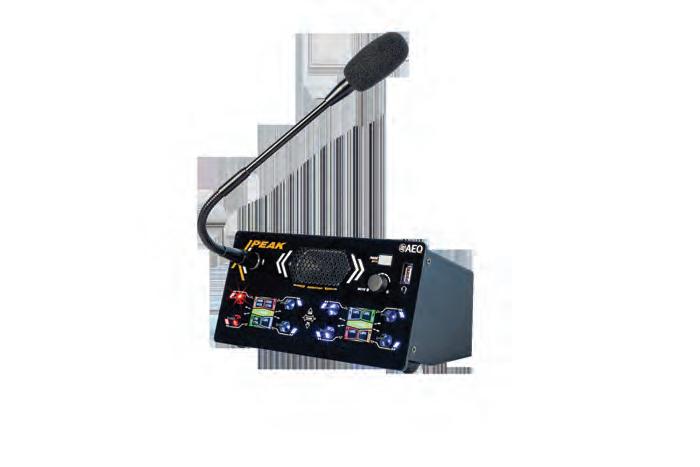



PROJECTS
July–August 2024 WORSHIP AVL 31 www.activeaudio.fr
The arrays are supported by six SX218 18-inch sub-bass speakers
The stage is covered by a six-cabinet LE100 12-inch CDD foldback system
Mic check
Five experts from Audio-Technica, DPA, Schoeps, Sennheiser and Shure share their insight for choosing the best microphone for the preacher

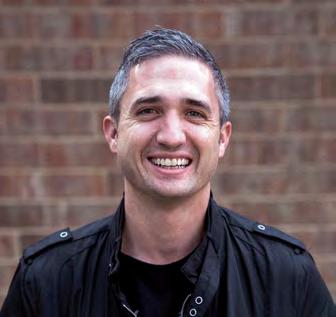
What considerations does a house of worship need to take when choosing a microphone for the preacher?



Chris Phillips, technical applications engineer at Sennheiser: The job of a worship leader is to deliver their message to everyone in the room but, these days, there can be members listening and watching via a livestream as well. Microphones are the first part of the audio chain that captures this message. Choosing the right type of

Alan Johnson, sales and business development at DPA Microphones: There are several the option of using a handheld?
DPA’s 2028 handheld vocal microphone can be used wired or wireless
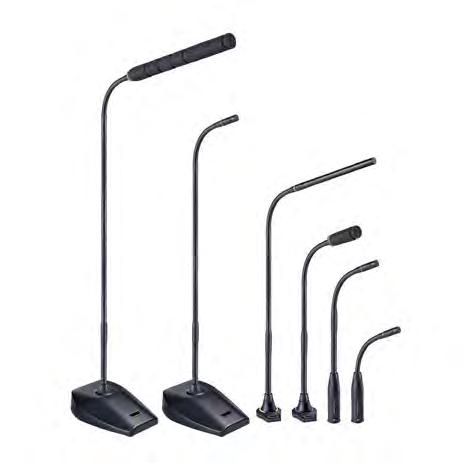
Audio-Technica’s ES925 comes in 12 different lengths and has four styles of connection
Florian Gundert, marketing manager at Schoeps Mikrofone: The most critical factor is the room and its acoustics, especially the reverberation time and microphone distance. The PA system also plays a significant role, in particular, the question of what sound pressure levels are required and how directional the system should be. In general, it is essential to consider the acoustic system as a whole.
a condenser or a dynamic mic – all these things need to be considered. Condenser microphones are more sensitive and have a wider frequency response, making them ideal for a preacher that has a subtle tone. However, they require external power, have a more fragile construction and are not suitable for high sound pressure levels. Dynamic microphones are more durable, can handle high sound pressure levels and are commonly used in live performances and broadcasting.
Adwin Lin, account manager, pro-audio national sales at Audio-Technica: Different religions and denominations will have unique requirements but the factors to consider are the position of the preacher (podium, stage, seated, kneeling), the size and shape of the sanctuary and the placement and type of speakers.
How important is the preacher’s style of worship in deciding the best microphone for the job?
FG: If a stationary microphone is used, a wider directional characteristic can be helpful – such as cardioid instead of super-cardioid –if the preacher likes to move around. With mobile, wireless applications,
some churches will often compromise on audio quality or pay a higher price compared to stationary solutions.
AL: A quiet, reflective preacher could choose a condenser gooseneck on the rostrum as the condenser will be able to pick up the nuances of the voice. A more animated preacher might select a wireless head-worn or lapel microphone so they can preach hands-free. Some houses of worship operate 16 hours a day, so a wired option might be favourable to avoid having to charge wireless products.
What factors do preachers need to consider if they are choosing a handheld model?
CP: When using a handheld microphone, you are putting the
KnowHOW
32 WORSHIP AVL July–August 2024
L–R: Florian Gundert (Schoeps), Alan Johnson (DPA), Adwin Lin (Audio-Technica), Chris Phillips (Sennheiser) and Vick Teoh (Shure)
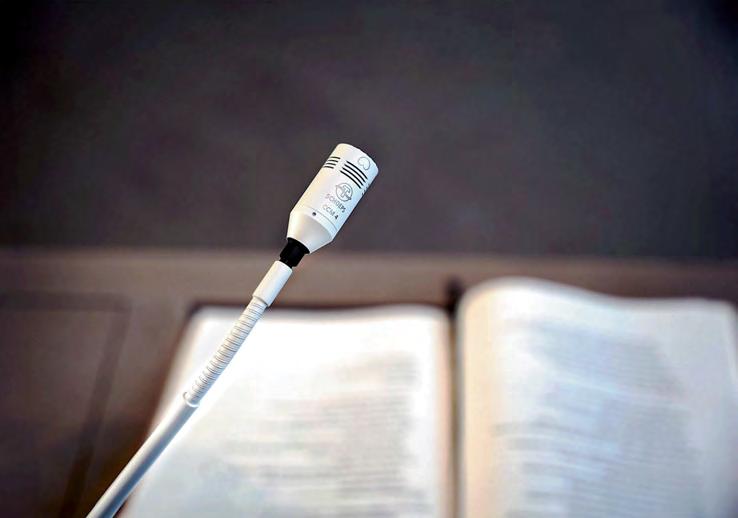
control of the capsule position into the hands of the worship leader. If you watch professional singers closely you can see them adjust this level on purpose by moving the microphone closer or farther away from their mouth. The first question to ask would be, “can the worship leader maintain that mic position and speak directly into the capsule, so every word is heard clearly?”
VT: Other factors to consider would be comfort and ergonomics, as well as durability. Microphones are likely to be used frequently in a house of worship, so it’s important to get a model that has durability to sustain drops without jeopardising the audio quality.
What are the benefits of a gooseneck microphone on the lectern?
AJ: A gooseneck microphone on a lectern can ensure proper mic placement every time. It is always in the right place, at the right height. It can be adjusted when it needs to be and stays in place. If chosen correctly, a gooseneck with the right
while reading text and notes on the lectern. If the worship leader prefers a lower-profile gooseneck, a mini-shotgun capsule can be used on a short gooseneck as it has a longer pickup. If there are likely to be different speakers, a longer gooseneck with a cardioid polar pattern can be adjusted to the individual’s height.
Does the loudness – or quietness – of the preacher’s voice need to be considered?
FG: There may be some restrictions if the volume of the ambient noise is louder than the preacher’s voice. In this case, the microphone position can be optimised or a more directional capsule can be used. The noise level does not play a part in this context when using highquality microphones.
AJ: The more limited a microphone is on the SPL handling, the more important it is to match the element’s capabilities to the voice of the preacher. Choosing a highsensitivity microphone that can’t handle the SPL of a loud preacher’s
more of the noise floor than you
Are there any clothing considerations that need to be taken into
choosing clip-on or headset microphones?
When placing a lavalier, the optimal position is over the presenter’s sternum or on the lapel of a jacket. If the microphone is higher, the chin will obscure some of the high frequencies and you can get some resonance from the throat as well. If the lavalier is placed too low, it will sound distant and you may not be able to achieve the right level. Use the cable holder in the clip to make a small loop which helps with handling noise.
VT: Visibility also needs to be considered, as some preachers might prefer a discreet microphone that blends in with their clothing.
Light fabrics also tend to sag easily. Headset mics are generally free from clothing restrictions making them one of the best options for a hands-free approach.
Does the shape and size of the sanctuary affect the choice of microphone for the preacher?
AJ: The shape and size of a sanctuary would generally only affect the choice if it’s an omnidirectional microphone, which is very open in its pickup pattern. If a preacher likes to go out into the congregation, a church should consider the pro and cons of omni versus directional microphones in relation to the PA.
FG: Attention should be paid here to how strongly the sanctuary reflects and how far the microphone is away from the person as well as the PA speakers. The capsule type should always be chosen based on that.

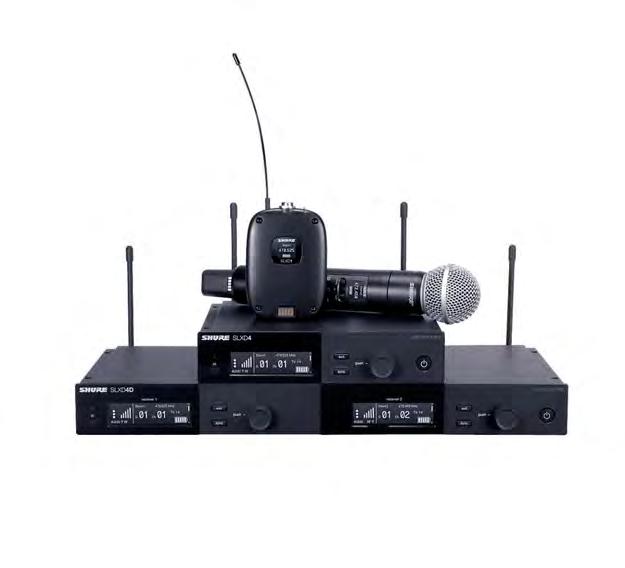
The type of microphone also goes hand in hand with the flexibility of movement during a sermon. If the preacher engages in active movements, gestures or physical interactions, a headset microphone can provide better mobility and freedom of movement while maintaining consistent audio pickup. Clip-on microphones may be more suitable for preachers who remain stationary or have limited movement but prefer hands-free ease of movement.
AL: If someone is wearing loose jewellery around their neck which moves around and makes a sound, this could be picked up by a clip-on microphone. Clothes with a high collar will also result in the mic being clipped too near to the throat.
AL: A small room with reflective surfaces will easily bounce the sound of the loudspeaker back into the mic, causing ringing and unfocused mic reproduction. A space with very flat ceilings and straight flat walls can also cause “slap backs”. A large space will come with its own acoustical challenges and may enhance certain audio frequencies even more than a mid-size space. Being aware of these acoustic issues will help worship leaders choose the best type of mic for their unique space.
www.audio-technica.com www.dpamicrophones.com www.schoeps.de/en www.sennheiser.com www.shure.com
KnowHOW July–August 2024 WORSHIP AVL 33
The EW-DX wireless microphone system from Sennheiser
The CCM4 gooseneck microphone from Schoeps
Shure’s SLX-D wireless microphone system

Adapting church services for a digital world
Media Mentoring’s Graeme Spencer answers the often-asked question – how long should my online service be?
THIS IS ONE OF THE QUESTIONS
I get asked the most frequently, and the great news is that I have the answer for you: “Aim for as long as you can keep your viewers engaged.”
So now that I’ve answered the question, let’s consider some further thoughts on broadcasting church services that will (I promise) help clarify the original question.
Since the Covid pandemic forced most churches to embrace online church, many have continued with this but have pivoted to a hybrid model, blending their in-person and online services. But is that the best approach?
The answer differs depending on how you answer one specific question you might not have considered before: who is your target audience? Are you looking at connecting only to people who are already in a
relationship with your church family, allowing them access to your service online because they can’t join you in-person? If so, broadcasting your in-person service online, what we might describe as 100% hybrid, is the right way to go, with the duration being identical to whatever your usual in-person service is.
If that is not the case and you want to reach a broader audience, consider a different approach. For a church with a more “outreach” vision, you might ditch the idea of a hybrid model and instead do separate in-person and online services. Of course, this will take considerably more work, but it can be a much more effective strategy to meet the differing needs of both your in-person and online audiences. A bonus could be that it can also draw more people back to
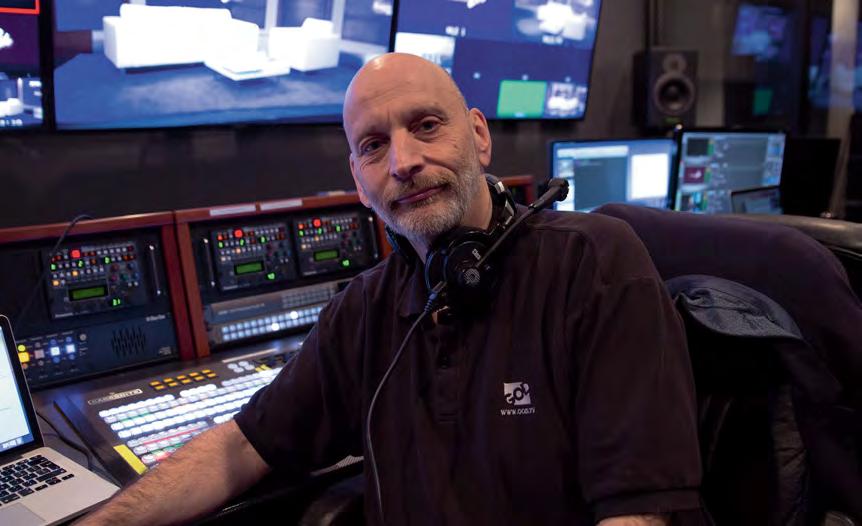
34 WORSHIP AVL July–August 2024
Broadcasting your in-person service online is a common hybrid approach Image courtesy of Oak Assembly of God/Sven Pro
Graeme Spencer
your in-person service if they can’t access it online anymore. I would urge more churches to consider this as it allows you to tailor the content to reach each audience best.
If you choose this approach, my guide on duration would be to aim for no more than an hour for your online service. I could also give you a compelling argument for an even shorter duration. The platforms you are streaming on might also impact the duration. If Facebook is your primary broadcast outlet, I would aim for a shorter duration than if you broadcast on YouTube. Facebook is a more challenging platform for keeping people engaged for long periods. The best thing to do, though, is to keep a close eye on the data for each platform and adjust according to the results.
Whatever your duration, the content must be compelling enough to keep people engaged. Quality rather than quantity should be your target. For instance, if you have a pre-recorded worship set of two or three engaging songs (performed, mixed and shot well), that is better than a 30-minute worship time that isn’t as good production-wise. More people will turn off (or disengage) if the quality of the content is poor. Quality is vital if you want viewers to stay with you.
Also, I would suggest you tailor the message or “preach” to the online audience. Shorten it from what you would do in-person so you keep people engaged. Also, add more stories as that will help draw people into the content more deeply, and I even recommend you think through how you “present” it, maybe adopting a more casual style. Also, avoid anything that is parochial that an online audience might not understand. For those

of you who want to get serious, I would also suggest you look at how to use video or graphics for extra illustration and engagement.
Here is another thought to consider. You don’t have to use identical content in-person and online – even if the main thrust is the same. Separating the two will enable you to craft content that works best for both. You don’t need to consider if a message you deliver
I always recommend adding some “presenters” who can draw in and engage the audience, which will pay significant dividends too.
If you can’t achieve two separate services aimed at different audiences, another option might be to work on a combination. Can you combine elements of your in-person service with new content produced for your online audience? You could take the previous week’s message
you get to allow you to hone the best offering. Also, if you are doing content only for your online audience, consider locating some of that content outside of your church building – it can certainly make your content more visually engaging. I realise this may sound like a lot of work, but I want to encourage you that if you are reading this, you must already take digital ministry seriously, so why not go “all in”?

in-person has too many “in jokes” for your online audience, as you can leave these out of the online version (that’s the kind of parochial content I mean above). You can even deliver a different, more relevant message to that audience. Re-purposing your content and messages can help you deliver the best content for each situation. The key here is understanding the audience you are looking to serve online.
You also need to ensure that your online service is interactive. Aiming to draw people into responding and (where possible) discussion and conversation is a great idea here.
from your in-person service and edit it for the next week’s online offering. You can then add in wellpackaged worship, some presenters to “personalise” the experience for your online audience and some engagement strategies to help connect with viewers.
There isn’t a wrong approach here; you can do whatever works for you, your team and (as the priority) your audience. With this kind of approach, you also get the benefit of being able to test different formats and durations. Then you can look at the stats, the data, the feedback and the comments
You might have already encountered some unique approaches to online church services that have resonated with you, so why not give them a try?
To recap, while you are aiming to keep your viewers engaged for as long as possible, that’s only part of the answer. The rest comes down to what you should include, and the driver for that is who you are looking to reach. I hope the thoughts shared here have helped you consider how best to use digital ministry in your church’s mission.
www.mediamentoring.net

KnowHOW July–August 2024 WORSHIP AVL 35
Filming separate content for online services can create more work but
is an
effective strategy for extending your church’s reach Image courtesy of GABC

Lighting looks – using colour to set mood
John Black considers the use of warm and cool colours and how both can set different moods during a service
NOW THAT YOUR LIGHTING grid is laid out, let’s start talking about building some lighting looks. A “lighting look” can be defined as what the stage lighting looks like at a specific moment in time. To translate it into “console-speak”, a lighting look would be a lighting cue, where that moment is actually programmed and saved into a memory on the console. For now, we’ll use the term “lighting look”. Visibility of what is happening onstage is most often the highest priority in a house of worship setting. When many non-lighting folk talk about lighting, they talk about what they can or want to see and what they can’t or don’t want to see. Visibility is most often taken care of through front lighting placed around the grid according to the McCandless Method as discussed in the previous issue. Therefore, I’m going to assume you have your front lighting taken care of and we’ll move onto one of the simplest qualities of light that you can use to generate mood and atmosphere in your lighting looks: colour. A multitude of studies have been conducted on the influence that colour has on emotions and human
psychological responses. Lighting designers have the ability to select and manipulate colour palettes in their lighting of services on a weekly basis –or even between different items in the worship programme. This gives the lighting designer the ability to influence and shift moods – one of the four functions of theatrical lighting –as appropriate throughout the worship experience.
Let’s walk through some of the characteristics and theories surrounding colour and how to use it to set mood in your services. Remember, when lighting a worship environment, the most important thing to keep in mind is to support and enhance the message being shared in the service. Lighting can quickly become a distraction but, when skillfully and artfully implemented, it can transform a space and the way that we experience it.
Describing colour –warm vs cool
For many, the discussion surrounding the lighting terms “warm” and
“cool” revolves mainly around the topics of lamp sources. The easiest comparison can be seen in that tungsten sources emit a “warm” light while fluorescent light sources emit a “cool” light. Many lighting manufacturers produce instruments using LED sources and give you the option of selecting a warm or cool option. These terms, while describing the colour temperature of the light source, are also describing the colour emitted by each source. Tungsten light sources emit an orange/yellow colour light while fluorescent light sources emit a green/blue colour light. Warm colours are those colours that exist on the left half of the spectrum of visible light, such as red, orange and yellow. These colours are described as warm because they cause most people to feel a sense of relative warmth. The right half of the spectrum of visible light, such as green, purple and blue, are described as cool colours. They cause most people to feel a sense of coolness. Perhaps the easiest way to think about whether an environment feels warm or cool is to consider
the difference in feeling when in a department store compared to a medical facility. The department store wants you to feel warm, welcomed and comfortable in that environment, while a medical facility wants you to feel a sense of sterility that we associate with cleanliness. In a house of worship setting, the feelings of being welcomed and comfortable are most often more desirable when a worshipper walks into the auditorium. The easiest way to achieve this is to ensure that the auditorium itself is lit with warm coloured house lighting.
The meaning of colour
Have you ever thought about the relationship between a colour and what it means to you? Every year, I present a lighting demonstration for elementary students. When talking about coloured light, I will wash the stage with a colour and ask them to tell me how it makes them feel or what it means to them. If I wash the stage in red, some will say that it makes them feel warm or think about love. Others will have seemingly opposite feelings about the same colour. In the case of red, they may think of the feelings of anger or hate.
KnowHOW
36 WORSHIP AVL July–August 2024
A cold blue light used for a production of The Snow Queen

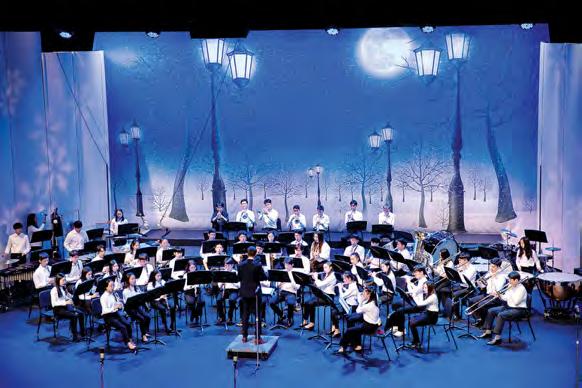

Just as two people can look at the same piece of art and have different reactions and interpretations to the work, the meaning of colour is very individualistic as shown in this example. There are some meanings, however, that are commonly accepted amongst lighting designers, and these can usually be relied upon when trying
The range of warm colours typically evoke stronger moods and feelings. The colour red, as shown, often conveys love, affection, excitement and intensity. At the same time, it can also convey hostility and aggressiveness. The colour orange conveys warmth, excitement and happiness; but it can also evoke feelings of being distressed or disturbed. Yellow can convey cheerfulness and joy but, like red, aggression and hostility.

In addition to colour washes on the stage, I like to wash the auditorium area in coloured light as a way of further establishing mood. Some new facilities have the ability to do this through coloured LED auditorium lighting.
In contrast, the range of cool colours typically convey more peaceful moods and feelings. The colour violet often conveys dignity, but also sadness and melancholy. The colour blue conveys coolness, pleasantness and tenderness, but it can also convey sadness. Green often conveys leisure, security and freshness, but also illness.
What often separates the way that a person interprets these colours is the direction from which the light is focused and illuminates a subject. In houses of worship, coloured lighting is most often used as back or top colour washes of either the stage or auditorium, or both, so some of the more negative interpretations of colour are less likely.
Using colour
The specific tools available to you will vary depending on the lighting equipment that you have available
in your particular venue but, if your lighting rig is relatively new, chances are you have LED colour-mixing instruments or tungsten instruments that feature colour wheels or a CMY colour-mixing system (in the case of moving lights). These tools are great in that the colour parameters can be programmed and recalled directly from the lighting console. This also means that you have the flexibility to change colours throughout a service if desired. For example, you may want to use a particular colour during the worship music to set one mood and then transition into another colour during the message. These types of instruments also are beneficial in that because they mix colour, you have the freedom and flexibility to dial in very specific hues and saturations of colours as desired.
If your lighting rig is older, for example made up of conventional instruments such as tungsten ellipsoidal, Fresnel or PARs, it may be that colour is added through the use of colour filters (or gels). The advantage of using gels is that they
are inexpensive and usually easy to obtain. Several companies produce large catalogues of gel colours from which to choose. The disadvantage to using gels is that you will need to live with a gel placed in an instrument for the duration of a service as you won’t be physically changing gels over the course of a programme. Also, if your goal is to have your stage washed in three colours but you only have conventional instruments, that means you have three times the quantity of instruments dedicated to providing colour washes.
Examples
One technique that I like to use, especially if the auditorium is larger, is to use coloured lighting to help create a more intimate space and connect the auditorium with what is happening onstage. This can be achieved through using the interior walls and ceiling of your space as surfaces onto which you can project coloured or textured light that matches what is visually happening on the stage.
Another technique is to place lighting instruments on the stage itself behind any musicians or presenters and use coloured light focused up and out over the worshippers’ heads as a way of drawing them in. If your worship space uses haze, this will allow you to use coloured light to wash the “air” in colour, further establishing a particular mood that you are trying to portray through the music. This probably isn’t a technique that you would employ during the message or speaking portion of your services, but it can be effective in corporate service items.
In conclusion
As you are approaching a service, begin by defining the desired mood that you are wishing to convey, whether that be throughout the entire service or individual portions. Consider if that mood is best achieved through the application of warm or cool colours. Once decided, select specific colours whose meaning and colour temperature supports the mood that has been defined. Read through studies that discuss human interpretations of colour and look at images of lighting that others have used to get inspiration. Finally, implement the colours you select into your rig by whatever means you have available. In most circumstances, many worshippers won’t even notice the lighting decisions that have been made as a part of this process. But if carefully and thoughtfully selected, they will feel it.
KnowHOW July–August 2024 WORSHIP AVL 37
A blue wash of light is used to reinforce a cold winter night during a band concert
Blue, green and purple are used during a production of The Imaginary Invalid
Red and bright white light are used to created intensity for A Wrinkle in Time
The Church Sound & Media Summit
Taking place on 27 and 28 September, the Church Sound & Media Summit will welcome sound engineers, media teams and technology enthusiasts to Nottingham.
Organiser Dan Bowater
Where did the idea for the event come from?
I grew up with a church background –my Dad was a musician and worship leader. By the age of 16, I was travelling around with him and training people on sound and how to use microphones and other equipment. I studied sound and video technology at university and I stayed connected with church events such as New Wine and Spring Harvest. It didn’t take me long to realise that there were people out there who hadn’t had the same opportunities as I’d had and the ability to learn at a young age. Eventually, I got the opportunity to move to the US where I worked with the International House of Prayer which had nearly 30 sound engineers on its team. I was asked to train them and oversee their sound department, although it was pretty tough training sound engineers who work on a 24/7 basis – it was like trying to change the oil on a moving car. So I returned to the UK in 2016 and discovered that the industry landscape had changed, so
manufacturers. Our debut event in 2018 attracted nearly 200 people.
How did you continue operating during the pandemic?
During Covid, we stopped – we couldn’t meet in person but we created an online event so that people
Covid years. In 2023, we expanded the event to be the Church Sound & Media Summit and included lighting for the first time. We had closer to 300 people from right across the board –people brought in teams, some came on their own and we had support
I wanted to subsidise it with the exhibition side of things to keep ticket prices down, to get as many people as possible. We also allowed people to sponsor the event and we gave away some tickets through Facebook.
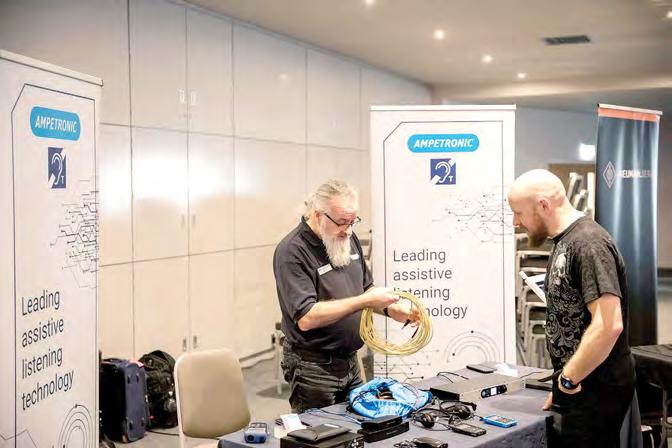


Is it the only event in the UK of this kind?
Sennheiser and Audio-Technica. We’ve
I think so. It’s specifically for the technicians; other events are designed more for worship leaders and others like the Christian Resources exhibition which covers everything inside the church such as the pews rather than just the AV equipment. We are getting some interest from other organisations too. We don’t just cover the practical things – we do team building, how to facilitate conversations with leadership if the equipment is breaking and there might be some pushback, etc. I also want to cover things like mental health and wellbeing.
Who are the main speakers at the event?
We have been very fortunate and had a great mix of different speakers
SHOW REVIEW
38 WORSHIP AVL July–August 2024
Visitors are able to get hands-on with the equipment
Dan Bowater welcomes the speakers to the stage
and producers. Last year, we had Les Moir (producer, musician) who worked for Integrity Music, and he talked about us being a key group of people within the church setting and how we can help each other out. We also had one of the board operators on the Eurovision team last year; we aim to get inspirational people. They might not be working in a church every week but it’s part of their life. We also have speakers from some of the manufacturers who come and do an overview of certain



people who may have a little mixer with two mics on it and a laptop doing the video. But it’s so important that we provide access to all those kinds of people and encourage them.
Who have you signed up for this year’s event?
So far, we have Sennheiser, L-Acoustics, Hollyland, EM Acoustics, Pro-light Concepts and Rational Acoustics booked in, and there are also several manufacturers, including a couple of playback system companies, which I’d like to highlight this year. A lot of

churches use backing tracks –where you can live interact with the tracks so you’re not tied to a set arrangement. Also interested are Cosmic Ears and Alclair which make in-ear monitors. A few manufacturers have contacted me to say they have heard about the event and they’d like to get involved, like Panasonic, which will be a keynote sponsor, along with Chauvet Professional and ChamSys. I think once people see or hear about the event, it sells itself.
Are you trying to achieve anything different this year?
I think growing the event and the partnerships are key and I’m already talking to Worship Exchange in Bradford and MXU which is the American equivalent of what we do here. They put on this huge show, tour around America and create video content. But, at the moment, we don’t have the team of people necessary to do something on the same scale, so I think for now investing in and expanding this event are the main priorities.
www.thechurchsoundmediasummit.com

SHOW REVIEW July–August 2024 WORSHIP AVL 39
Talks are held across the two-day event
displaying its assistive listening solutions C M Y CM MY CY CMY K HH TNi WPRO Print AD (143x210) WAVL_Bleed.pdf 1 03/05/2024 16:59
Ampetronic

NAB 2024
John Porterfield reports from NAB 2024 which kicked off its 101st year with over 65,000 attendees in Las Vegas to learn about and discuss the latest tech and innovations, particularly in the HOW livestreaming sector
THIS YEAR’S NAB SHOW featured nearly 1,300 exhibitors from 41 countries including powerhouse brands such as Adobe, AWS, Blackmagic Design, Microsoft, Ross Video, Sony and more. There was certainly no shortage of topics to learn and discover, covering Generative AI, VR and AR, new camera tech, cloud solutions in broadcast and production, SMPTE 2110 to NDI, audio and streaming. As one seasoned industry executive in the PTZ and livestreaming market space observed, “lots of people who came by our booth and others we met were first-time visitors to the show”. I would concur with this viewpoint –I felt that there was a new level of interest this year as visitors try to identify trends, discover new tech production and learn more about where the industry’s going next and who’s doing or leading the conversation.
The Creator Economy
One major focus this year is what has been termed the “Creator Economy”. This is a fast-growing segment that includes content
creators, influencers, YouTubers, podcasters, bloggers, artists, musicians, writers and others who earn money from their digital creations. According to one estimate from the NAB Show’s press facts: there are 50 million global creators now, and this is expected to grow 10–20% over the next five years.
Many vendors offer solutions now specifically designed to help support content creation in a variety of ways, such as Insta360, Røde Microhones, Small Rig and livestreaming solutions from companies like LiveU with its Solo Pro. LiveU hosted a specific day at the show just for content creators featuring a manufacturer called Unlimited IRL that has developed a backpack with everything needed to stream in real time.
AI
While AI has been around for a while in some form or another, one big topic is how quickly the technology is developing and the challenges of how it’s used, plus where it’s going next. AI or “generative AI” workflows were discussed at the show in

terms of production workflows and use cases such as livestreaming monitoring, transcribing and captioning, to image quality improvement from older forms of video.
We are already seeing AI being used more in short-form video content being posted on social media such as Opus and Descript, to larger platform players like Zoom. This is a growing topic, and there is a video-on-demand section of the NAB website where you can watch
highlights and events from the show to learn more.
AR/VR
Like AI, this is a growing segment –there were more companies this year showcasing new solutions and workshops then in previous years. Much discussed were Apple’s Vision Pro headsets, its iPhones with the ability to record spatial-based video (a form of 360° video) and new cameras from Insta360. There’s
SHOW REVIEW 40 WORSHIP AVL July–August 2024
An interview between Office Hours’ Alex Lindsey and LiveU’s Steve Wind-Mozely
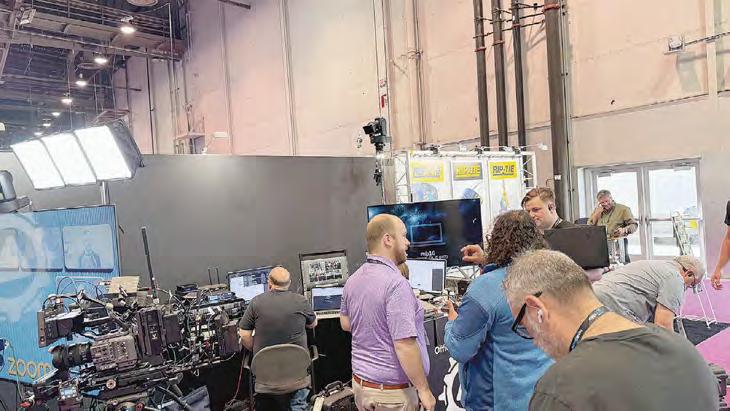
also a growth in post tools to stitch, manipulate and edit 360° material, such as Adobe Premiere Pro, Blackmagic Design Fusion (within Resolve), Apple’s Final Cut Pro and Insta360 Studio.
Video production
If there was one a video highlight at NAB, I’d say it was focused on the growth of PTZs to support remote production work, with updates from key brands such as Blackmagic Design with the URSA, along with Sony, RED and ARRI. BirdDog showcased its X1 camera, while PTZ Optics highlighted its new PTZ management tool called Hive which can remotely manage the cameras.

Ross Video, Grass Valley, Vizrt and Blackmagic Design showcased their latest video production wares for live to postproduction editing. A key highlight from Blackmagic was their announcements on continued support with SMPTE 2110 solutions, SRT in cameras, Cloud storage and editing tools to support Resolve workflows. Another
were another main highlight of presentations, workshops and live activities showcased by vendors. Many attendees are now looking at solutions to help them offset higher costs and leverage solutions to support them, sometimes via a fully cloud-based production solution from companies such as LiveU with its LiveU Studio, Vizrt, Ross Video
One highlight came from the Office Hours Global Team. This is a group of experienced professionals from around the broadcast and streaming industry who host a two-hour daily show on YouTube and their website
the show along with other guest interviews. The event used Unreal Engine for the tile setup with a screen view of panellists, Sony’s FR7 and FX6 cameras, Vislink was enlisted for the local network setup and a LiveU backpack helped coordinate the interviews on the show floor.
Streaming
Livestreaming was front and centre in many ways, from the software to the hardware, how cameras stream and how there is a broadening support for SRT for live feeds. Streaming is quickly developing to offer more ways to create, produce and deliver live events. Atomos announced that its new solution, Atomos Live, will also support SRT as well as other formats. SRT is fast becoming the transport of choice for low-latency delivery for site to site, publishing into streaming services and even audio mixing for
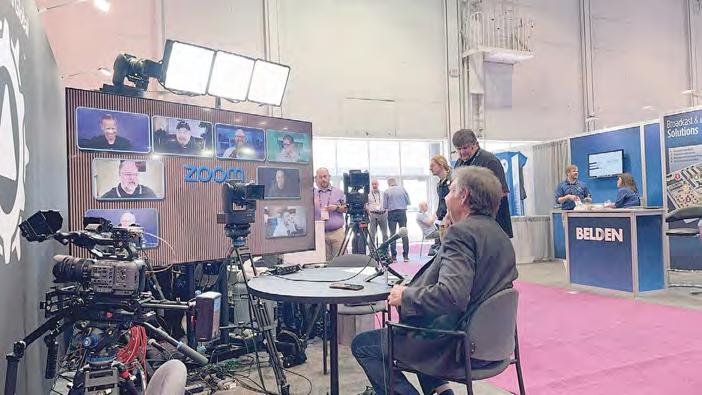
key takeaway is the increased importance of AVoIP and solutions such as NDI, IPMX, Uncompressed 2110 and SRT.
Cloud and remote production
Given the state of local and global economic conditions, cloud production tools to produce or remotely manage live events

During NAB, the Office Hours team hosted a live three-hour show each day with guest interviews, and even had a team going around onto different manufacturers’ booths to give people who couldn’t attend the show the chance to see what was new at the exhibition. What made this whole experience unique this year was a global panel that was brought in using Zoom ISO to speak live with people at
Zoom made several announcements with vMix and Ecamm, along with how the platform is evolving to support a variety of needs in video and providing a cleaner integration between the vendor tool and its services. Producing in the cloud was also highlighted, particularly from Vizrt, LiveU, AWS and others. Along with LiveU Studio, the company showcased its ability to create highquality production supporting live video feeds, remote guests, graphics and replay features, specifically focusing on how anyone can run the feed from anywhere. Automation was another area of streaming with vendors such as Epiphan highlighting ways to automate workflows and manage live events remotely.
nabshow.com/2024/explore/video social180group.io


SHOW REVIEW July–August 2024 WORSHIP AVL 41
The Office Hours team hosted a live three-hour show each day with guest interviews
Zoom ISO was used to bring in a panel of guests to speak live with people at the show
Automated lighting

George Masek, Claypaky lighting designer, relations and product specialist for North America, discusses how advances in technology
have provided more options for houses of worship
AS THE HOUSE OF WORSHIP market segment continues to grow around the world, so has the complexity of its needs. Bigger worship spaces, more complex services, special events, large musical presentations and the need to have broadcast-quality lighting are just some of the requirements these customers now have. The vastly increasing size, complexity and power of televised and live performances they experience in daily life has caused parishioners to desire this in all live presentations – even those in houses of worship.
Lighting fixtures need to powerfully and quietly illuminate both the messengers and the congregation as well as the inspirational spaces they worship in. Recent advancements in automated lighting technology now allow for nearly silent and, in some cases, completely fan-free operation of lighting fixtures – the advent of this technology has opened the door more fully for use in houses of worship. Silent operation is a key feature because at the heart of almost every service is the power of silence while the audience quietly reflects on their
thoughts, prayers and the message they are receiving.
With many products being fully automated, designers and programmers may use them for multiple tasks in the same service – quickly and quietly making changes and adjustments instantly as needed. Because the fixture attributes are all controlled from a lighting console, there is no need for staff to climb ladders or catwalks to make the adjustments. This is especially important for facilities that use volunteers to help with lighting. Each year, automated lighting becomes more common, easy to use and interact with, and more reliable. Simplicity of control also benefits the spaces staffed by volunteers in that choices are easily made, corrected and adjusted while the user learns the art of lighting their venue. Remote control of the lighting for the entire facility is key for both speed of programming and user safety.
Image magnification has become commonplace at concerts, in classrooms and for corporate events, and many houses of worship now have the need for quality lighting to assist in this area. Audiences

Lighting fixtures need to powerfully and quietly illuminate both the messengers and the congregation

have come to expect quality imagery – as houses of worship grow considerably larger, it is also vital that the whole congregation can see the service – even those in the back of the facility.
Additionally, venues often plan more and more special presentations and musical productions to enhance their services – Easter and Christmas services are just two examples of productions that seem to grow in size and complexity each year. As the monthly schedules fill up, the need to quickly transition between lighting for normal weekly services and that of a special event or musical production becomes paramount. Last-minute changes required to support a wedding or the addition to the choir are easy to contend with if you have a modern lighting system. Automated lighting makes this process quick, simple and efficient.
Lastly, many houses of worship now have youth programmes more focused on music and live performance activities to spread their messages. Youth music ministries benefit tremendously from special lighting and there is
Claypaky’s HY B-Eye K25 Teatro is a special version of the HY B-EYE K25, designed for venues that need silent operation
a need for cost-effective fixtures that add excitement to these programmes without becoming too complex or expensive for the facilities that use them. Of course, older members of the congregation always appreciate a service that is easy for them to see and hear. Quality AVL systems that are wellplanned and implemented benefit everyone in the community.
These days, worshippers of all ages have a higher expectation of quality production values. Quality automated lighting and clear image magnification along with a crystal-clear audio system are elements they have come to expect based on their experiences of live performances as well as their interaction with television and film. You need to look no further than the advanced home AV systems that some people have to realise they will expect a similar quality encounter where they choose to worship. A complete, high-quality AVL package works in unison to make the experience of every user – and worshipper – impactful, impressive and, in the end, more inspirational.
www.claypaky.it/en
TECHNOLOGY 42 WORSHIP AVL July–August 2024
Illumination of a house of worship using the Claypaky Odeon Flood

HIGH DEFINITION SOUND

HL 6 SYSTEM THE SIZE YOU REQUIRE. THE POWER YOU DON’T EXPECT.
Discover the power of the RCF HL 6, an ultra-compact speaker system designed for maximum impact in diverse settings. Alongside the HL 35-S flyable subwoofer, this lineup delivers exceptional sound across the spectrum with a minimal visual footprint. Efficiently powered by a single XPS 16K amplifier for up to 6+6 HL 6 arrays and 3+3 HL 35-S subs, it ensures seamless integration and superior audio performance in a surprisingly lightweight package. The HL 6 system adapts effortlessly to your environment, providing clarity and coverage beyond expectations for such a compact setup.
Visit us at InfoComm | Booth 9535 - Demo Room N101
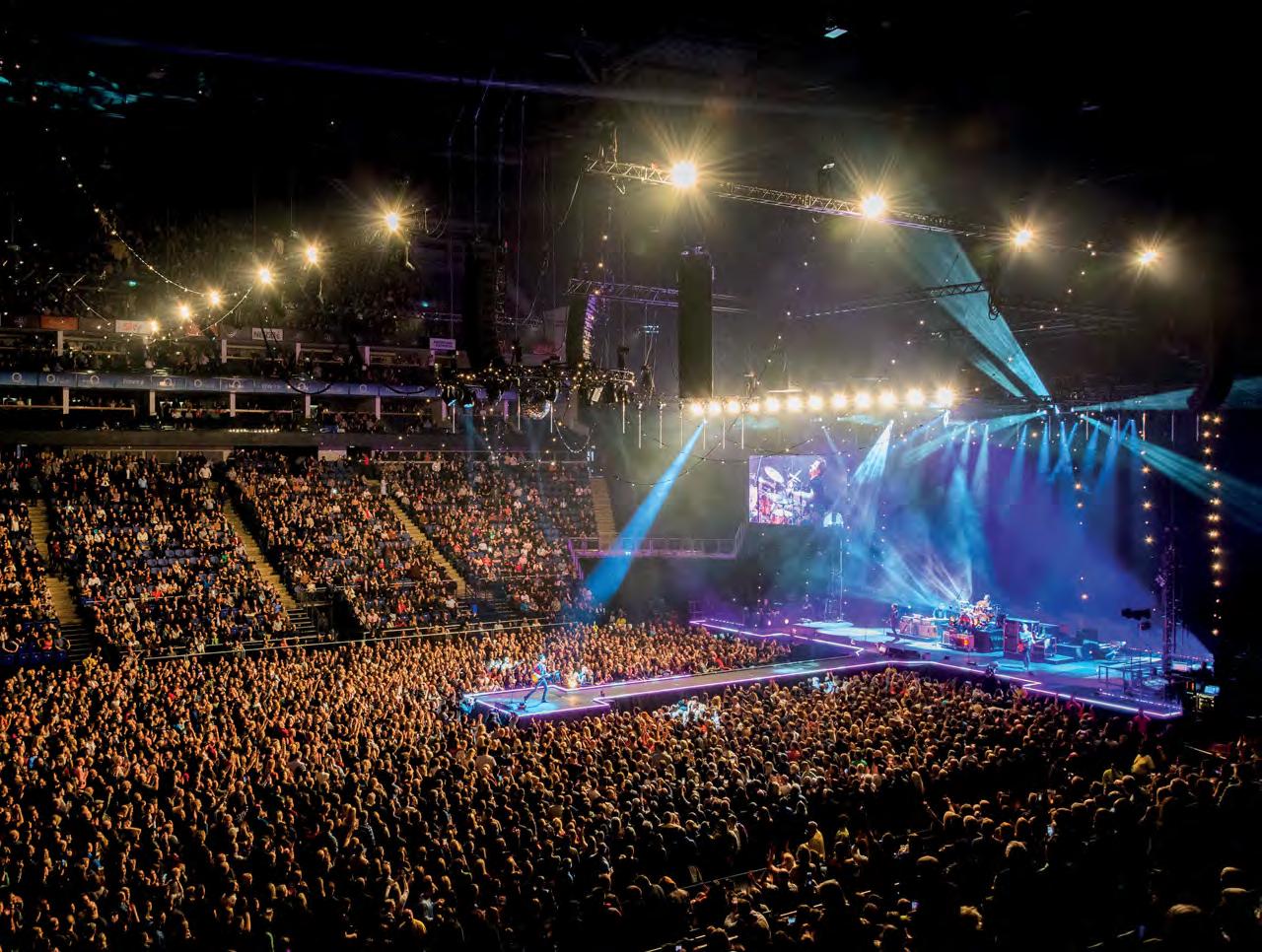
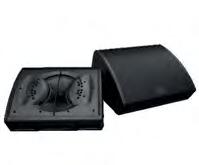
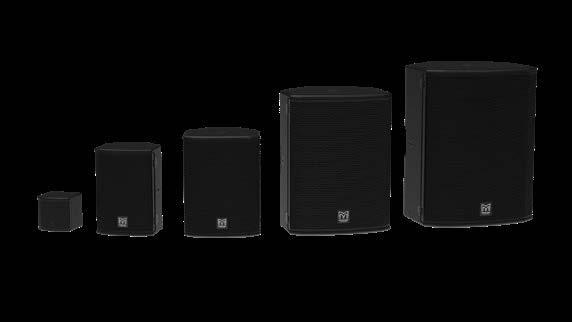
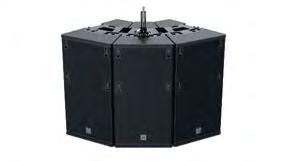

UNITE YOUR AUDIENCE Unite Your Audience The Martin Audio Experience Our philosophy isn’t just a motto, it’s the guiding principle behind everything we do. Our systems deliver signature sound with coverage and consistency that truly connects the fans and the artist. martin-audio.com STAGE MONITORS
NEWPRODUCTS

Audinate goes pro
The Dante Pro S1 offers an alternative to the Ultimo chip for OEMs building low channel count devices
AUDINATE HAS announced the release of the Dante Pro S1, a compact and cost-effective systemon-a-chip (SoC) for professional audio and AV equipment manufacturers to integrate Dante network functionality in low channel count devices. The Dante Pro S1 is designed to meet the evolving security requirements for enterprise Internet-of-Things (IoT), Unified Communications (UC) and advanced audio system implementations. The chip solution provides a platform for new features such as media encryption. The Dante Pro S1 offers an alternative to the Ultimo chip for OEMs building low channel count devices. New designs are encouraged to use the Dante Pro S1 as it will provide future features and capabilities that may not be supported by Ultimo-based products.
The Dante Pro S1 is designed for compact and power-efficient audio equipment solutions requiring Dante network interoperability. The chip is a TFBGA100 package (8mm x 8mm) and requires minimal external components to complete system integration. The underlying microcontroller is
more power efficient than previous Dante solutions, resulting in low-heat dissipation for space-constrained equipment designs. It comes in multiple package configurations to meet the exacting requirements of OEMs. The configurations are said to support up to 2x2 channels at 96kHz or up to 4x4 channels at 48kHz audio encoding.
An evaluation kit is available for equipment manufacturers to prototype system designs using the Dante Pro S1. The kit is based on the Dante Pro S1 reference design and includes XLR connectors for analogue I/O and swappable network interface modules for a range of PHY and switch ICs. Audinate has also announced that Dante Director, an SaaS solution for remote Dante network administration and management, is available as a pre-release beta. Dante Director enables management of Dante networks from a simple, convenient web dashboard accessible from anywhere.
Designed to meet the needs of users with small and medium-sized Dante networks, Dante Director enables IT

and AV administrators to remotely configure Dante channel subscriptions, control user access, ensure network security and monitor multiple Dante networks from a single account.
Dante Director joins the Audinate suite of products that bring professional management to AV solutions and includes Dante Domain Manager, which serves enterprise and onpremise network management needs.
Dante Director works closely with Dante Controller to enable remote AV management capabilities. After initial setup, users can remotely access
and manage channel subscriptions for networks managed by Dante Director from any location. Remote management capabilities are critical for IT and AV administrators and service providers who need flexibility to diagnose, repair and monitor AV networks. With Dante Director,
can manage multiple AV networks from a single web dashboard, providing faster response times, increased flexibility and better peace of mind through increased monitoring.
July–August 2024 WORSHIP AVL 45
admins
www.audinate.com
AMX N3300 Series 48 Analog Way Solo 54 Audinate Dante Pro S1 45 Audio-Technica ESW-R4180LK 48 Avolites Diamond 7 57 Ayr ton Kyalami 54 Blackmagic Design Videohub 120x120 12G 53 BSS Soundweb OMNI 51 Chauvet Professional Strike Array 4C 57 Claypaky Volero Cube 57 CODA Audio LINUS6.4-iD 50 DA S Audio ARA-P12.74 47 Di GiCo Fourier Interface Card 51 Dynacord V600:2 50 Elation SIX+ PAR S 55 Electro-Voice ZLX G2 48 ETC ColorSource PAR jr 55 Fohhn Focus Slim 47 HH Electronics Tensor-MINI 46 Hortus Audio Otarkio Series 46 JB L Venue Synthesis 52 KV2 Audio EX28 47 L-Acoustics Xi Series 47 LD Systems MAUI 11 G3 MIX 46 Lec trosonics Duet for B1C1 frequency 51 Listen Technologies/Ampetronic AURI 49 MA Lighting grandMA3 v2.0.0.4 54 Mar tin Professional MAC Viper XIP 56 Neumann.Berlin Monitor Mission 49 NEXO nanoNXAMP4 50 Robe iBOLT 56 Robert Juliat Tristan 56 Sennheiser Headmic 4 50 Shure ADX3 52 Stagetec NEXUS V2.0 52
A–ZCONTENTS
AV • LIGHTING • LIVE SOUND • INSTALLATION • BROADCAST • RECORDING
Dante Pro S1
LD Systems adds integrated mixer to MAUI
WITH THE release of the MAUI G3 series, LD Systems claimed to have set the sound benchmark for compact column PA systems in delivering a portable PA package. Now, the manufacturer is expanding the series with the MAUI 11 G3 MIX and MAUI 28 G3 MIX models, which further extend the solution’s application possibilities with the integrated digital six-channel mixer, onboard effects and wireless remote control via a smartphone or tablet. These are said to make the MAUI G3 MIX an all-in-one solution for users who don’t want to bring a separate mixing console to their events. The MAUI G3 MIX series combines
integrated digital six-channel mixer offers four XLR/line combo inputs for connecting microphones, line devices or high-impedance instruments (Hi-Z available on channels 1 and 2), supplemented by a stereo Bluetooth connection on channels 5 and 6. In addition to the System Out for connecting an additional subwoofer or other equipment, two Monitor outputs are available for connecting up to two monitors and supplying each with its own mix. Two MAUI G3 MIX can also be connected via the SysLink connection to double the number of channels. The variety of connections is rounded off by a footswitch input for hands-free
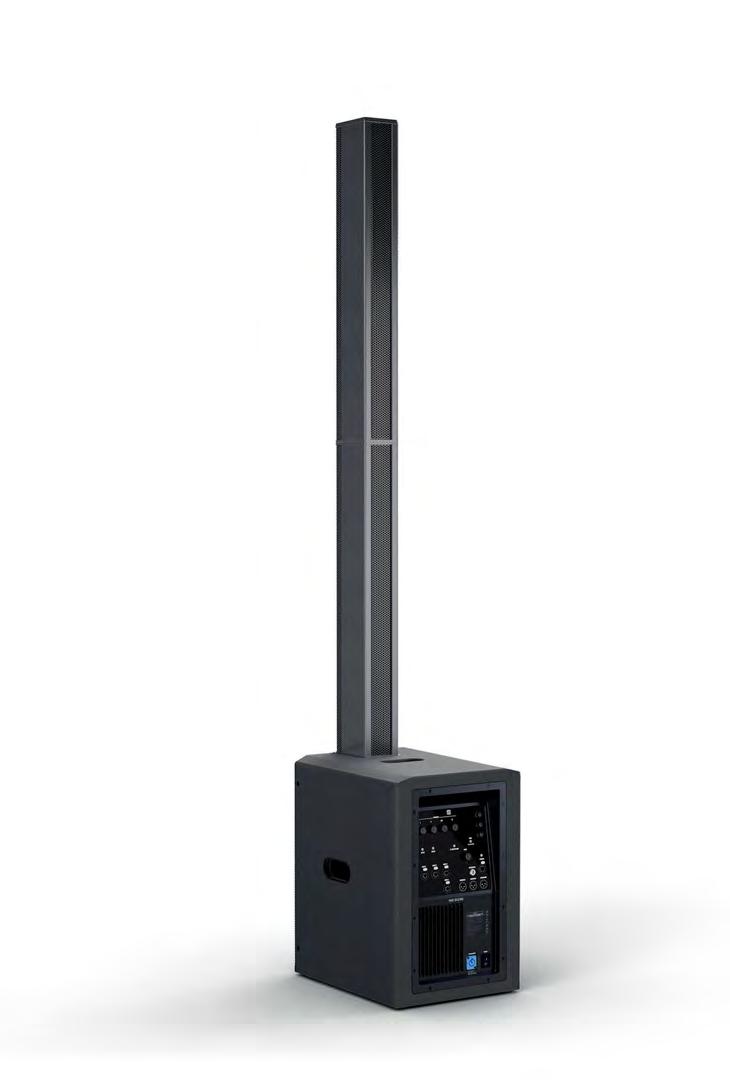
HH launches Tensor-MINI

The mixer settings can be adjusted manually via the control element on the rear of the subwoofer, as well as fully remote-controlled. For this purpose, the manufacturer offers a free iOS/Android app for smartphones and tablets, which provides full access to the mixer channels, monitor channels and the effects section with reverb, delay and dynamics tools. A parametric five-band EQ is available. Depending on requirements, the complete app control of the mixer can be operated
The MAUI 28 G3 MIX is based on a 12-inch subwoofer with 2,060W peak output and two aluminium column elements with 12 3.5-inch midrange drivers designed as cardioid loudspeakers to enable controlled sound dispersion. The MAUI 11 G3 MIX uses two 8-inch subwoofers with 1,460W peak power and six 3.5-inch midrange drivers. Both models feature phase plugs in front of the midrange drivers which, in combination with the two 1-inch tweeters, ensure even sound distribution with constant horizontal dispersion (120° x 30°). Equipped with DynX DSP generation, the subwoofers reportedly offer extended reproduction even at maximum volume down to 37Hz (MAUI 28 G3 MIX) or 39Hz (MAUI 11 G3 MIX). When using a second subwoofer, the bass range can be operated in cardioid configuration at the touch of a button. Thanks to Bluetooth 5.0, the solution becomes a versatile sound system for wireless playback of background music and other
UK-BASED HH Electronics has launched the Tensor-MINI, a portable, all-in-one, battery-powered PA. With an easy-to-carry design, the Tensor-MINI has a 6.5-inch coaxial full-range driver and can reportedly be set up in seconds, making it suitable for a wide range of applications. Its pre-amp includes a three-channel mixer (two universal inputs with tone presets and adjustable EQ, and an auxiliary input), DSP and reverb, along with a Bluetooth/USB media player which doubles as a charger for the input device. Bluetooth also supports stereo linking of two units.
Its multi-angle cabinet allows the unit to be used on the ground, as a monitor or on a pole stand, and audio protection
prevents overloading and damage. Fully chargeable in five hours, the unit delivers up to 12 hours continuous playback.
www.hhelectronics.com
Audio on the rails
DESIGNED FOR in a variety of environments, the Otarkio Series from French manufacturer Hortus Audio is a range of wireless audio products that are powered via light rails. Equipped with DECT technology and an FIR DSP programmed by Hortus Audio engineers, the company claims that the low-energy Otarkio Series offers rapid, scalable and cost-effective installations that are immune to disruptions from mobile phones, Wi-Fi or Bluetooth. By mounting speakers on existing power rails and wirelessly connecting to the player, installation is described as non-disruptive. Each player is capable of pairing with up to 100 speakers in a single zone, while zone extensions are flexible and can accommodate up to 10 players per installation. Audio sources can be fed into the player via input jacks or digitally via the network, and Hortus Audio says the

audio signal synchronises with all speakers with virtually no latency over a range of 50–120m. Any smartphone, tablet or computer is able to function as a dashboard for configuring, managing and operating the Otarkio system, and can be controlled and managed anywhere via the Otarkio web application. Speakers can also be adjusted directly via remote control.
www.hortusaudio.eu
46 WORSHIP AVL July–August 2024 PRODUCTS
MAUI 28 G3 MIX
Xi marks the spot
EXTENDING ITS X Series range of coaxial speakers, French speaker specialist L-Acoustics has launched the Xi Series, a range of installationfocused coaxial enclosures with distinct formats, bandwidth and SPL specifically tailored for short-throw applications. The X8i and X6i models utilise coaxial technology to provide constant tonal balance over distance in a compact package. L-Acoustics says its coaxial technology ensures smooth coverage for off-axis audiences, eliminates the need for a minimum listening distance and
provides high feedback rejection. The Xi Series features L-Vents to deliver clear low-frequency power and boasts an IP55 rating for indoor and outdoor installations.
The Xi Series’ slender, streamlined designs encourage integration into high-end architectural settings and both passive units feature a 1.5-inch neodymium compression driver coaxially loaded by a 6- or 8-inch low-frequency transducer in a bass-reflex cabinet. The 90° axisymmetric directivity imparts a smooth tonal response, free of
A new ARA for sound
SPEAKER SPECIALIST DAS Audio has boosted its ARA Series with a trio of products. The ARA-P12.74 is a selfpowered point source system featuring a 12-inch LF driver and a 3-inch VCD HF compression driver, 96kHz FIR filters and 1,200W of Class-D amplification. The ARA-P28.74 features dual 8-inch drivers, a 3-inch VCD compression driver, with 96kHz FIR processing and 1,200W of power. Both come with accessories to mount them in virtually any scenario and feature a rotatable horn for optimal coverage. In addition, the ARA-M210 is a dual 10-inch stage monitor which also boasts 1,200W and 96kHz FIR processing, has a 50° horizontal spread and an asymmetrical vertical dispersion of 40° downwards and 30° upwards. DAS Audio says
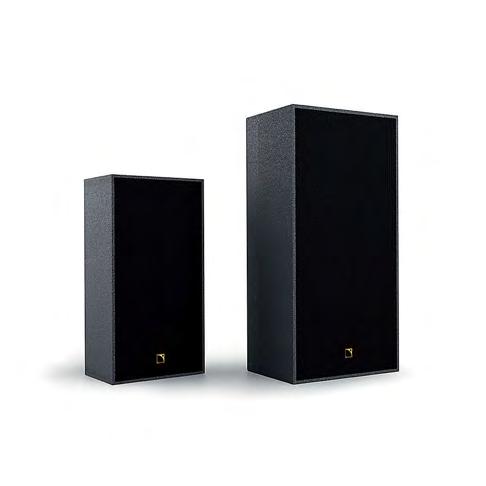
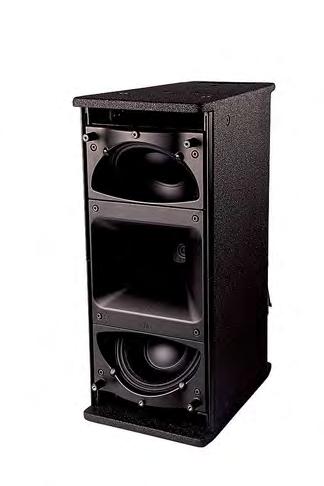
this optimises the monitor for a wide variety of stage setups. All three are compatible with ALMA, DAS Audio’s control and monitoring software. The company has also announced the next generation of its EVENT Series line arrays. The EVENT-28A is an ultra-compact line array sporting two 8-inch neodymium LF transducers and a single M-60 compression driver, powered by Class-D amplification with SMPS. The symmetric V-shaped configuration of the cone transducers delivers consistent 100° of horizontal coverage, while the M-60 driver remains coupled to an advanced waveguide design which controls the vertical dispersion and ensures precise coupling between units in vertical arrays. The EVENT-118A is a
Slimmed down sound
FOHHN HAS released its Focus Slim speakers, designed to bring the manufacturer’s beam-steering technology to smaller and more price-sensitive projects. The four slim enclosures blend in discreetly but are equipped with all the features they need for software-controlled sound dispersion in difficult acoustics. The beam can be easily adjusted via mouse wheel – the systems stay straight on the wall or screen without mechanical tilt. This allows users to achieve clear sound and speech intelligibility without disturbing reflections. Measuring 8.4cm wide, the speakers are equipped with Dante and analogue inputs and feature an integrated bass-reflex system. The range includes the FS-70 (700mm high/111dB maximum SPL), FS-110 (1.1m high/117dB maximum SPL), FS-150 (1.5m high/121dB maximum
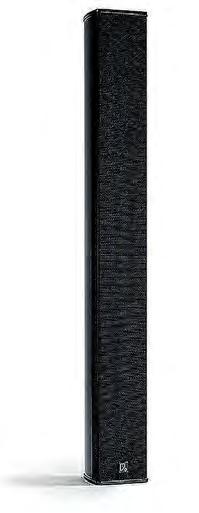
companion subwoofer with a single 18-inch front-loaded woofer and Class-D amplification.
www.dasaudio.com
SPL) and FS-200 (2m high/123dB maximum SPL).
Meanwhile, the manufacturer has also launched the Linea LXP passive line source speakers which can be installed straight thanks to a 5° dispersion tilt. The speakers have been acoustically redesigned with improved low-frequency reproduction and dynamics. The included T-slot reportedly allows for easy and flexible mounting. The length of the four speakers influences the behaviour of the system – the longer the line, the more the low frequencies are directed. The LXP-10 (100° x 100°), LXP-60 (120° x +15°/–25°), LXP-100 (120° x +10°/–20°) and LXP-150 (120° x +10°/–20°) have been designed for churches or other fixed or mobile applications.
www.fohhn.com
configurations. In their native presets, the X6i boasts a maximum SPL of 123dB and a frequency response down to 69Hz, while the X8i features a maximum SPL of 129dB and a frequency response down to 67Hz. For standalone applications and close proximity listening experiences, the X6i_50 preset delivers full-range sound reproduction down to 54Hz and produces a maximum SPL of 117dB. The X8i_40 preset reaches 43Hz, producing a maximum SPL of 123dB.
www.l-acoustics.com
THE EX28 is a two-way, full-range, active loudspeaker system from KV2 that extends the company’s EX Series range and builds on the success of the EX26. Adding further low-frequency extension, its compact profile is designed for a multitude of front of

house and in-fill applications such as houses of worship. Two individually designed 8-inch neodymium mid-bass woofers offer Transcoil for improved vocal performance and extended bass for the lowfrequency section, along with a neodymium compression driver mounted on a 100° x 80° horn.
www.kv2audio.com
July–August 2024 WORSHIP AVL 47 PRODUCTS
The EX files
FS-70
X6i and X8i ARA-P28.74
Electro-Voice launches next-gen ZLX speakers
ELECTRO-VOICE HAS announced the launch of the ZLX G2, the second generation of the ZLX portable loudspeaker series. The line-up offers a range of updated features and functionality and comes in 8-, 12- and 15-inch two-way models in both powered and passive versions.
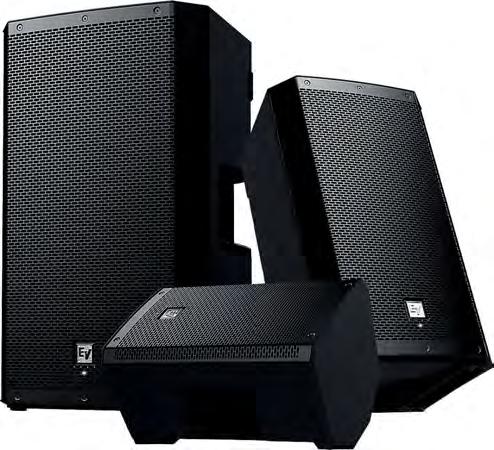
The woofer and compression driver in each model are coupled to a patented Signal Synchronised Transducers ported waveguide, enhancing low-frequency extension and delivering even vertical and horizontal coverage across all frequencies. The ZLX G2 also features a higher maximum SPL than the previous generation of models.
are “Powered by Dynacord”, while
1,000W Class-D power amplifier modules feature an integrated fourchannel, three-input digital mixer with effects. The mixer includes two XLR/TRS combo jacks and provides 24V phantom power and Hi-Z compatibility. The mixer also includes features such as automatic feedback suppression, ducking, compression and loudspeaker delay settings. Five system mode settings are available: music, live, speech, club and FRFR (full range, flat response). New for the ZLX G2, the FRFR setting offers a flat/neutral frequency response to produce accurate results when used with modelling processors and guitar cab simulators. Powered ZLX G2 loudspeakers also contain Electro-Voice-specific subwoofer presets that adjust for both gain and time alignment, for full acoustic optimisation. Additional high-pass filters are available in the DSP for increased compatibility.
All the loudspeaker and mixer functions can be remote-controlled and monitored using the Electro-Voice QuickSmart Mobile app. The app
allows pairing and grouping of up to six Bluetooth-equipped Electro-Voice portable loudspeakers. Users can wirelessly pair and link to two ZLX G2 loudspeakers in a stereo setup using Bluetooth true wireless stereo streaming. Local configuration can be completed using the single-knob encoder with the updated full-colour LCD.
In terms of design, all models are available in black and the symmetrical sides allow for a steeper projection angle when the loudspeaker is placed in monitor position. A built-in “kick-back” angle allows the 12- and 15-inch versions to project upwards at a 23° angle in a vertical orientation. Mounting accessories are available to install permanently on the ZLX G2 models including a “U”-style wall bracket and long arm pole mount-style wall bracket for the 12- and 15-inch versions for vertical mounting with tilt adjustment, as well as a short arm pole mount-style wall bracket for the 8-inch version.
www.electrovoice.com
Making the Link
ESW-R4180LK
VIDEO SWITCHING and control device specialist AMX has added two products to its growing catalogue. Its SVSI N3300 Series of encoders and decoders are designed to extend the reach of its SVSI 4K60 networked AV solutions to a wide area network (WAN).
Delivering 4K60 H.26x and Dante AV-H video, the N3300 Series
for high-security networks. With Dante AV-H, N3300 products are compatible with Dante Studio to allow monitoring or bringing video directly into UC, recording, production or streaming applications without the need for additional hardware. H.264/ AVC and H.265/HEVC video compression standards are both

aims to provide greater streaming flexibility and interoperability for streaming or mobile device applications.
The N3300 Series also features recording of video to a USB 3.0 external drive on encoders, video preview images viewable from the built-in web interface or from a touchpanel, and enhanced support
supported, and its open API makes it possible for any control system or application to control the device. Available in standalone box and card form factors, N3300 encoders simultaneously output both 4K60 H.26x and 1080p H.26x video streams.
www.amx.com

AUDIO-TECHNICA HAS unveiled its ESW-R4180LK eightchannel receiver for use within the brand’s DECT-based Engineered Sound Wireless ecosystem. Using a single standard Cat5e cable for both power delivery and audio, the ESW-R4180LK handles up to eight channels of audio. AT-Link also provides the ability to power AT-Link endpoint devices, eliminating the need for a power cable or standard PoE switch. The receiver can be daisy-chained to simplify installation and, for added flexibility, mix-out channels can be used when there are not enough input channels for the audio destination. Audio-Technica’s Wireless Manager software allows users to check reception status, audio level, battery level and other
been integrated into the Q-SYS ecosystem with the development of a certified plugin with US enterprise AV infrastructure specialist The Farm. Delivering scalable wireless mic functionality to the Q-SYS ecosystem, the integration of the Q-SYS control plugin enables users to connect to and manage the DECT-based system, including individual and group channel muting, preset loading, real-time monitoring of RF and charging parameters, all via a Q-SYS network touchscreen controller.
www.audio-technica.com
48 WORSHIP AVL July–August 2024 PRODUCTS
AMX
doubles up
N3300 Series
Neumann is on a mission
NEUMANN.BERLIN HAS released a feature upgrade for the MT 48 audio interface. The Monitor Mission transforms the MT 48 into a freely configurable monitoring controller. In addition to mono and stereo, the Monitor Mission can also handle surround formats such as 5.1 as well as immersive audio formats such as Dolby Atmos 7.1.4. This is said to open up a whole new field of applications, particularly in the mixing and mastering sector.
The Monitor Mission includes flexible bass management and complex alignment functions to adjust the frequency and time domain characteristics of loudspeakers to the listening position. The downmix feature
allows multichannel audio to be monitored in either mono or stereo. The extensive range of connectivity options makes it possible to connect studio monitors in a variety of ways, whether analogue or digital via S/PDIF or ADAT. It is even possible to combine several connection types for one speaker group. Using the four analogue monitor outs and an external ADAT converter, systems of up to 7.1.4 can be realised. In addition, the built-in AES67 interface allows the connection of highly professional multichannel converters such as the Merging Hapi MKII and/ or Neumann studio monitors in the AES67 version.
www.neumann.com

Ampetronic debut AURI
LISTEN
TECHNOLOGIES
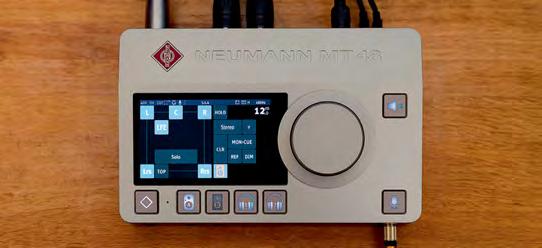
and Ampetronic have unveiled AURI, the first installed assistive listening system using Auracast broadcast audio technology. Auracast is a new standard for Bluetooth Low Energy audio. This is the first time Bluetooth has supported broadcast audio, which unlocks a variety of new use cases, including wide area assistive listening. Auracast can broadcast audio simultaneously to an unlimited number of Auracast-compatible devices, including receivers, hearing aids, earbuds and smartphones. Listen Technologies and Ampetronic are active members of the Bluetooth Special Interest Group (SIG) working to make Auracast broadcast
audio technology as reliable and widespread as possible.
AURI is the first product Listen Technologies and Ampetronic have developed together since the companies announced their partnership and creation of a single source for assistive listening solutions. AURI will include networked installed transmitters for large and small spaces, dedicated receivers and charging bases, and a complete line of accessories, including headphones, neck loops and network management and configuration software.
www.ampetronic.com www.listentech.com
29 - 31 MAY, 2025 BEC, MUMBAI, INDIA www.palmexpo.in www.av-icn.in By BOOTH BOOKINGS OPEN FOR 2025 INDIA’S GREATEST SHOW ON PRO AUDIO, PRO AV & LIGHTING SOLUTIONS AV soundlightaudiovisual #PROAUDIOSUPERHIGHWAY #INTEGRATING AV INNOVATION
Flexibility with V600:2
DYNACORD HAS announced the introduction of the V600:2, the latest member of its V Series family of commercial amplifiers. With a total output capacity of 600W, this two-channel amplifier is intended for background music and announcements but also for whenever higher SPL levels in small or midsized fixed installations are required. Integrators can now mix and match different V Series models to meet their specific project requirements. With the same features and Dynacord technologies on board as the four-channel V600:4, the V600:2 is said to offer optimal installation flexibility, superior power efficiency and advanced reliability.
powerTANK technology adds flexible power allocation, acting as a power reservoir. With direct access to 600W, the V600:2 can deliver asymmetric
Dynacord’s Variable Load Drive (VLD) technology allows the amplifier channels to be driven at 4Ω, 8Ω, 70V or 100V.
Overall power consumption is significantly reduced with ecoRAIL, conserving energy and lowering ownership costs. Auto Power Down (APD) aims to improve energy consumption by automatically powering down the amplifier when no audio signal is present. dualCOOL provides silent operation for applications in quiet environments, while a built-in multi-stage fan is activated under extreme thermal conditions.
At just a single rack unit high and half a rack wide, the V600:2 offers a multitude of installation options wherever space is limited. The included brackets facilitate single or dual rackmount options.

CODA AUDIO has released its LINUS6.4-iD installation amplifier.
The unit, the first produced by CODA’s recently created amplifier engineering R&D team, is part of the company’s roadmap towards an entirely new LINUS DSP amplifier platform.

NEXO goes nano
AVAILABLE IN standard and Danteequipped versions, the four-channel nanoNXAMP4 and nanoNXAMP4-D from NEXO deliver 4x 250W using ultra-low distortion Class-D amplifiers and SMPS with PFC, providing the same sound quality as NEXO’s larger NXAMPMK2 TD Controllers. Processing uses FIR filtering for system EQ and linear phase compatibility, with presets available for an edited range of speakers drawn from NEXO’s ID and ePS Series. With a universal mains voltage range of 100–240V, the nanoNXAMP4 occupies half a rack width, increasing channel density. The integrated DSP offers a four-in/four-out architecture with optional Dante connectivity.
The LINUS6.4-iD drives the vast majority of CODA’s family of loudspeakers with the exception of line arrays and sensor-controlled subwoofers, and can be controlled by LINUS Control which offers full network control and monitoring over Ethernet. Additionally, the LINUS6.4-iD can be controlled via LINUS App which allows full control from a mobile device using its built-in Wi-Fi hotspot.
The LINUS6.4-iD is a four-channel DSP networkable installation amplifier delivering 4x 1,500W of clean power
in a lightweight, 19-inch package. Advanced Class-D discrete power stages with DC-coupled DACs provide minimal thermal dissipation. The PCB layout design integrates DSP, four amplifiers and SMPS on a single PCB for enhanced sound quality, pinpoint control and rugged protection.
The LINUS6.4-iD’s inputs are selectable, enabling users to choose between analogue, LiNET or Dante digital audio network, and route to any of the four outputs via the input matrix. The DSP processor enables the integration of audio algorithms, including phase linear DS-FIR filters. The end result is said to be increased system headroom and sonic fidelity, even under heavy use conditions.
www.codaaudio.com
Onboard mixer and matrix functions reduce the overall cost of smaller inputs provide “double connectivity”.
Balanced inputs can accommodate a dynamic microphone or professional
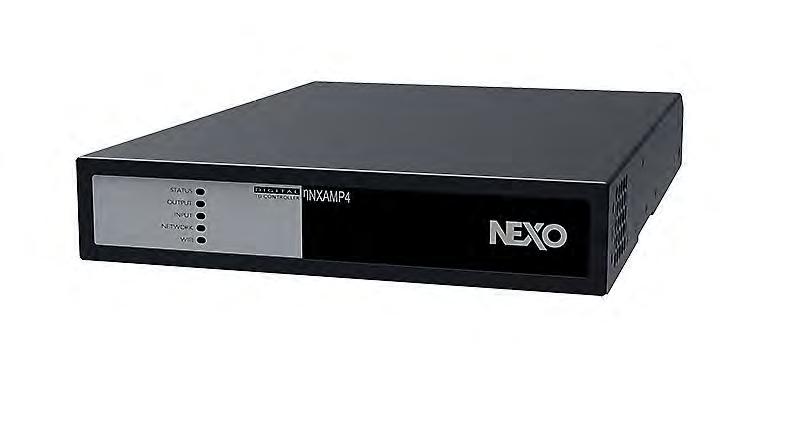
lower background music while the
Headline act
SENNHEISER HAS introduced the Headmic 4, an ultra-lightweight (7g) condenser cardioid neckband microphone for vocal and speech applications. Featuring a KE 4 cardioid mic capsule and a range of accessories, it comes with 3.5mm jack and three-pin connector options and is compatible with all Sennheiser bodypack transmitters.
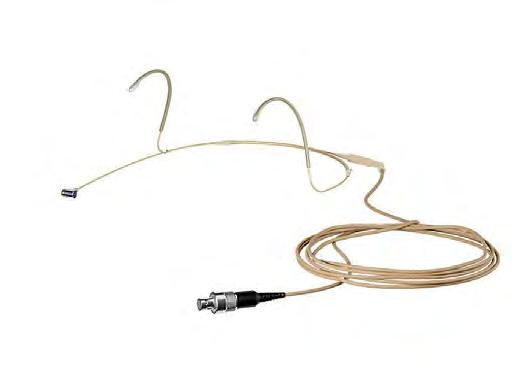
microphone is in use. An SPDIF In/ Out can be used either as a digital input or to distribute a stereo signal across multiple nanoNXAMP4 units. A GPIO port facilities analogue volume control and a 12V trigger
Wall remote controls are available and can be configured to allow users to select sources and control volume, and the nanoNXAMP4 is compatible with remote control protocols including Q-SYS, Symetrix, Crestron, ELAN, AMX, RTI and Control 4. The nanoNXAMP4 is also compatible with NEXO’s NeMo remote control and monitoring software.
www.nexo-sa.com
The adjustable neckband has been designed to be visually unobtrusive and comfortable to wear. The unit comes with a twist-proof microphone boom (Ø 1.1mm) that can be attached to the left or right side and it is available in three colour variants: black, beige and silver.
www.sennheiser.com
50 WORSHIP AVL July–August 2024
PRODUCTS
CODA connects four
Caught in a Soundweb
CATERING TO a diverse range of environments, the Soundweb OMNI family from BSS is an open architecture DSP platform that combines enterprise-grade processors, flexible I/O expanders, Dante/AES67 networked audio, an onboard scripting engine developed by AMX and a vast library of processing objects, including media playback, AEC and VoIP. The manufacturer describes it as the next generation in open architecture digital signal processing, combining purpose-built hardware with software to provide the flexibility of centralised or distributed DSP to allow systems designers to choose the appropriate topology for any installation. BSS’s commitment to supporting control system programmers is reinforced through the introduction of HControl, a

human-readable, standards-based and developer-friendly API.
Featuring BSS’s 512p and 256p flagship processing devices, the Soundweb OMNI family provides up to 512x512 Dante/AES67 channel counts at 96kHz. It also offers two I/O expansion devices, the 32e and
16e. Each audio I/O port is “format configurable” as either analogue or stereo AES3, and certain audio I/O ports (and all GPIO ports) are configurable as either inputs or outputs. The platform is managed through AVX Architect and AVX Control, a software suite designed
DiGiCo introduces Fourier Interface Card
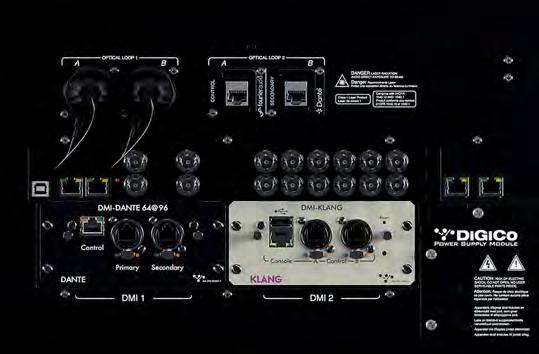
FOLLOWING DIGICO’S acquisition of Fourier Audio and the launch of its inaugural product, the transform.engine, DiGiCo has unveiled the Fourier Interface Card that will be retrofittable on all Quantum consoles as well as on the majority of the manufacturer’s
SD-Range desks. The module delivers 64 channels of bidirectional audio at both 48k and 96k connections to the Fourier Audio transform.engine, which is a 2U outboard Dante-connected server designed to run VST3 software plugins in the live environment. The
card is based on Dante, allowing most of DiGiCo’s consoles – even those without DMI card slots – to join the Dante ecosystem, without requiring MADI on the transform.engine. Meanwhile, the console manufacturer has also announced it is offering second-generation software updates for its Quantum338, Quantum338T and Quantum225 mixing consoles. Available for a nominal fee, the Mk 2 software packages, known as Pulse, will increase the input channel and bus counts of each desk model, plus add other notable features. On the Quantum338 and Quantum338T, the upgrade will increase the number of input channels to 156 (from 128), busses to 72 (from 64), Mustard Processors to 48 (from 36) and Nodal Processors to 72 (from 64). Other perks include the addition of Mix Minus functionality, plus a larger 36x36
to support the latest installed products from HARMAN Professional starting with BSS Soundweb OMNI. The AVX software suite delivers configuration, control and monitoring via two applications – AVX Architect is a desktop software app for system diagramming, device configuration, network management and custom UI design. It allows users to add an unlimited number of processors and expanders to a single project file, while still using a single canvas for device configuration. Alternatively, AVX Control is a lightweight software app providing easy access to custom UIs for controlling and monitoring devices across Windows, iOS, Android and AMX Varia touchpanels.
www.bssaudio.com
INTRODUCING A wireless monitor system with Dante and encryption in the 537–691MHz range, Lectrosonics has launched its Duet digital wireless monitor system in the B1C1 frequency band for markets including Europe, Asia Pacific and South America. Supporting both analogue and Dante signal sources, the all-metal Duet IEM system boasts a signal latency of 1.8ms and includes a M2Ra bodypack receiver, M2T/E01
dual-stereo half-rack transmitter and M2C-L wideband power combiner. Other features include phantom power protection on the M2Ra headphone jack so that the receiver can be safely used as a camera hop receiver and an IFB analogue compatibility mode. High receiver IP3 and 1dB RF compression points reportedly provide robust handling of high signal levels, while D2 and HDM mono digital compatibility modes in the M2Ra mean it can
matrix on the “T” theatre-software model of the console (up from 24x24). Similarly, Pulse will bump up the Quantum225’s power and versatility, raising its input channel count to 96 (from 72), bus count to 48 (from 36), and Mustard and Nodal Processor tallies to 36 and 48, respectively (from 24 and 32). Mix Minus is also included in the new feature set. To qualify for the discount, the Pulse software upgrade must be purchased before the end of 2024. The company will simultaneously offer Mk 2 software updates for its Quantum7 and Quantum5 consoles free of charge, adding Mix Minus to the desks and increasing the number of Mustard Processors on the Quantum7 to 80 (from 64) and to 64 (from 48) on the Quantum5.
www.digico.biz

also be used as a portable receiver or portable monitor device, with mono digital transmitters from the DSquared product line. Both the M2Ra receiver and M2T/E01
transmitter also include a USB jack so users can update the firmware in their units in the field.
www.lectrosonics.com
July–August 2024 WORSHIP AVL 51 PRODUCTS
New home on the range
Fourier Interface Card
PRODUCTS
Ready to receive (and transmit)
SHURE HAS expended two of its product lines with the launch of the Axient Digital ADX3 plugon transmitter and the SLX-D portable systems. Designed for broadcast and location sound, the ADX3 extends the company’s Axient Digital Wireless System and transforms any XLR microphone into a portable ADX Series wireless microphone. Delivering the same performance of the AD3, the addition of Shure’s proprietary ShowLink technology allows comprehensive, real-time control of all transmitter parameters over a 2.4GHz diversity wireless connection directly from the receiver. Meanwhile, the company has expanded its SLX-D Digital Wireless family with the introduction of SLX-D Portables, including the SLXD5 Portable Digital Wireless Receiver and SLXD3 Plug-On Digital Wireless Transmitter. The SLXD5 is an SLX-D receiver that can be installed on-camera through a cold shoe mount as well as in an audio bag. Enabling users to start recording immediately, the SLXD5 automatically scans

for the best frequency and pairs it to the transmitter with IR Sync in seconds, while Multi-Mic Mode facilitates the management and monitoring of multiple sound sources from a single receiver. Shure has also introduced its latest line of wireless clip-on microphones, the MoveMic Microphone System. The lightweight, dual-channel, direct-to-phone wireless lavalier solution delivers broadcast-quality audio and features a custom acoustic design as well as Shure’s proprietary wireless software. The MoveMic series connects directly to phones in both single and dual configurations for use with Shure’s MOTIV audio and MOTIV video apps on iOS and Android, allowing users to configure audio settings such as gain, limiter, compression, noise reduction and EQ. For those seeking universal compatibility, the standalone MoveMic Receiver and bundled MoveMic Two Receiver Kit integrate with devices such as cameras, computers and third-party smartphone apps.
www.shure.com
Routing for you
WITH THE V2.0 firmware update of Stagetec’s NEXUS audio router, the German audio specialist is giving existing NEXUS units a significant boost, including updated audio processing and a redesigned web UI. The release provides a 120x16 mix matrix, 16-input processing (Delay, Exp, EQ, Comp), 16-output processing (Delay, EQ, Comp, Lim) and Avatus EQs and Avatus compressors, including the addition of wet/dry, knee and soft clip parameters. Its browser-based UI provides controls for this functionality, and with the same look-and-feel of the Avatus GUI. The updated UI includes snapshot automation, copy/paste for processing blocks and an XY routing matrix for more intuitive signal routing. In addition to signal
Free D sound design
ENABLING SYSTEMS engineers to create 3D venue models for any environment, JBL’s Venue Synthesis acoustic simulation software is a free acoustic simulation application for desktop. Replacing JBL’s Line Array Calculator, the application enables users to design and simulate acoustic coverage for any environment and prepare complete sound reinforcement systems for rigging or installation in both 2D and 3D. Designed for rental companies, acoustic consultants and live sound system engineers, it enables users to create or import 3D venue models, interact with 3D models of JBL Professional equipment and predict coverage for a full system of JBL products. The company says it has modelled every component of the signal chain, from the input signal to the amplifier output voltage, in order to model accurate sound pressure levels that relate to reality. Venue Synthesis features three modes of operation. Venue Mode can generate venue models in 2D or 3D using industry-standard geometry formats, or build venues from scratch. Users can import and trace 2D schematics using common file formats to model venues and create common architectural and audience areas such as balconies using its Special Object Creator. Acoustics Mode builds and refines JBL loudspeaker systems, including suspended and ground-stacked

line arrays, distributed subwoofers and point source systems, and can configure equipment quantities and parameters including system size, position, angles, DSP and amplifier settings. A System Groups feature organises and links loudspeakers and arrays according to acoustic properties, while 2D System View visualises coverage, impact points and loudspeaker angles. Meanwhile, Delay Optimiser optimises loudspeaker delays for the entire venue. Finally, Mechanics Mode validates and refines mechanical settings to confirm system feasibility, safety and reliability. Its Array Statistics tool confirms adherence to regulatory requirements, and a real-time warning notification system alerts users to safety and reliability issues across the system.
www.jblpro.com

routing, mic parameter control can now be carried out directly from the Stagenet UI, and the Dante version of NEXUS compact can now be controlled from a Yamaha CL/QL console; the same licensing system applies as with Yamaha mic control for NEXUS.
Meanwhile, Stagetec’s NEXUS 4split is a standalone unit that comes in a variety of sizes and configurations. TrueMatch mic inputs are duplicated using four splits that the XMIC cards provide on each input, while each of the four split outputs has its own set of parameters for use onstage or in a
recording context. These signals are controlled by a web browser interface, enabling operation from an iPad or a service computer running standard web browser software. The split signals appear on all output formats (Dante, AES67, analogue and MADI) simultaneously.
The manufacturer has also released its Stagenet V1.0 control system for IP signal management, as well as the latest 1.20 release for its Avatus software. The company says the underlying OS has been rebuilt to improve fluidity and add features including CUE-Preview/ edit, Remote Desktop Connections controlling external PCs, Web-Viewer for browsing and AES67-Stream configuration and DAW-control.
www.stagetec.com
52 WORSHIP AVL July–August 2024
NEXUS compact
ADX3
Blackmagic adds to Videohub platform
SERVING AS a central hub for SDI equipment, the Blackmagic Videohub 120x120 12G router can connect any video input to any video output, including multiple outputs. In addition to adding extra inputs to an ATEM switcher, the 120x120 12G also users to view any source in a studio, routes video signals to multiple streaming processors for broadcast platforms and promotes redundant mastering when used with multiple HyperDeck recorders.
Like the Videohub Master Control Pro in appearance, the integrated front control panel includes a spin knob for browsing, direct entry buttons for speed and an LCD for displaying labels. With the panel built into the router, live video of all router inputs can be previewed on the LCD and router settings can be changed. Regardless of varying video standards, labels displayed below the live video can be identified by scrolling the router sources in alphabetical order without the requirement for an external SDI monitor.
All Videohub 12G models feature 12G-SDI connections which are multi-rate and support any SD,
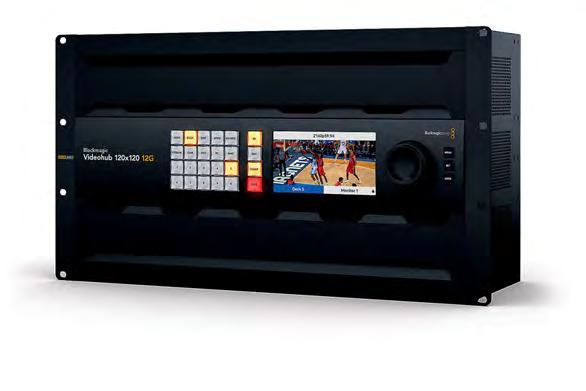
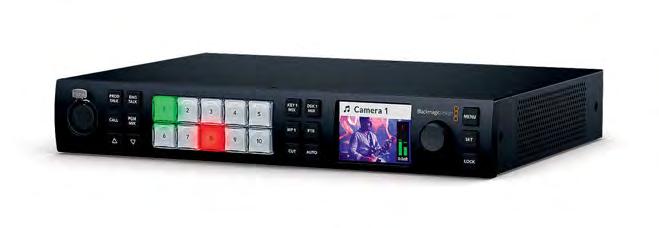
SD, HD-SDI, 3G-SDI, 6G-SDI and 12G-SDI equipment. By supporting the routing of any video standard on the same router at the same time, the 120x120 model can route up to 120 different video signals to 120 outputs simultaneously. Designed to regenerate video signals and improve jitter performance, SDI re-clocking is built into every 12G-SDI input.
adopting Videohub Software Control. Incorporating dual power connections for redundancy, two versions exist with the Videohub Master Control Pro with a front panel, spin knob, LCD and shortcut buttons. The Videohub Smart Control Pro model features programmable buttons for the panel to control single router outputs to router inputs.
Meanwhile, the manufacturer has also released ATEM 1 M/E Constellation 4K and ATEM 2 M/E Constellation 4K switchers. With up to 20 12G-SDI standards converted inputs, the two 4K models have the same features as the ATEM 1 M/E and 2 M/E Constellation HD models, including aux outputs, DVEs, ATEM advanced chroma keyers, Multiview and SuperSource. The ATEM 1 M/E Constellation 4K includes 10 standards converted 12G-SDI inputs, six 12G-SDI outputs, a DVE, four ATEM Advanced chroma keyers, a 16-way multiview, media players, talkback and USB webcam output. The larger ATEM 2 M/E Constellation 4K has 20 standards converted 12G-SDI inputs, 12 12G-SDI aux outputs, two DVEs, eight ATEM Advanced chroma keyers, two multiviews and a SuperSource for a total of six DVEs.
www.blackmagicdesign

July–August 2024 WORSHIP AVL 53 PRODUCTS
DON’T JUST READ THE NEWS, EXPERIENCE IT. Our digital subscription offers exclusive video content that decodes industry news, reveals hidden trends and offers vital insights into our industry. Don’t miss outSUBSCRIBE TODAY.
Videohub 120x120 12G
ATEM 1 M/E Constellation 4K

one preview and intuitive user interface software that offers highquality monitoring of the Program and Preview channels. Focusing exclusively on playback of full-screen video files, it has native support of various codecs, including H.264, H.265/HEVC, AWX and nonstandard resolutions. Tailored for live-operated scenarios in both rental and staging and live-like systems
Awash with colour
integration, Analog Way says Solo is perfectly complementary to its presentation switchers.
The company has also added three products to its LivePremier series with the Aquilon RS5, Aquilon RS6 and Aquilon Cmax. Expanding the range with Aquilon multi-screen and multi-layer live presentation systems supporting pixel canvases up to 16K, these 6U units offer up to 32 4K60p inputs (or 64 2K/dual 60Hz inputs with eight-plug input cards) and up to 24 4K60p outputs (where 16 outputs
can be used to drive programs and the remaining outputs can be used to drive auxiliaries). All three systems feature up to 64 layers and up to 48 still images and can be linked to up to four additional LivePremier chassis for even larger I/O needs: up to 256 inputs and 80 outputs in total, and up to 320 outputs with the DPH104s. They feature two dedicated multiviewer outputs and a Dante audio interface.
www.analogway.com
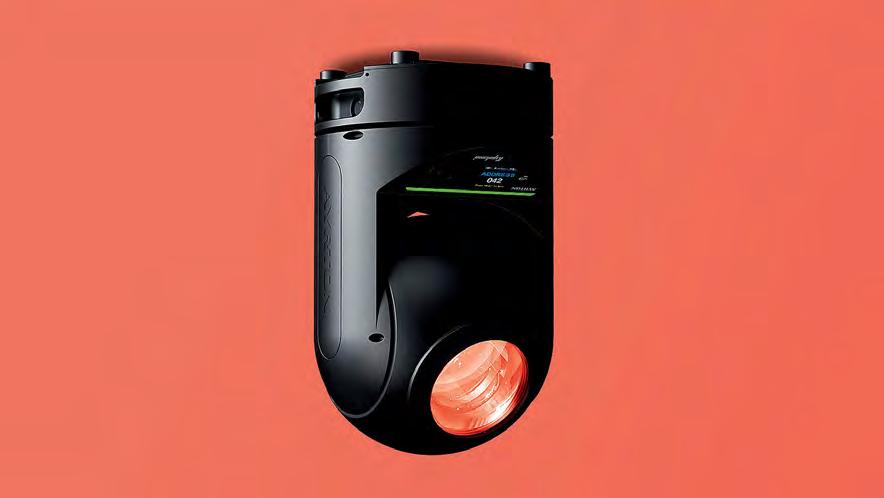
Its proprietary three-lens optical system produces an intensive 1° beam and a range of focus that permits the beam shape to be adjusted according to operating distance. It delivers a record luminous flux of 400,000 lux at 10m from its speckle-free laser source, which is designed for
rendering a D65 white point. Meanwhile, its colour section includes a high-definition progressive CMY colour mixing system and a multi-position instant access colour wheel equipped with five corrective filters and 17 complementary colour filters.
grandMA works harder
THE V2.0.0.4 grandMA3 software update introduces a raft of functionality and workflow improvements to MA Lighting’s lighting console, including a customisable encoder bar, bitmaps, soundfiles in timecode, selection grid improvements, fixture sheet modes and what MA Lighting refers to as “special dialogues”. In addition, the update delivers improvements to data handling and organisation. Sheets can now be filtered and reorganised to create
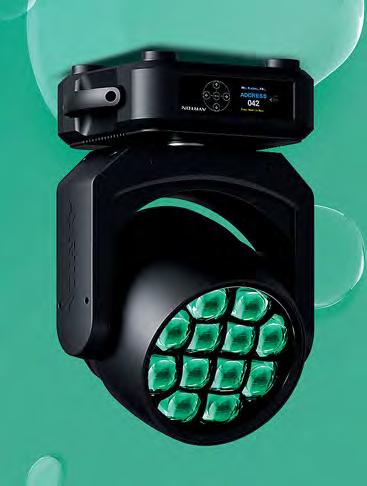
Suitable for use both indoors and outdoors, it can even be used in salty environments. It

can switch from beam to wash with a zoom ratio of 15:1 and a zoom range of 3.5–53°, and is fitted with 12 high-performance 40W LED sources with RGB-L additive colour synthesis and a proprietary optical system made up of a 210mm cluster in PMMA. This works in combination with 12 glass light-guides with an output surface made of an optical micro-structure. Its lightweight and minimalist design reportedly allows perfect colour reproduction with a colour rendering index greater than 86. It can achieve a luminous flux of 10,000 lumens and offers a mix of pastel or saturated colours. In addition, a library of pre-programmed colours allows subtle, dense and contrasted swaths of colour, and Ayrton has also installed separate LED source control channels on all Wash versions and what it claims is a virtually infinite library of effects.
www.ayrton.eu
a personal workspace, and the transfer of fixture data is said to be easier with the introduction of a clone window. Tracking functionalities reportedly simplify working with big sequences, while fixture type presets allow users to easily transfer predefined content from show to show. MA Lighting’s free online MA University provides detailed training on the updated feature set.
www.malighting.com
54 WORSHIP AVL July–August 2024 PRODUCTS
Kyalami
Solo
Nando 502 Wash
Colouring outside the box
THE COLORSOURCE PAR jr is a compact version of ETC’s ColorSource PAR. At nearly half the weight of its full-sized sibling, the PAR jr provides almost 2,300 lumens of brightness and includes a four-colour red, green, blue and lime array. The wash light
interface that features a variety of controls for mixing colour across all fixture types. Additionally, a “Colour Mix” preview column has been added to the output window and editor windows, indicating the colour being output by colour mixing fixtures.
Elation adds to SIXPAR series
OFFERING A blend of enhanced output, expanded colour spectrum and “superior quality of light”, updated versions of Elation’s SIX+ PAR series have been launched in the form of the SIX+ PAR S and SIX+ PAR L. Available with either seven or 14 20W RGBLA+UV LEDs, the SIX+ PAR series reportedly offers the ultra-wide colour spectrum, colour rendering and high CRI (93) that the most exacting designers demand. The optical system is said to guarantee that beautifully homogenised colour distributes evenly and without fringing, from high-fidelity whites to intense primaries and virtually every shade in-between. Furthermore,

technologies to ensure colours are consistent, including thermal droop compensation and comprehensive factory colour calibration, while ETC says the fan-free, convection cooled design makes the luminaire ultra-quiet.
The Hog 4 version 4.0 software update from lighting and rigging specialist ETC provides “significant improvements” to colour handling and Hog 4’s Colour Picker, the introduction of a “Record Defaults” function and Fixture Builder upgrades. Aiming to relieve programmers and designers from the challenges of controlling rigs with multiple colour engines, the update provides multiple colour input languages through the colour pickers, virtual colour functions and gels library. Substantial changes have also been made to the fixture library, colour picker, gels, palettes, effects, plots, pixel mapping and the playback of colour. All colour mixing systems – including native HS, xyY, CMY as well as all additive colour engines – are fully integrated. Hog 4 OS v4.0 also now features a Colour Picker window with a tabbed
intensity to fixtures with colour mixing systems and the inclusion of more user-editable fields such as mode and product. Version 4.0 is compatible with all generations of Hog 4 hardware.
Finally, the manufacturer has introduced a range of capabilities to its Mosaic Designer Software with the launch of Mosaic software v2.12. Headlining the feature set is Mosaic Record, which enables users to capture up to 16 universes of sACN or Art-Net output from a console and save recordings directly to a Windows or Mac environment. Record captures can be applied onto Mosaic timelines just like any other effects or presets. ETC says Mosaic Record not only makes programming any show simpler but means that moving lights effects programmed on a console can be ported into Mosaic. The Mosaic Record app records from a computer and imports directly to the Mosaic Designer software rather than being triggered from a Mosaic touchscreen.
www.etcconnect.com
The SIX+ PAR’s housing includes a dedicated diffusion lens holder with an optional gel frame holder that can accommodate industry-standard 7.5- or 10-inch accessories. Beam angle is 12° with a 22° lens included that allows them to match seamlessly with existing SIXPAR fixtures.
SIX+ PAR luminaires house an electronic dimmer and strobe and are capable of smooth dimming from 0–100%. A selection of 16-bit dimming modes and curves are also included.
To ensure the SIX+ PAR can be integrated seamlessly alongside original SIXPAR fixtures, care has reportedly been taken to ensure that the new LED array colours match the original. A unique
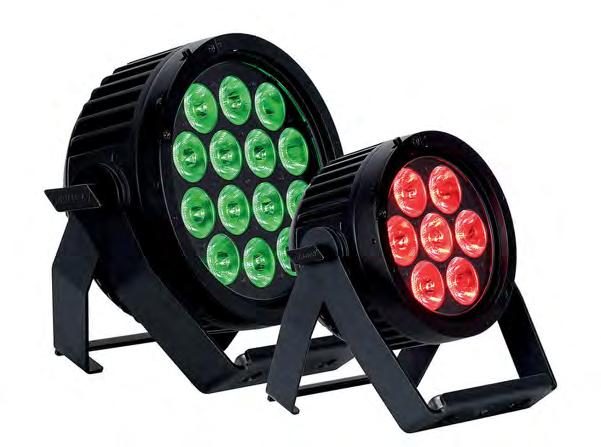
it houses the same LED engine as the manufacturer’s new SIX+ BAR series for a perfect colour match and is IP65 protected to handle any environment. Output is rated at 3,200 lumens for the SIX+ PAR S and over 7,000 lumens for the SIX+ PAR L. To expand the colour capabilities of the SIX+ PAR further, colour temperature control via a dedicated variable CCT control channel has been integrated with adjustments capable from 2,400K–8,500K. A CMY emulation mode plus an integrated library of calibrated colour presets that match the most popular gel filters have also been included.
the identical DMX mapping as the original. The colour mixing has also been calibrated to virtually emulate the white LED included in the original SIXPAR array, and an output limit master setting has been added so the new lights don’t overpower any older fixtures in the rig.
With a dual yoke design, the fixtures can be mounted on the floor or rigged to hang using a c-clamp or the included omega bracket receiver. The fixtures also feature proprietary Aria x2 wireless device management for simplified system setup and maintenance.
www.elationlighting.com
July–August 2024 WORSHIP AVL 55 PRODUCTS
ColorSource PAR jr
SIX+ PAR
Spotlight on Robe
CELEBRATING ITS 30th birthday this year, Robe has added to its lighting inventory with the iBOLT, T15 Fresnel and PC, iT12 Fresnel, iESPRITE Fresnel, and Footsie1 and Footsie2 Slim.
Mirroring the MegaPointe, the iBOLT can be used as a beam, spot, wash and effects luminaire for stage and outdoor applications. It has an LSW-5 white laser phosphor light source and a 300mm front lens with a 0.4–8.5° zoom. Additional features include the SpektraBeam effects engine, ScanGuard safety monitoring and Robe’s POLAR+, EMS and RAINS IP protection technologies.
The T15 is available as a Fresnel or PC version, both with identical
features. The T15 utilises the ZoomStat system which produces a beam angle exceeding 70° with a motorised zoom range of 10–72°. It offers a CRI of 95 and CMY or RGB colour control virtual CCT range from 2,700–8,000K, while the MSL-TE 350W LED engine offers a 11,960-lumen output.
The iT12 Fresnel has been specifically designed for outdoor IP65/IP66 requirements. The fixture features a 10:1 zoom ratio from a 6° beam to a 60° wash. The iSE-MSL-TE 500W LED source offers selectable CMY, RGB or individual colour emitter control, factory-calibrated whites and variable CCT from 2,700–
Leading with LED

8.000K, a CRI of 95 plus and an 11,000-lumen output.
The iESPRITE is powered by Robe’s Transferable Engine technology including the white iSE-TE 650W HP and HCF LED engines. Designed for external use, the fixture is equipped with a F2L Fresnel lens for outdoor
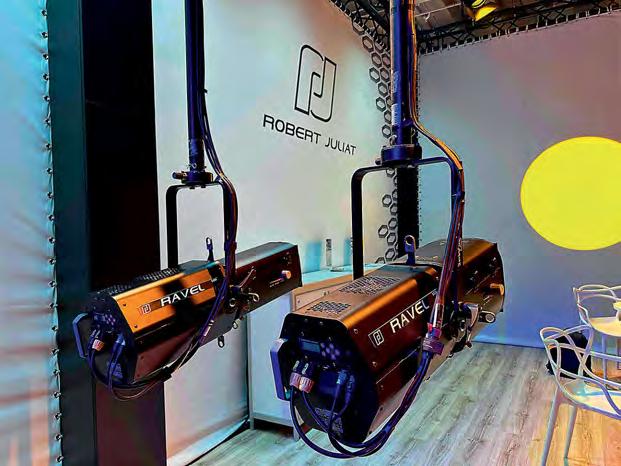
Fangs for the lumens
CLAIMING TO have the most robust feature set it has ever developed, Martin Professional’s MAC Viper XIP is an outdoor moving head fixture that utilises Martin’s patent-pending XIP weatherproofing technology. Integrating powerful lumen output, XIP water and dust ingress protection, and whispersilent noise levels, the MAC Viper XIP is designed not only for temporary, year-round outdoor needs, but also for broadcast and other noise-sensitive applications. Martin’s tailor-made light engine and XIP weatherproofing allow the MAC Viper XIP to deliver 28,000 lumens consistent output, with a 5° narrow, high-definition and highcontrast beam. The company says its
5,800K colour temperature ensures a white point precisely on the black body curve, with no green or magenta shifts. Its optical system features 14 precision-coated lenses and delivers
FRENCH LIGHTING specialist
Robert Juliat has expanded its range of LED luminaires with the introduction of two products. Featuring a motorised iris which enables the creation of iris presets, the cool white 6,000K Tristan is an 800W LED high-output followspot with a 7–14° zoom range. Additional features include electronic dimming, local and DMX control, integrated power supply and silent operation, along with a remote display and accessories for an operator. Tristan is also compatible with DMX, RDM, Ethernet, Art-Net and sACN protocols.
Designed for long-throw frontof-house applications in medium to large venues, Ravel is an LED
IP65/IP66 requirements which boosts the homogeneity of the light output across the 10:1 zoom ratio, from a 6° beam to a 62° wash. Other benefits include two colour wheels, ChromaTint, RotaScrim, 4Door, Cpulse and POLAR+.
The Footsie1 and Footsie2 Slim are two new variants of Robe’s IP65-rated LED footlight system. Suitable for a variety of applications, the fixtures are available as Warm White (CRI 90+), Tuneable White or RGBW light sources. They feature the SPREAD system to help remove side glare and BluMark safety which offers low-level LED indication of stage edges.
www.robe.cz
profile spot which sports a lamp house design with a reinforced body and an enhanced, efficient cooling system. Designed to be compatible with Robert Juliat’s 600SX and 700SX Series profile lens tubes, Ravel’s light output is equivalent to that of 2kW tungsten profiles. Its 450W tunable white LED source reportedly guarantees the same constant brightness whatever the colour temperature, with a CRI >90. Available in three zoom options –16–35°, 28–54° and 11–26° – Ravel has the same silent operation and protocol compatibility as Tristan, and a maximum power consumption of 500W.
www.robertjuliat.com
centre-to-edge clarity, while the shutter system’s enhanced depth of field ensures well-defined gobo framing. The MAC Viper XIP’s cooling system maintains full output with

colours, gobos and effects, and features high-resolution, low-level dimming and gobo light recycling to enable 25% additional output when inserting gobos. Meanwhile, precision motor control results in pan and tilt speeds and response times suitable for followspot systems. In addition, the MAC Viper XIP NFC technology enables smartphone control via the upcoming Martin app, while it also offers simplified connectivity with popular control protocols such as DMX, Wireless DMX, Art-Net, sACN and Martin P3 Control.
www.martin.com
56 WORSHIP AVL July–August 2024 PRODUCTS
iBOLT
Ravel
Chauvet lights the world
CONTINUING ITS theme “Reach Across Worlds in 2024”, Chauvet Professional has added to its Strike series with the Strike Array 4C and Strike Array 2C, both IP65-rated RGBA-WW blinder-strobe-audience lights. The units come with fullcolour pods (four in the larger unit and two in the smaller one) that can be independently focused and feature low end dimming capabilities as well as a red shift function that warms the colour temperature of the light as it dims to emulate a classic tungsten look. The variable PWM and high CRI of both units make them the suitable for broadcast applications. They also have a proprietary tool-free interlocking system that allows them to be interconnect in the kind of multiple configurations that are important to live and VR productions.
The Strike Bolt 1C is an IP65rated strobe featuring integrated Smart Frost that enables the fixture
Easy as 1, 2, 3
UK LIGHTING company
Avolites has been busy, with the launch of its latest Diamond console, the introduction of Titan version 17 and previewing updated Prism media software.
to shift instantly from powerful strobe bursts to smooth colour block effects. Its proprietary Tool-Free Stacking streamlines interconnecting Strike Bolt 1C with Strike Array fixtures in stackable configurations to create unique blinder/strobe arrays. Multiple hanging points, end-to-end connections and floor feet provide rigging versatility. Its included stealth filter can be attached to make the fixture nearly disappear for on-camera use. The Strike Bolt 1C delivers a classic strobe look with a modern performance and is suitable for concerts and touring, festivals and event productions in any environment, live or broadcast, indoors or out.

The Maverick Storm 3 BeamWash comes with two zones of zoom control. Both zones independently zoom from 4.6–53.6° making it possible to have beam and wash combinations in a single fixture. A
zone combine to deliver 19,062 lumens of output from 28 45W RGBW LEDs.
The COLORado PXL Curve 12 is a fully pixel-mappable, motorised, IP65-rated RGBW LED batten with individual control of zoom, tilt and colour across 12 independent
heads. Basic and advanced operating modes and a full library of pre-built effects that includes virtual gobos, movement macros and foreground/ background colour control are said to make creating complex and volumetric looks easy. Seamless edge-to-edge mounting maintains pixel pitch between fixtures helping to make runway effects consistent.
Finally, the Ovation Rêve F-3 IP is an outdoor-rated motorised Fresnel incorporating the manufacturer’s full spectrum (RGBAM) Rêve light engine. Designed for applications in need of soft controllable washes, the unit comes with an adjustable yoke that allows it to be mounted anywhere, even in low clearance areas. The extended zoom range can narrow from 60° all the way down to 10°, while the unit also boasts smooth dimming, ± green adjustment, linear CCT and adjustable Pulse Width Modulation.
www.chauvetprofessional.com
The Diamond 7 (D7) comes on the back of the company’s flagship Diamond 9 (D9) console. While the control surface follows the D9 design language, the D7 features a clam shell screen panel and

Pushing products to the four
ITALIAN LIGHTING specialist
Claypaky has released the Volero Cube, described as a “four-inone fusion fixture”. The compact IP66-rated fixture merges beam, wash and strobe effects with its four 60W RGBW LEDs and plus-shaped LED strips. Multiple single units can be connected together to deliver more creative
geometric solutions. Claypaky says it is the first of a new series of compact, powerful and versatile moving head products. Meanwhile, the Panify 2 is a motorised platform with endless PAN operation and a variety of speeds that can handle fixtures up to 30kg. Its IP66 rating means it can be used and hung
locking mechanism. The company has unveiled two variants in the D7-330 and D7-215, a three- and two-screen variant with 30 and 15 faders respectively. The D7-215 fits into a standard Peli-Air case and is under the European 23kg aircraft hold weight limit.
Meanwhile, Titan version 17 enhances the user experience with improvements to the colour picker, personality builder, cue list macro target console option, convert between hardware trigger and item trigger features.
Finally, Prism is Avolites’ latest media software application. Designed to give lighting operators and designers easy
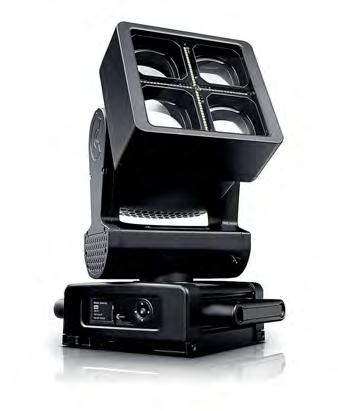
access to tools and video features, it is complementary to Avolites’ Ai specialist media application. Primary features include multiple layers, preview window, live inputs (capture cards and webcams) and NDI inputs. An updated UI includes bank table and thumbnail views, adding surface and output pages, and cross-fade on layer. Updated Synergy control includes adding and removing layers, while secondary features include speed control on layer, added virtual returns and hardware decode for H.264/H.265. The company plans to fully release Prism One later this year.
www.avolites.com
in any position and any location, both indoors and outdoors. Its ability to accept most static lights – not only from Claypaky’s portfolio but also from other brands – is said to make it a flexible and inclusive solution for lighting designers.
www.claypaky.it
July–August 2024 WORSHIP AVL 57 PRODUCTS
Strike Array 4C
Diamond 7
Volero Cube
Tuning in to the community
Aimed at worship leaders and lead pastors, Jason Squires uses The Table podcast to connect church communities and help them with their ministry


WORSHIP LEADER AND PODCAST
producer Jason Squires launched The Table podcast in 2022 as a space for worship leaders and people in the church community to sit around “the table” and share their ideas and thoughts, ranging from philosophical questions about identity to conversations around worship technology.
California-based Squires began his journey as a worship leader over 18 years ago and he now travels around the US leading worship and teaching at conferences, as well as producing his podcast The Table which he established through his organisation The Creative Launch. Throughout his time as a worship leader, Squires notes that the more people he met, the more he saw the need for a space for people in the church community to talk and share ideas. “It started as leading worship teaching at conferences, to putting on our own conferences where we met more people, which gave us a deeper understanding for the need for coaching,” he says.
After the pandemic and coinciding with the growing prevalence of Zoom
and online communications, Squires initially launched The Table podcast as a hobby, but soon it began to gain a following and turned into something much larger. “I always wanted to do a podcast and it started as a passion project for me because I love resourcing worship leaders and worship teams, but then the conversations that we were having were sparking more conversations,” he notes. “I would go around and teach at conferences and people would come up to me saying ‘hey, I love your podcast, keep going’. Honestly, I was going to stop it after season one because it was a lot of work, but then I realised people were listening.”
When asked how things have changed in churches since the pandemic and the growing necessity to keep up with technology, Squires reflects on a recent conversation he had with a lead pastor who called him to assist with licensing music online. “He was asking why his feed had been shut down on Facebook and, ironically, one of the episodes from
season one of The Table was with someone from The Church Copyright Licence who knows all the answers to that question,” notes Squires. “So, I showed him the episode and told him it will answer a lot of his questions.”
Available on Spotify, Apple, Pandora and other streaming platforms, The Table delves into one topic over four episodes, with each one inviting a different guest to give their unique perspective. “I try to get different types of people such as lead pastors and worship pastors, but then also artists, speakers, authors or people in the business community speaking on the topic,” adds Squires. “That way when you listen from one to the next, somebody else is coming from a different angle and you get a wellrounded view of the subject.”
On top of the podcast and worship coaching, Squires also advises worship leaders across the country which is where he gets much of his inspiration for the podcast. “A lot of the topics this season have come out of conversations I had last season with people that I work with,” he
podcast. Previous episodes have covered topics such as Identity as a Leader, Developing Your Inner Circle and Managing Your Time.
For season two, Squires wanted to devote attention to setups for small churches, which he believes can be isolated in the community sometimes. “I have done a lot of small churches, and you don’t necessarily realise that there’s a network around,” he says. “What we’re trying to do with the podcast is bring that network in so they can connect from their desk with 30 worship leaders to ask any questions that they might have and know that we’re going be there again next month.”
With The Table now in its third season and recently reaching the 100th episode featuring Christian musician and worship leader Brenton Brown, Squires explains what else he has planned for the podcast: “We just started our own conference called The Worship Conference earlier this year,” he says. “We did it as a general session so that the topics are reachable for everybody in the room. Our goal is community, relationships and getting to know each other so meeting people in person is integral to that.”
www.theworshipleaderpodcast.com
58 WORSHIP AVL July–August 2024 THE TECH VIEW
Jason Squires
LIKE A PRO. TOUR
VGt features 8 transducers, amplification, a networked DSP endpoint, and Autolock rigging, all integrated into a lightweight and compact design.

COMPACT, POWER EFFICIENT, EASY TO RIG
VGt is a large-format line array enclosure, designed to deliver the highest audio quality to large audiences in arenas, stadiums, festivals, performance halls and more. VGt isn't just changing the game — it's redefining it.

adamson.ai EST.1984
VGt is a peak performance large-format line array loudspeaker and the first member in the Vergence Group, setting a new standard for high-performance audio products with seamless integration. Using our ArrayIntelligence software and the Adamson Bridge allows for a combination of VGt with any powered or rack-amplified Adamson speakers.



Xi Series l-acoustics.com
X6i
X8i











































































































































































































































































